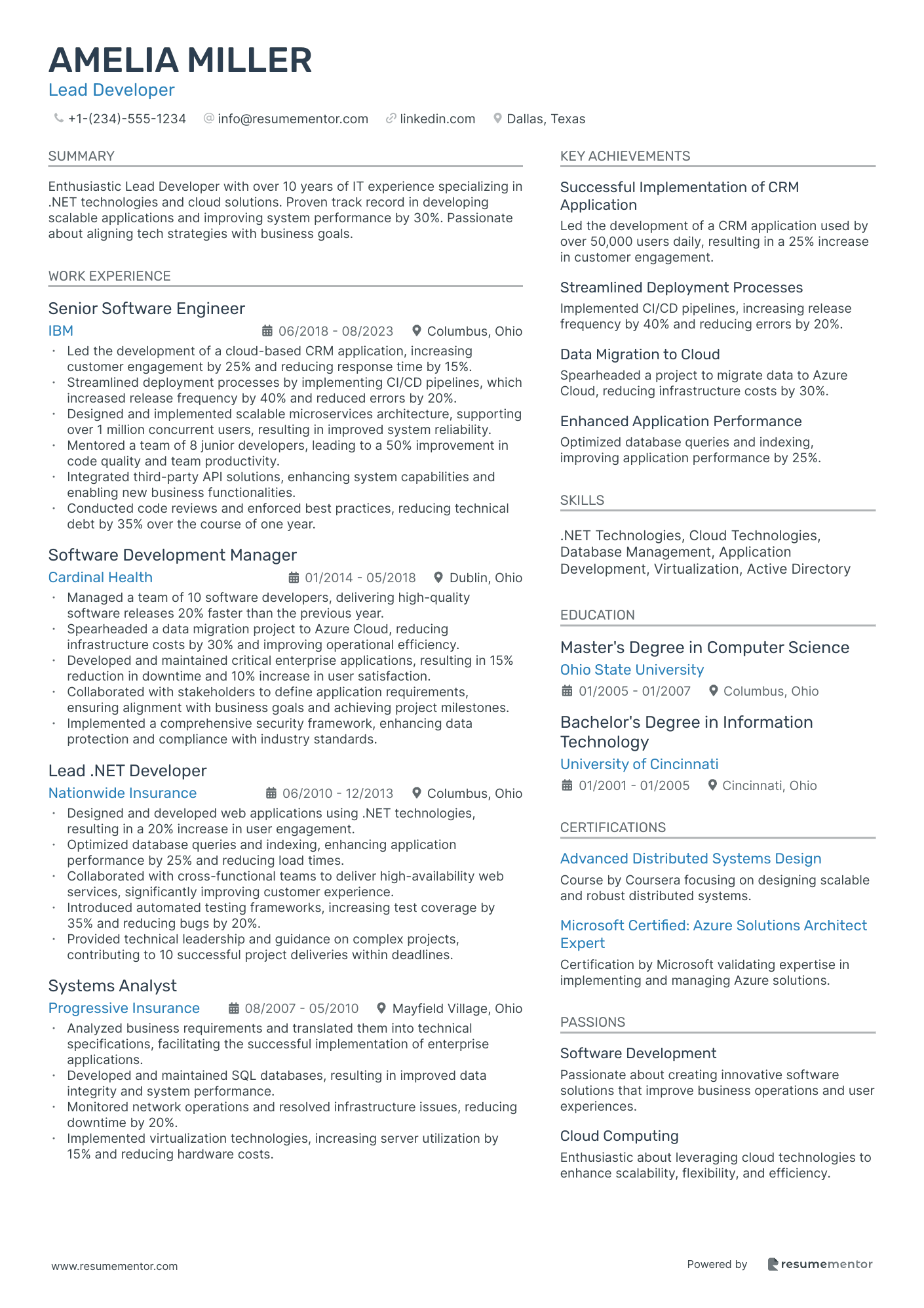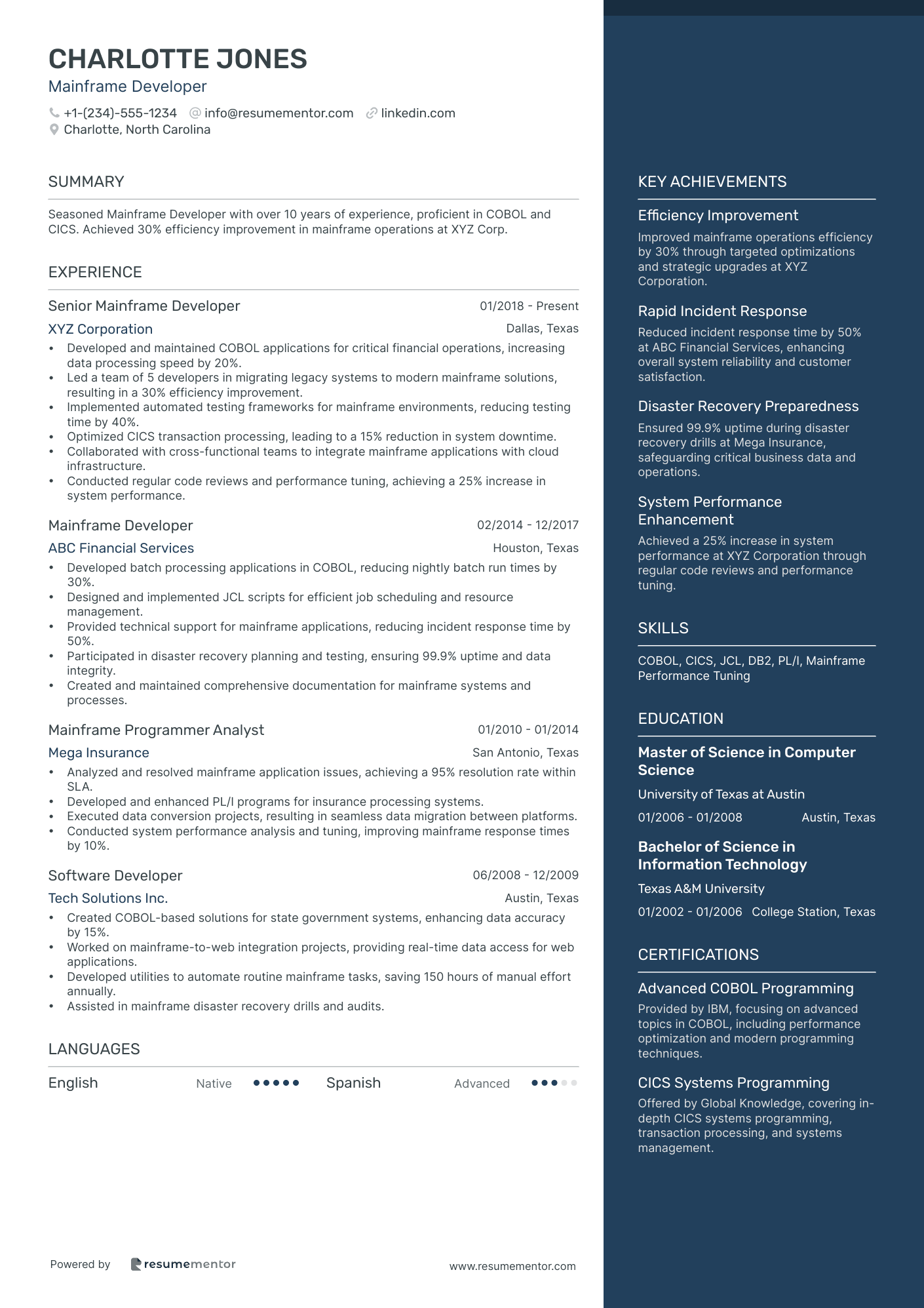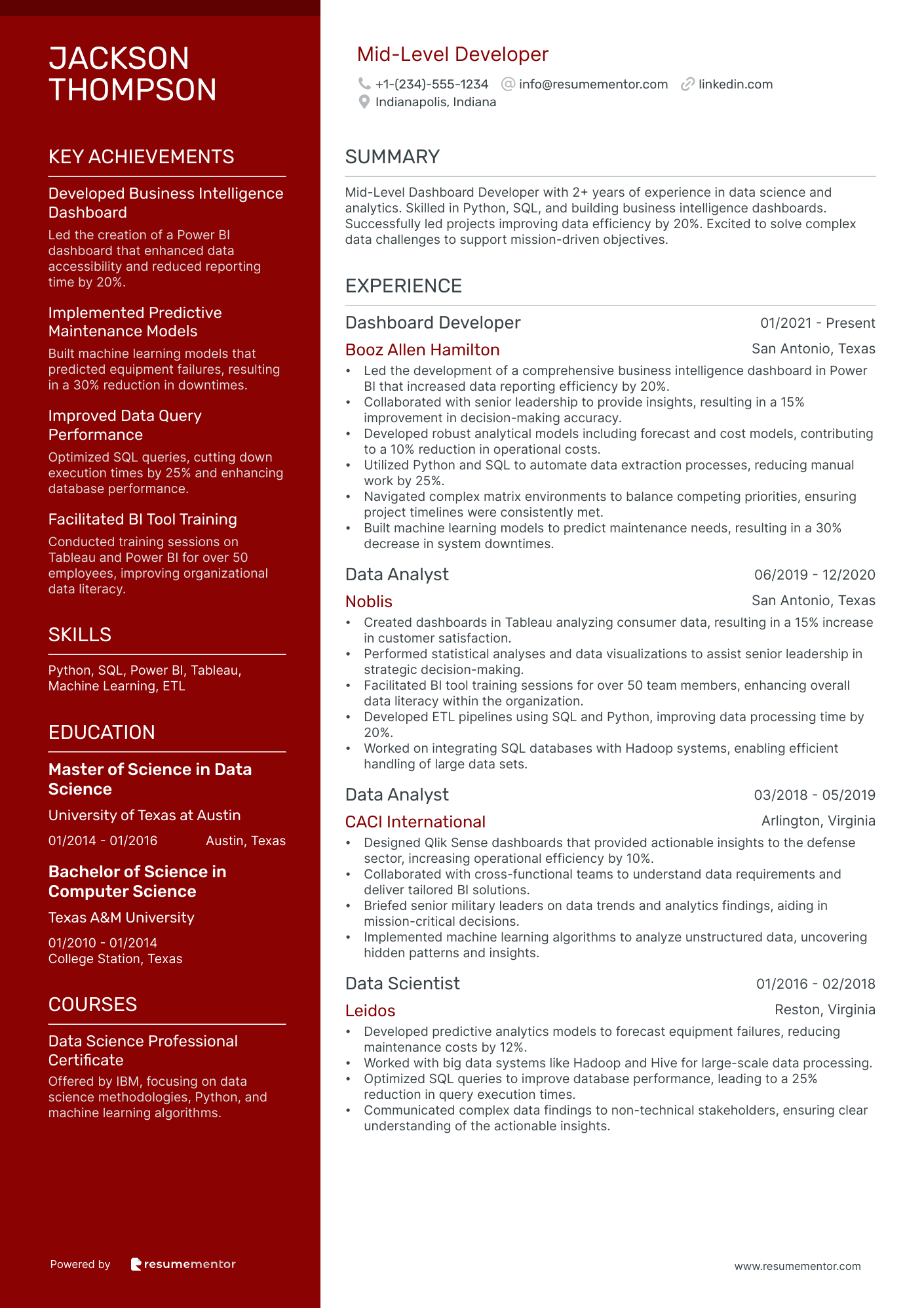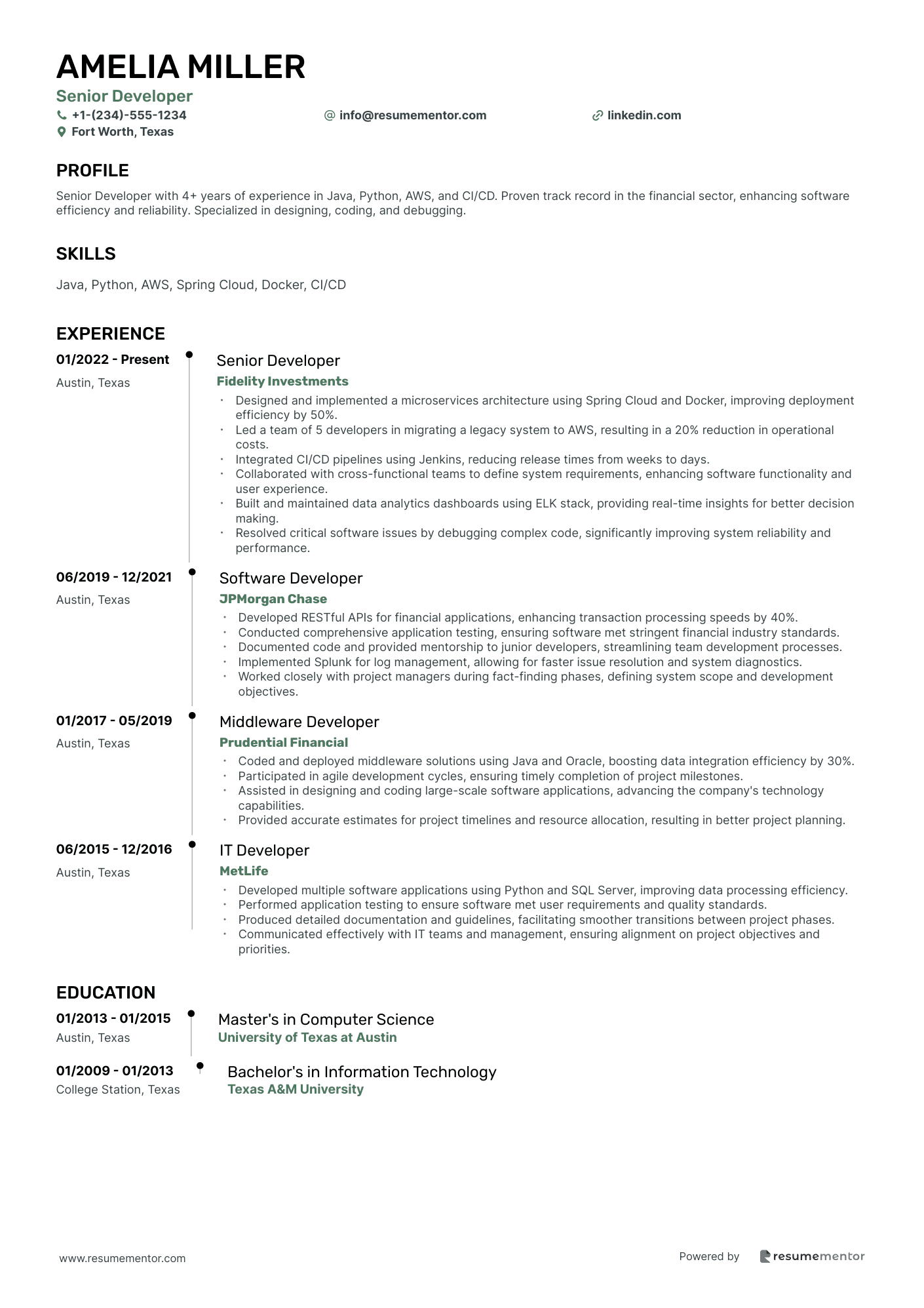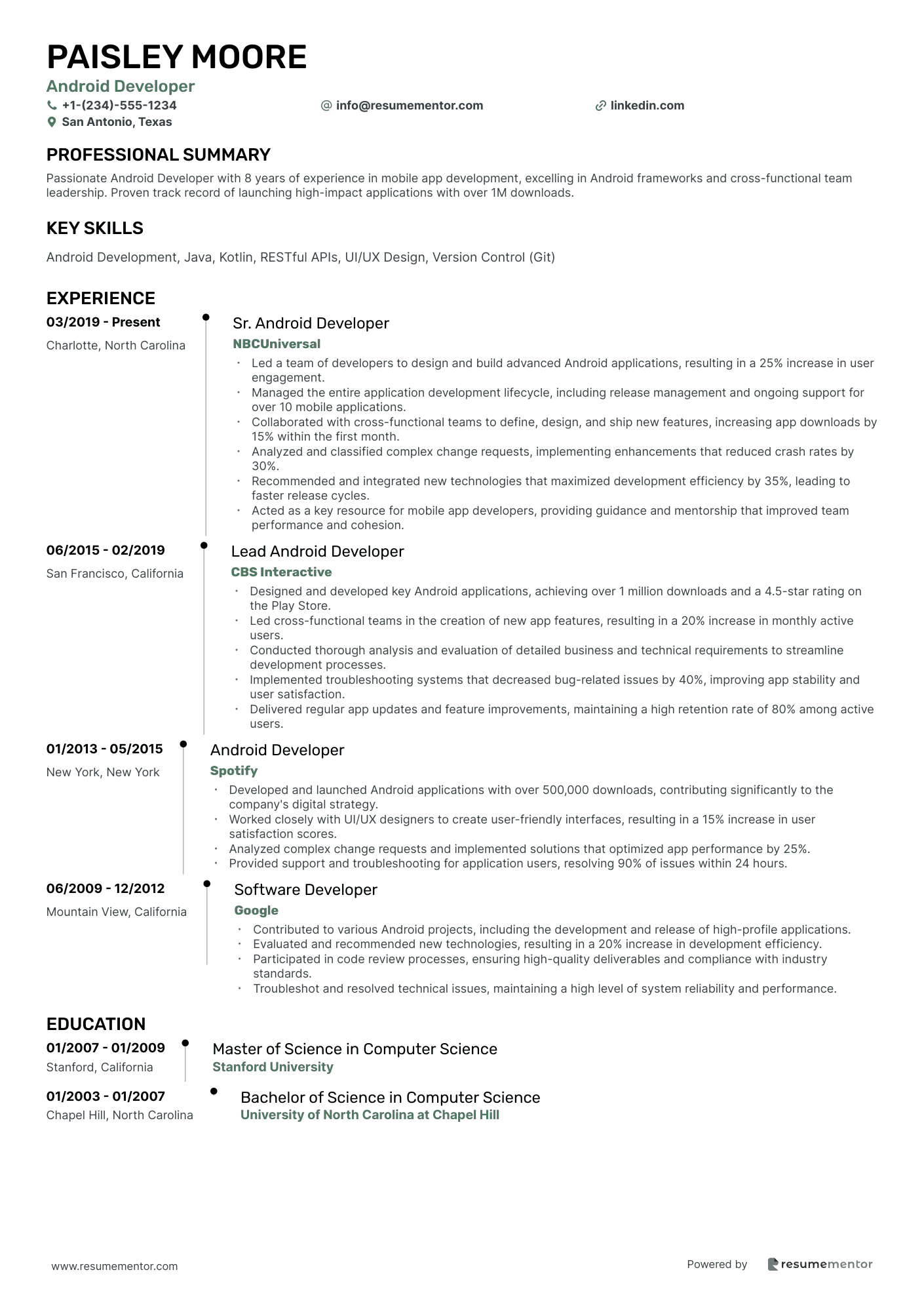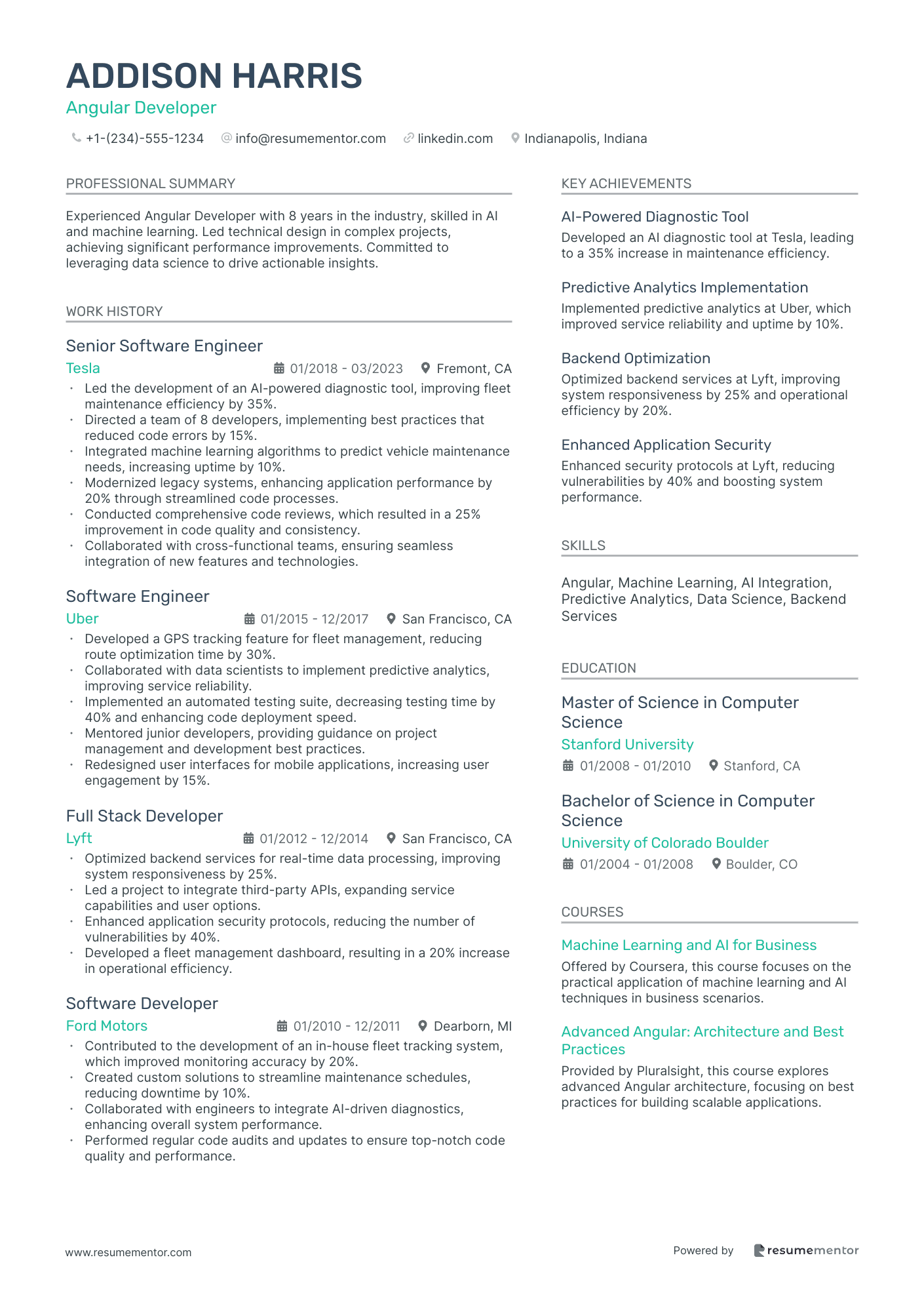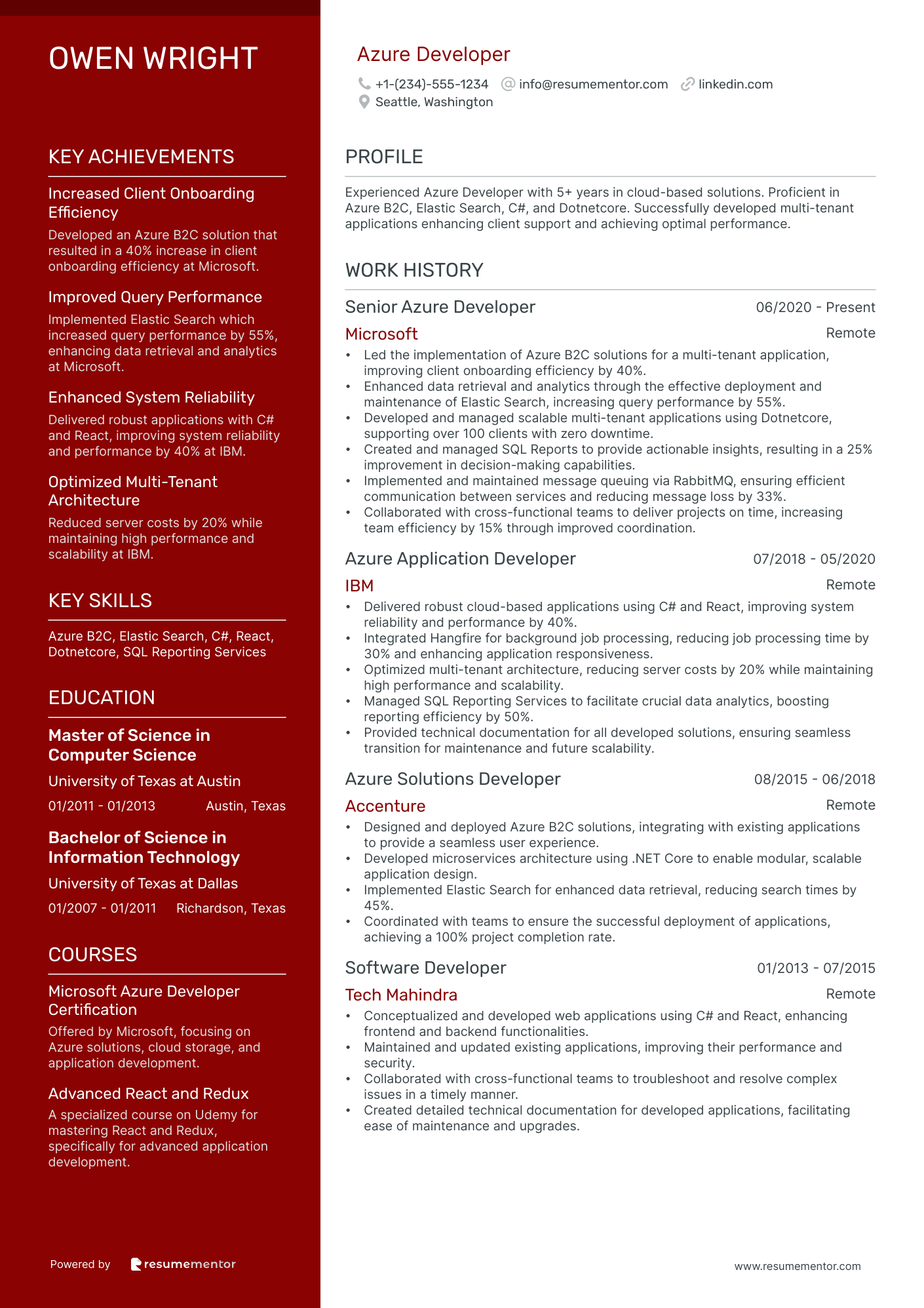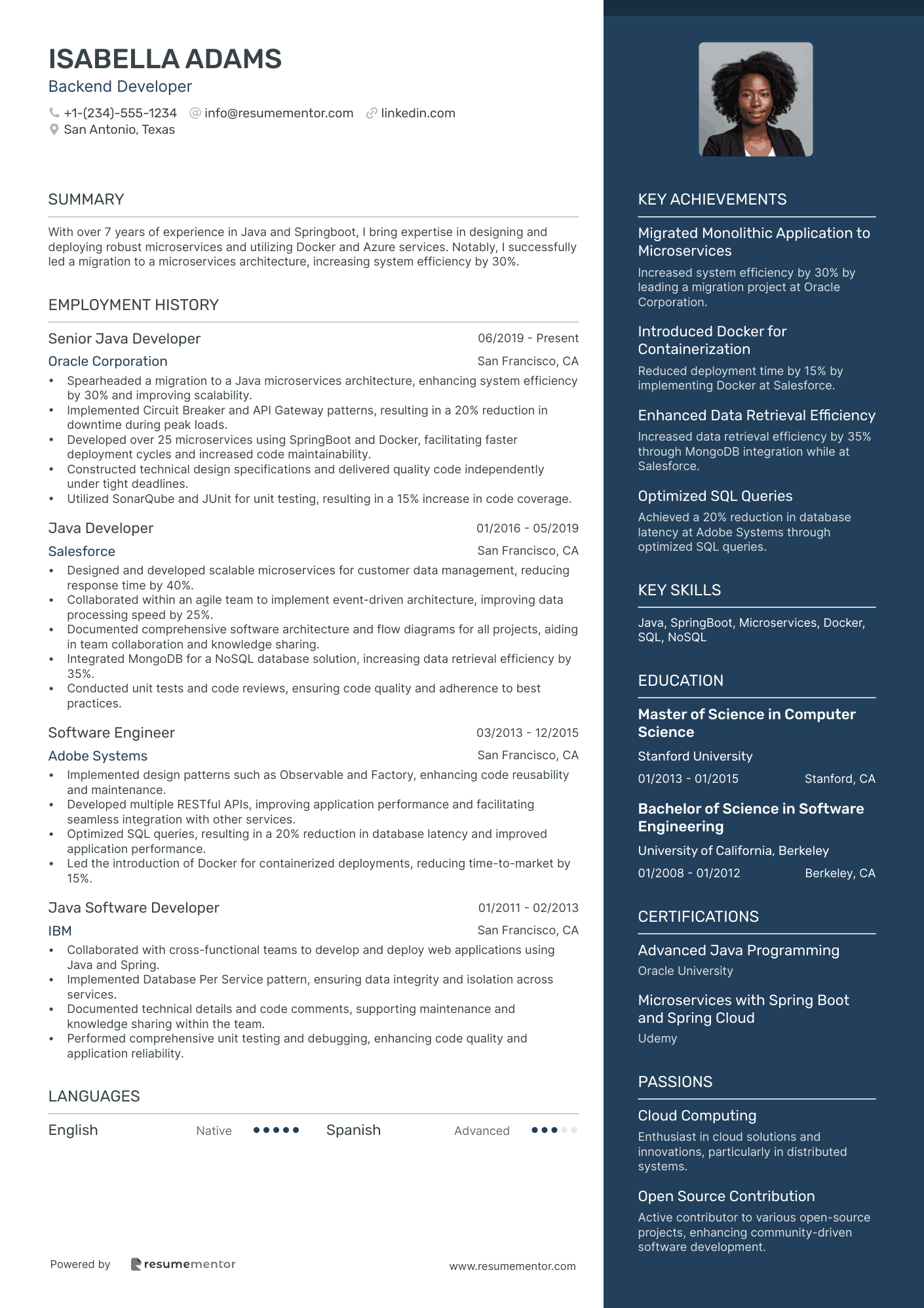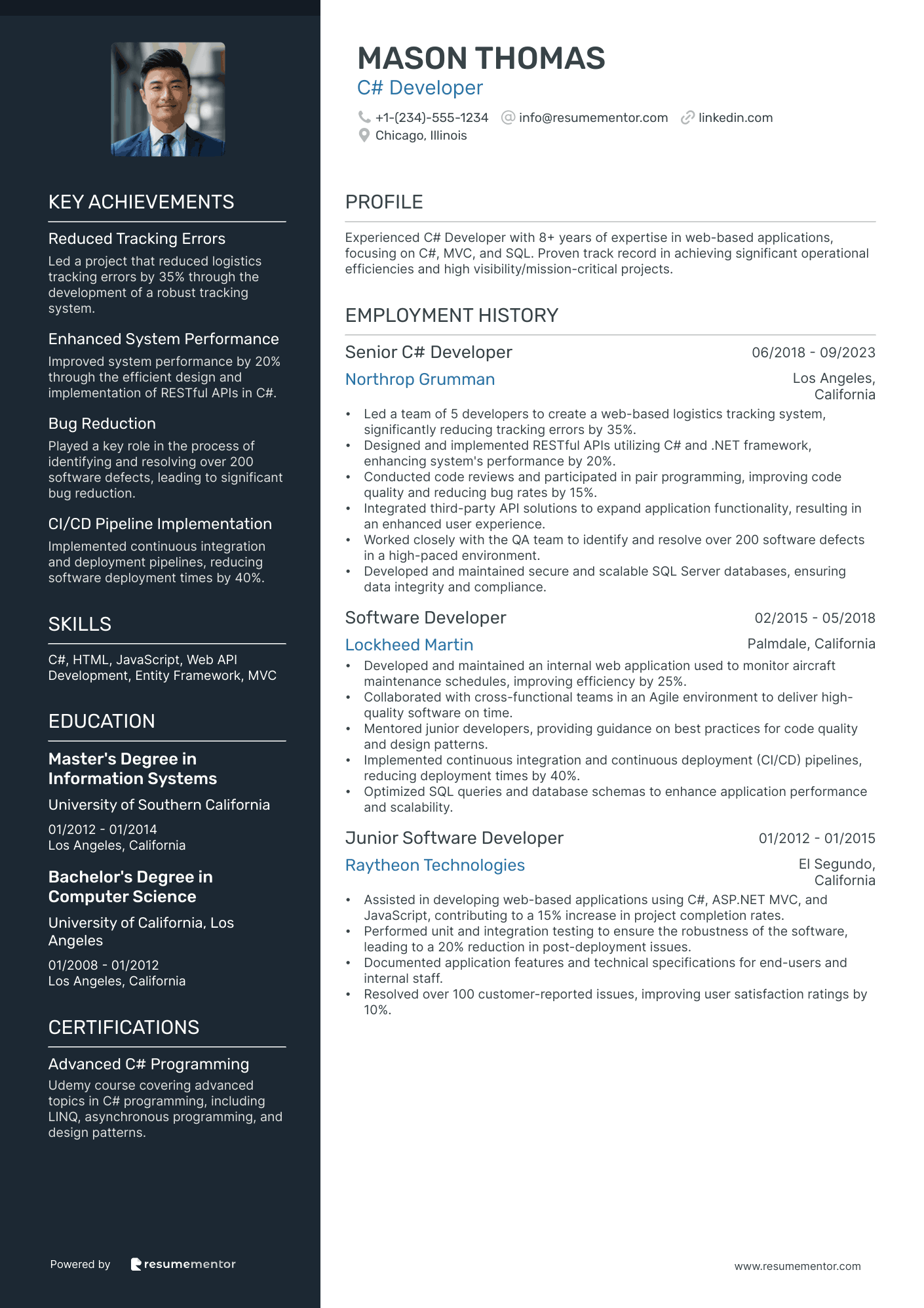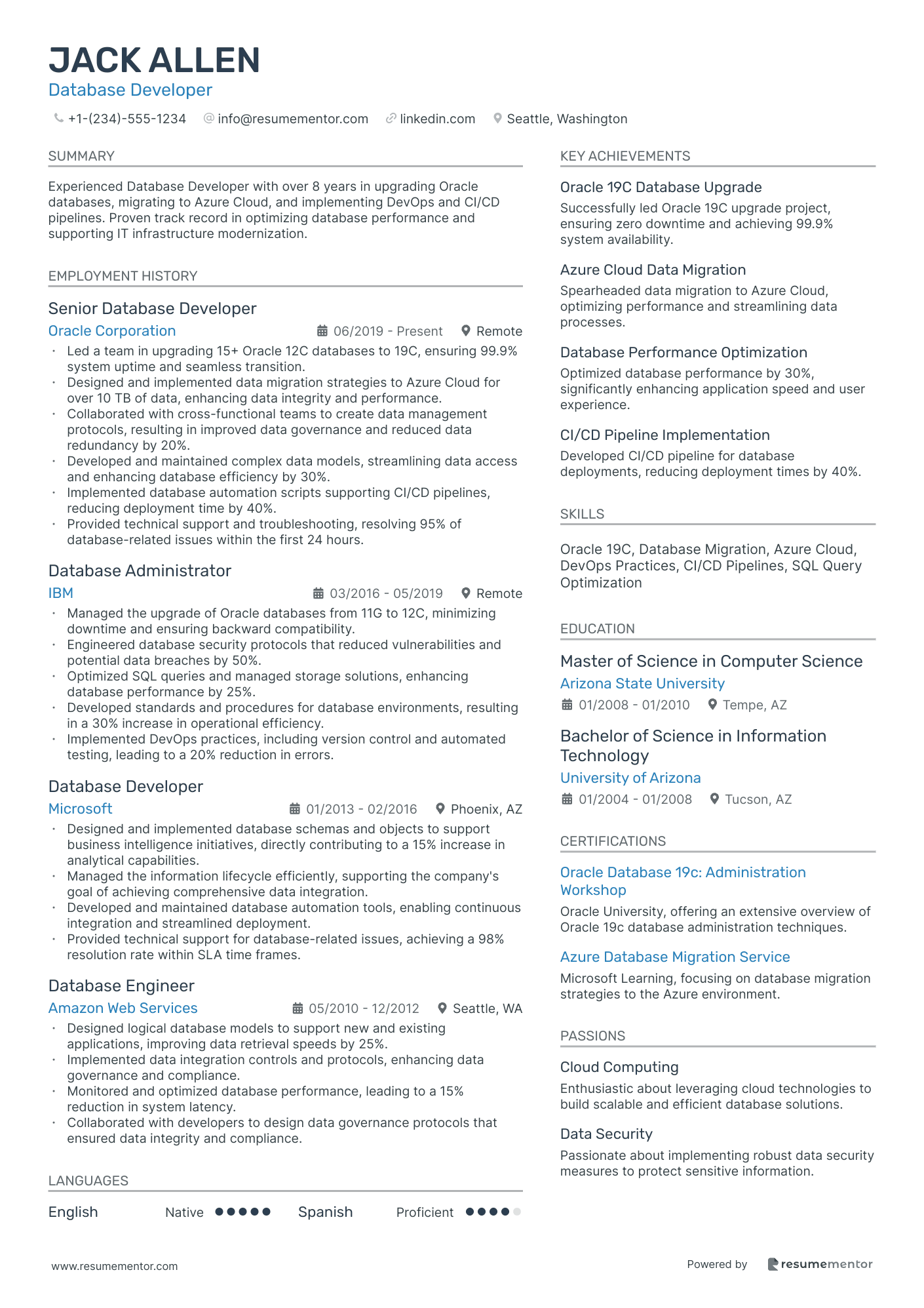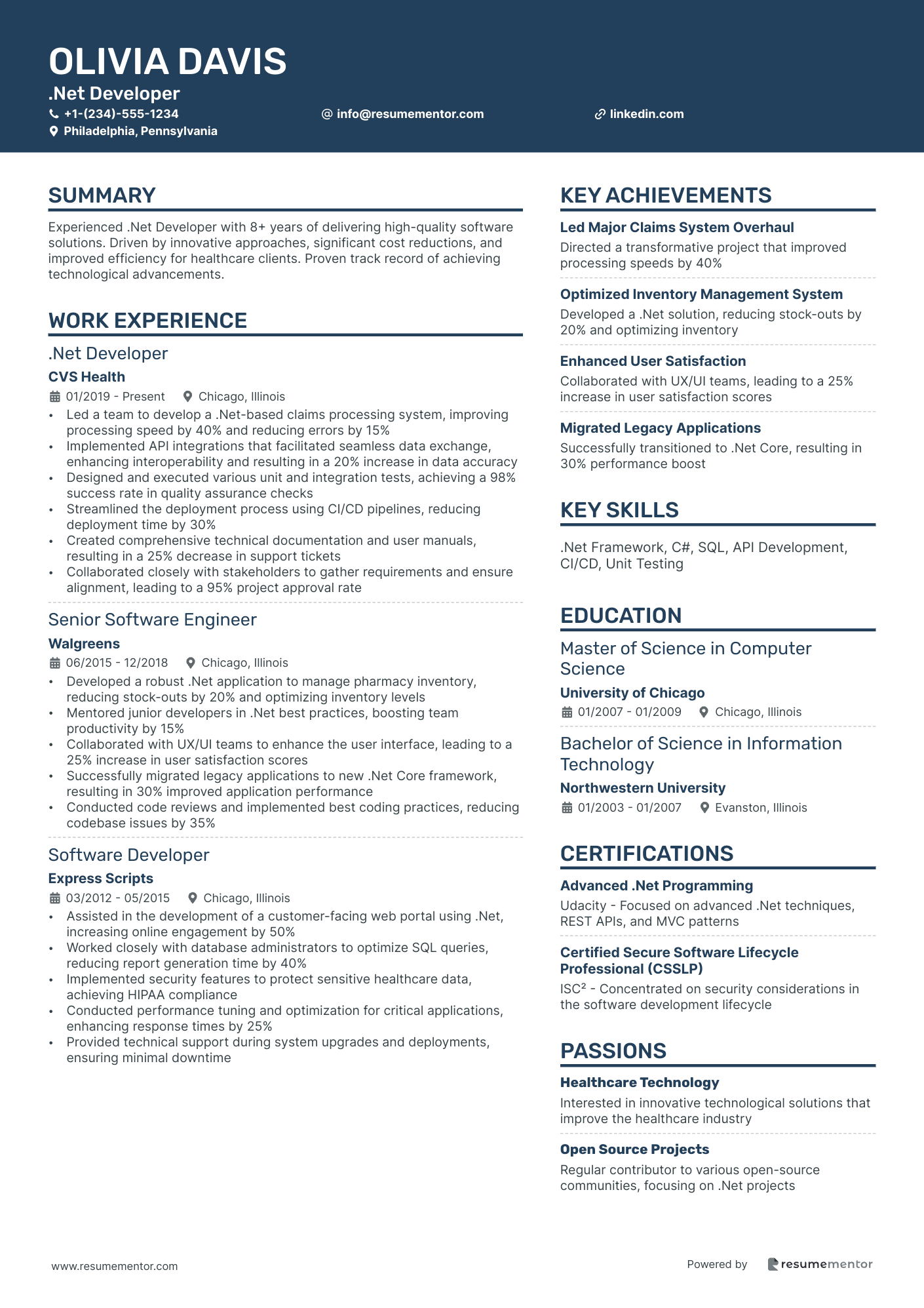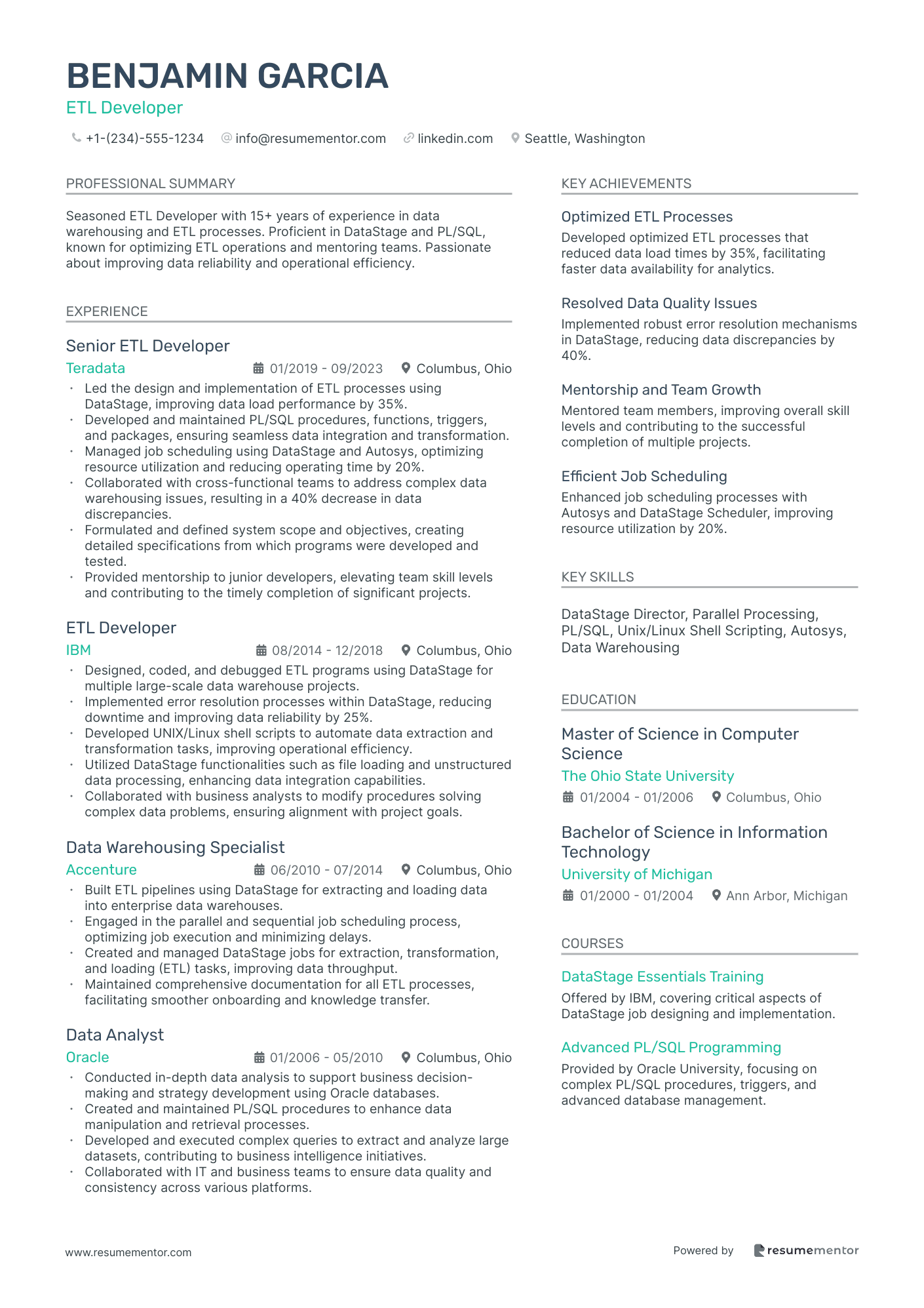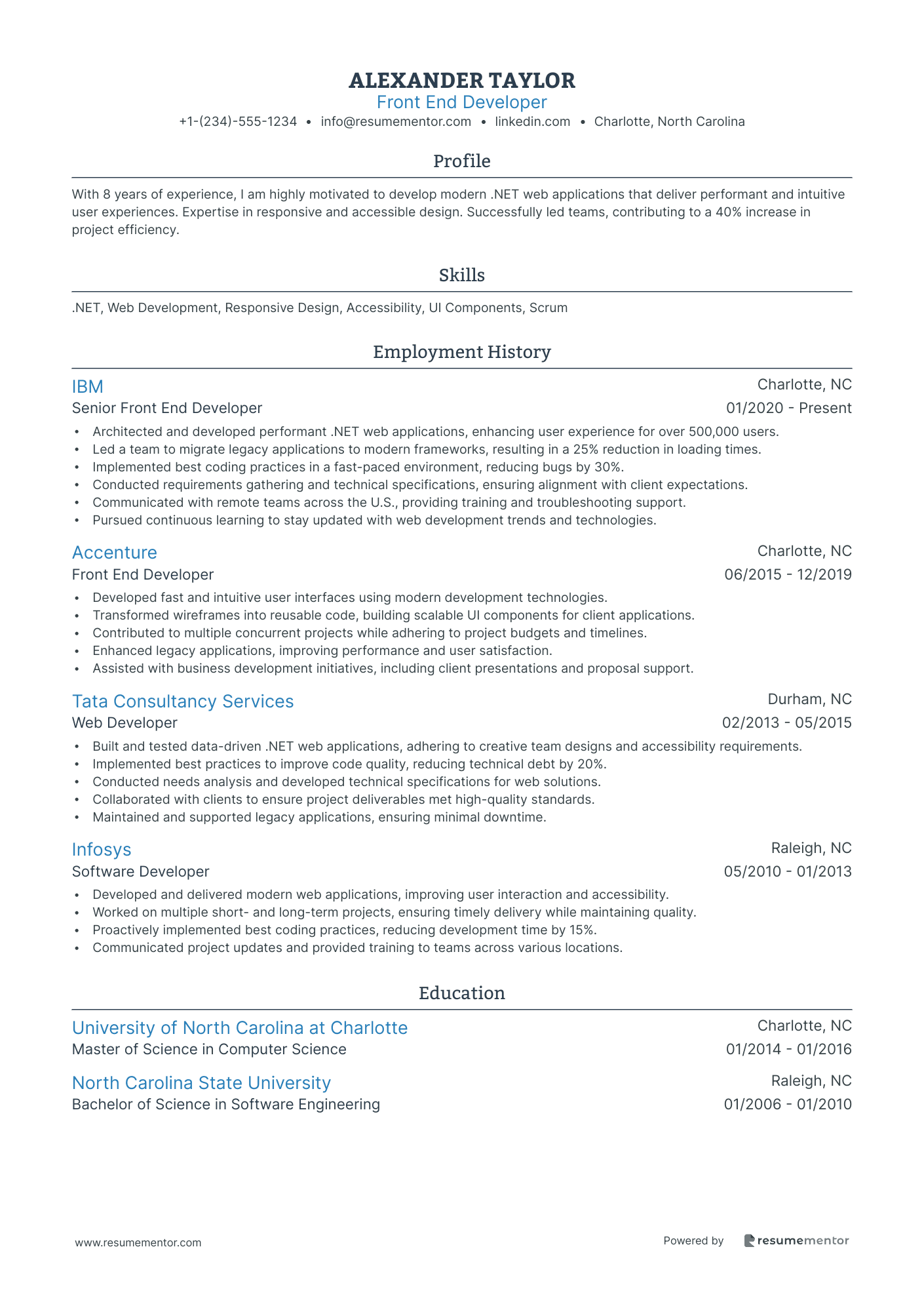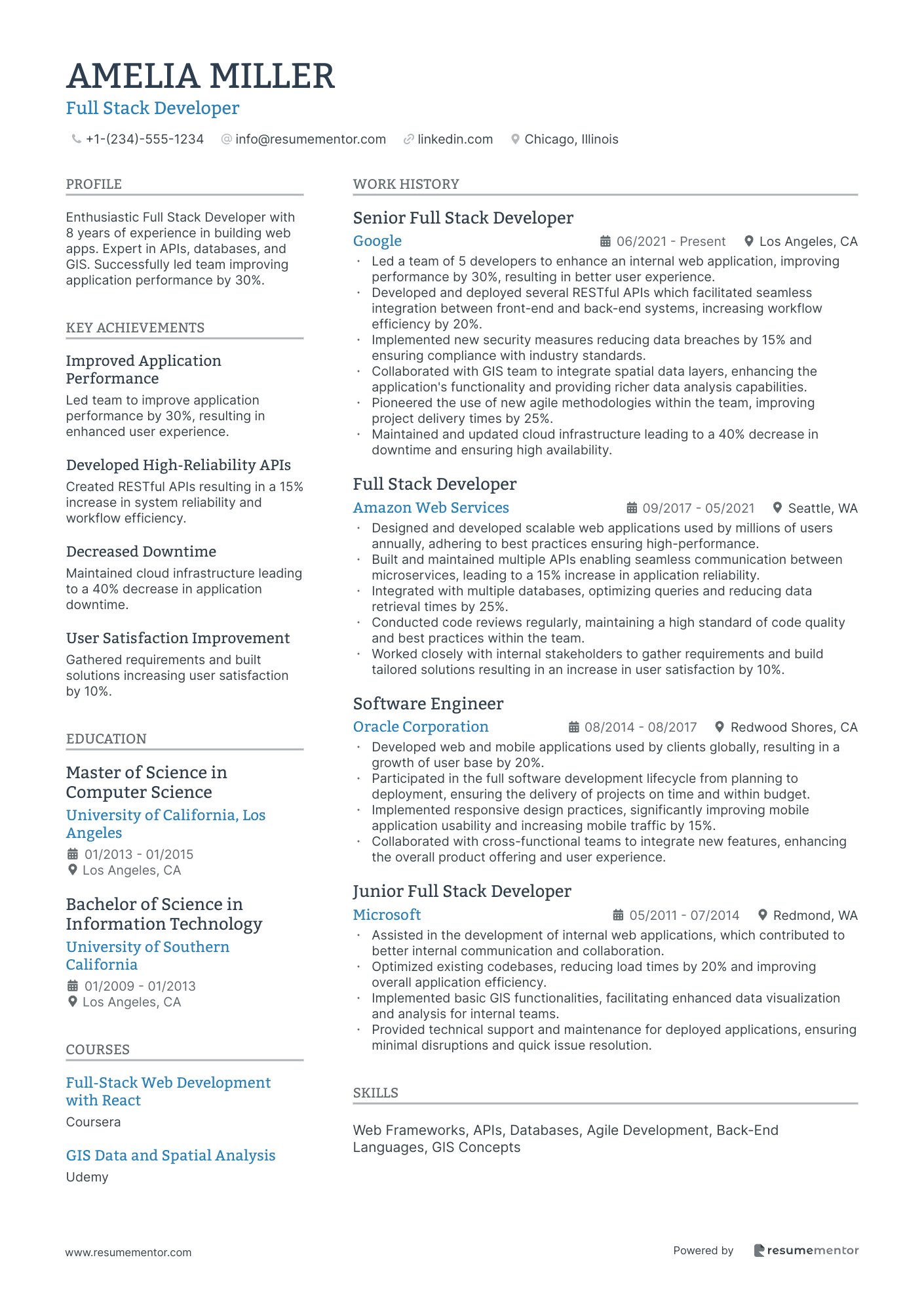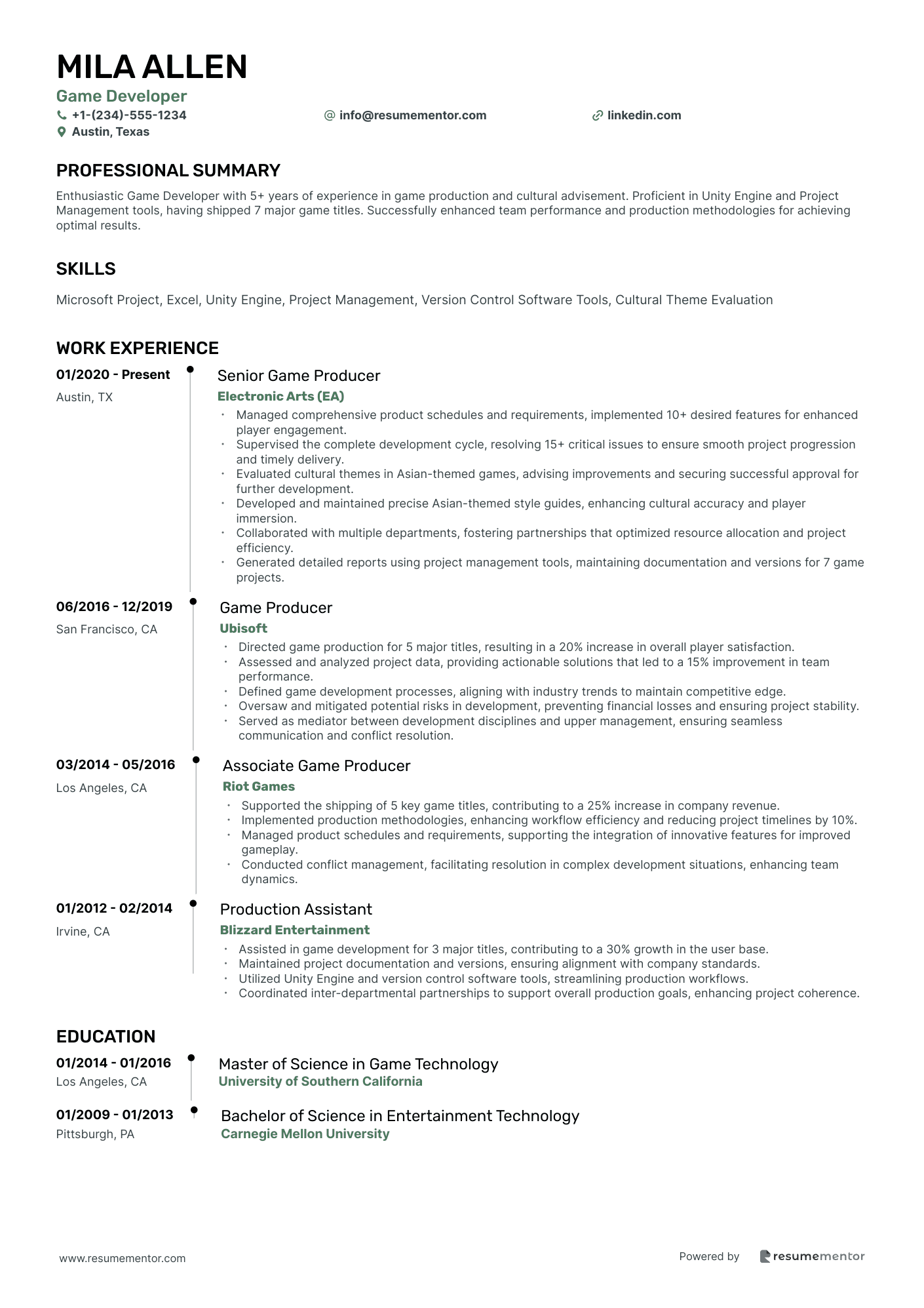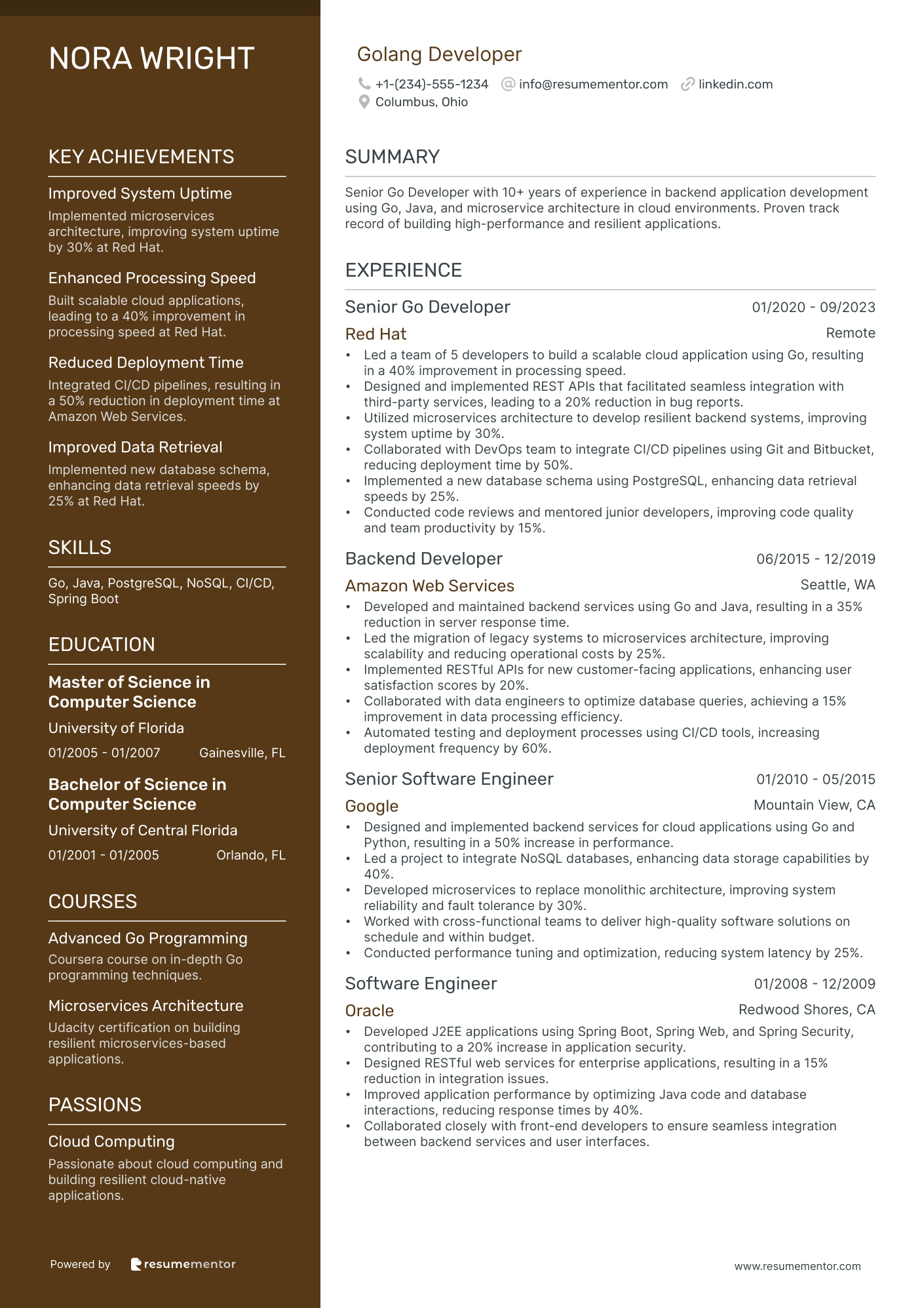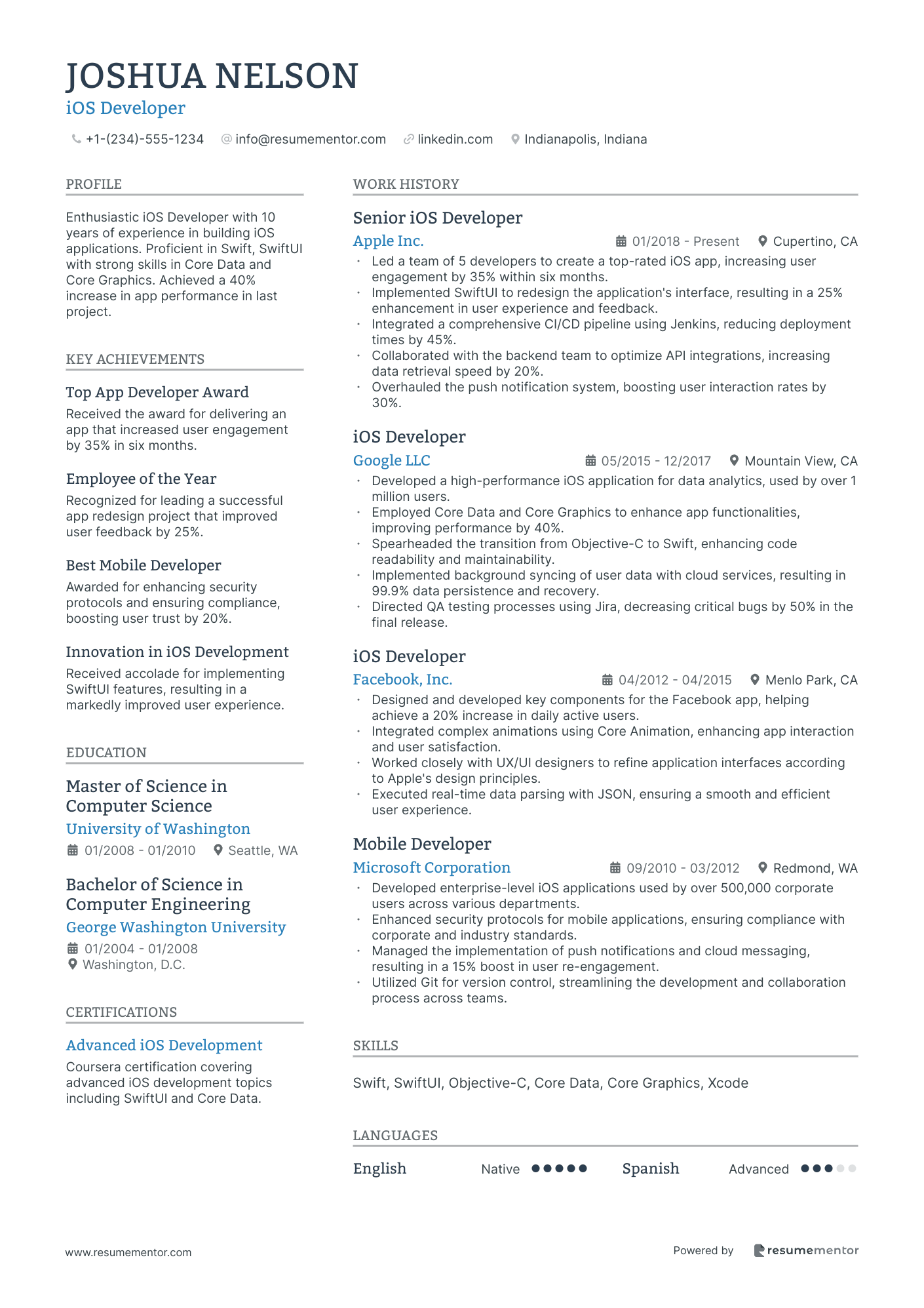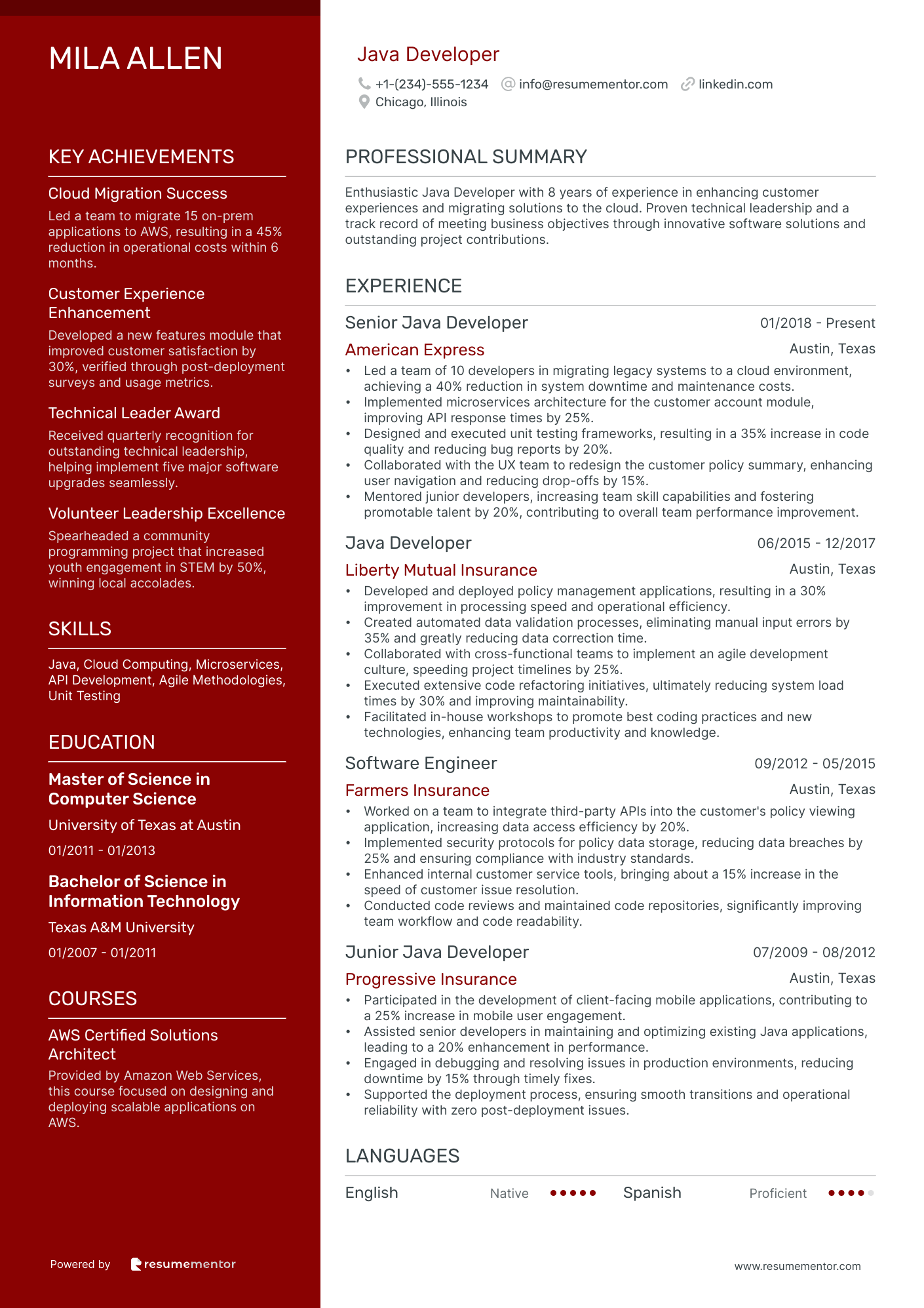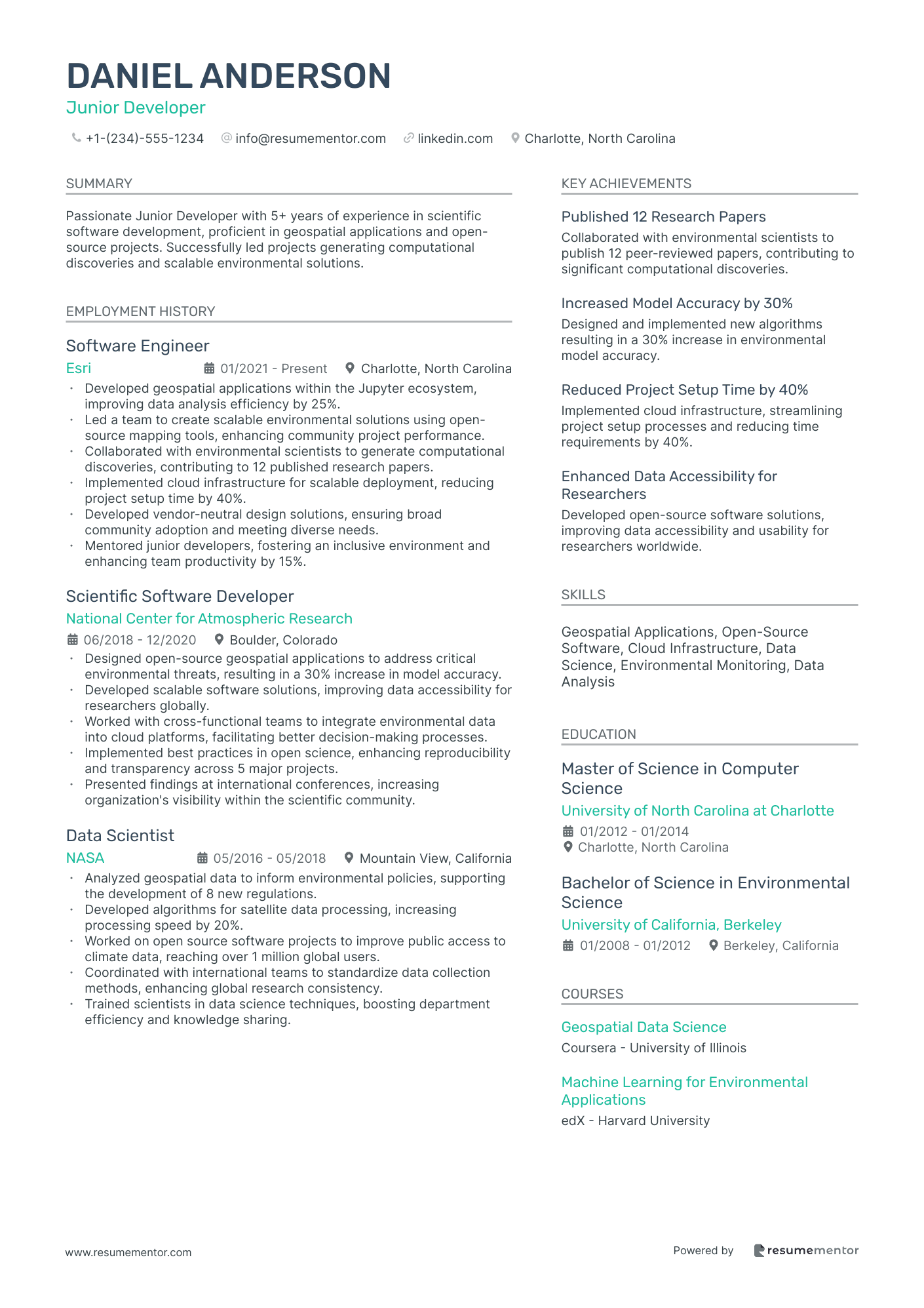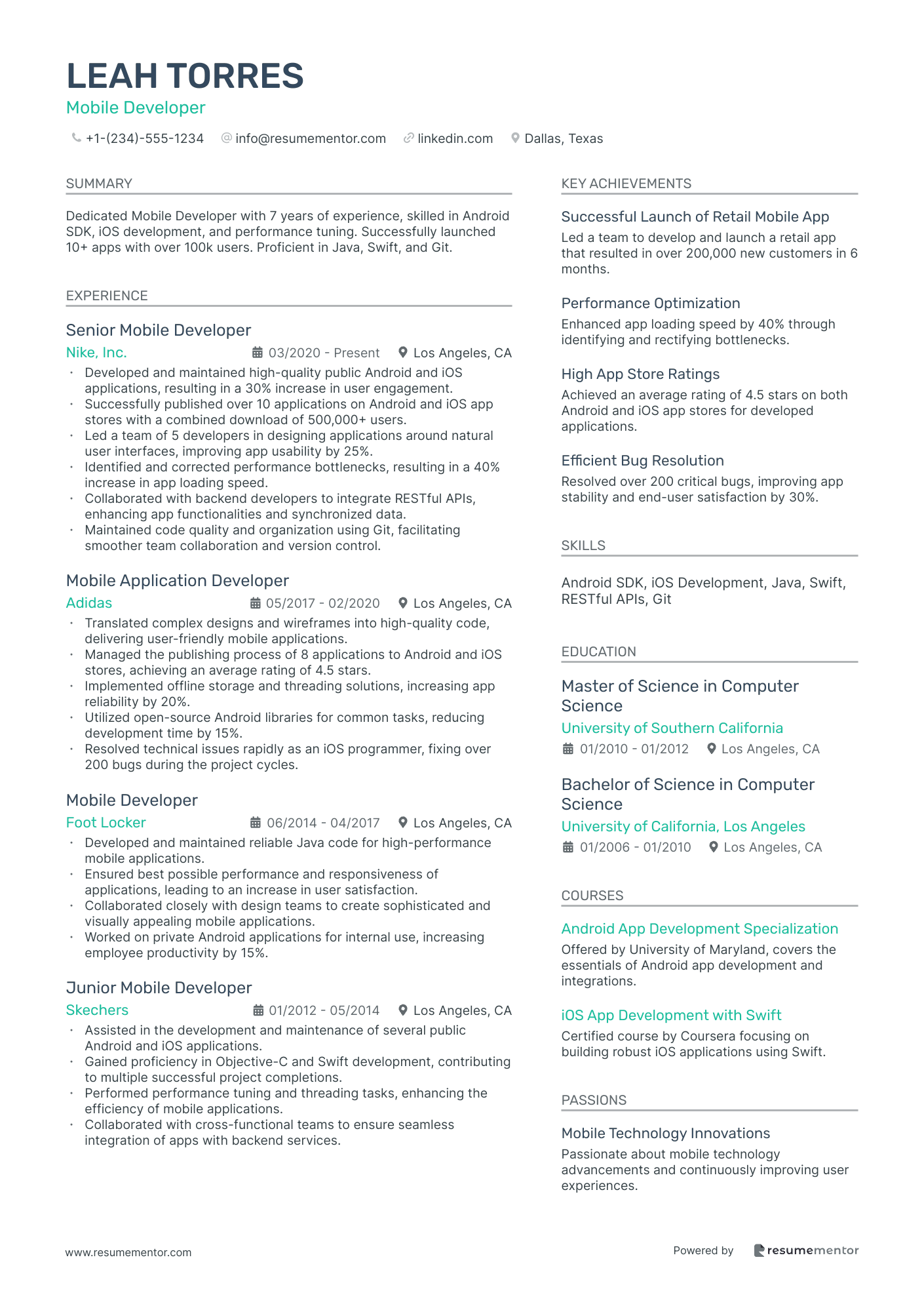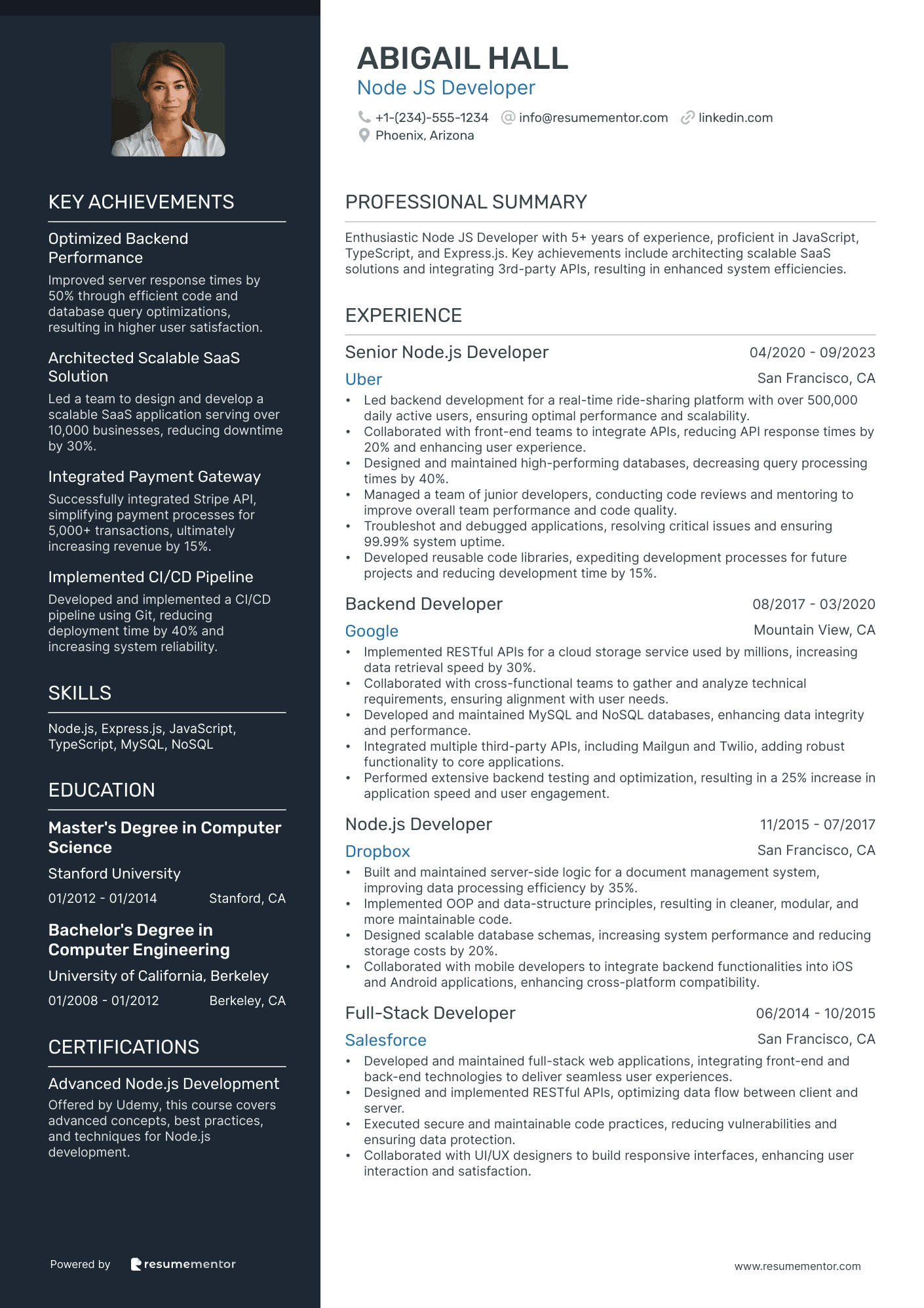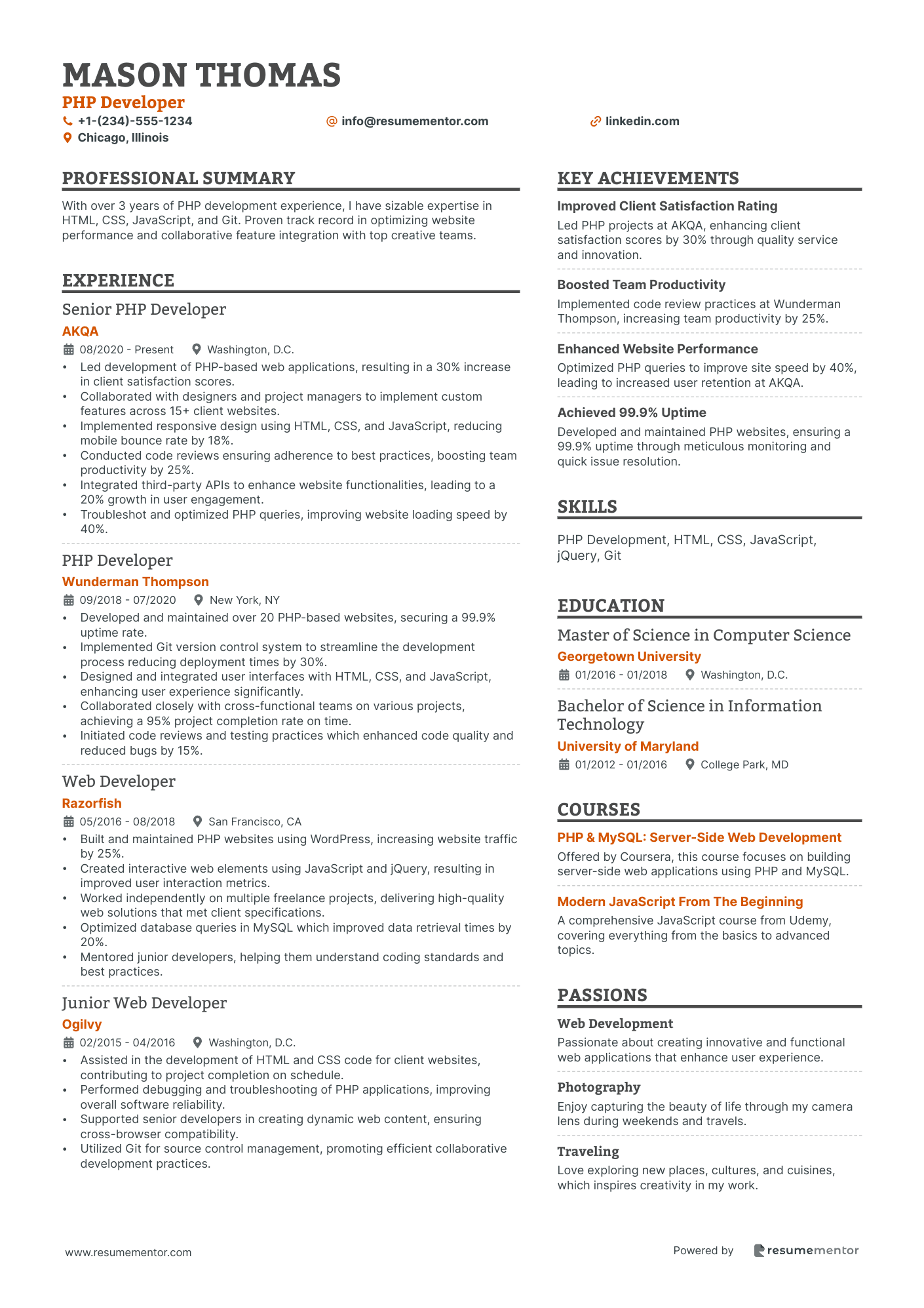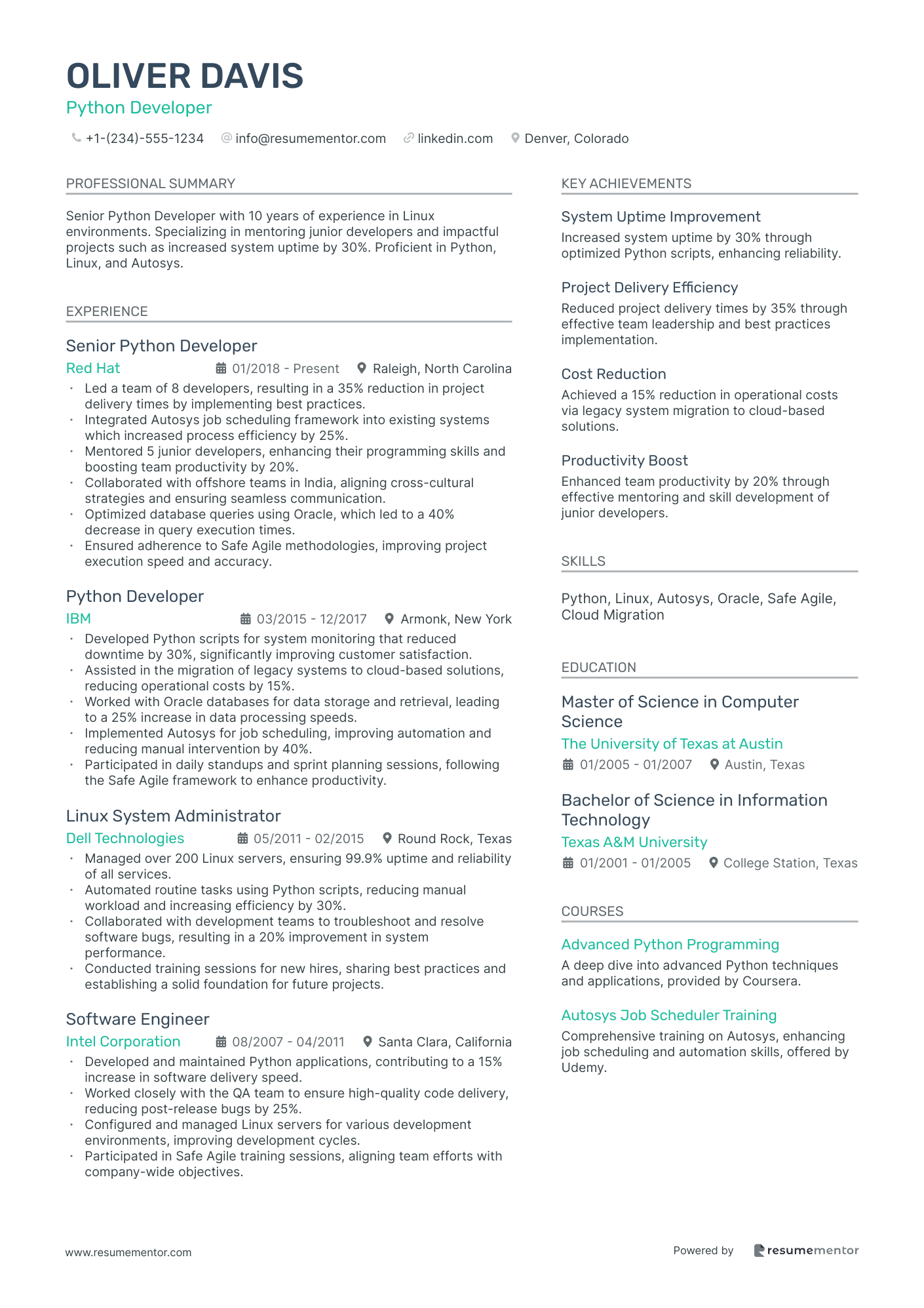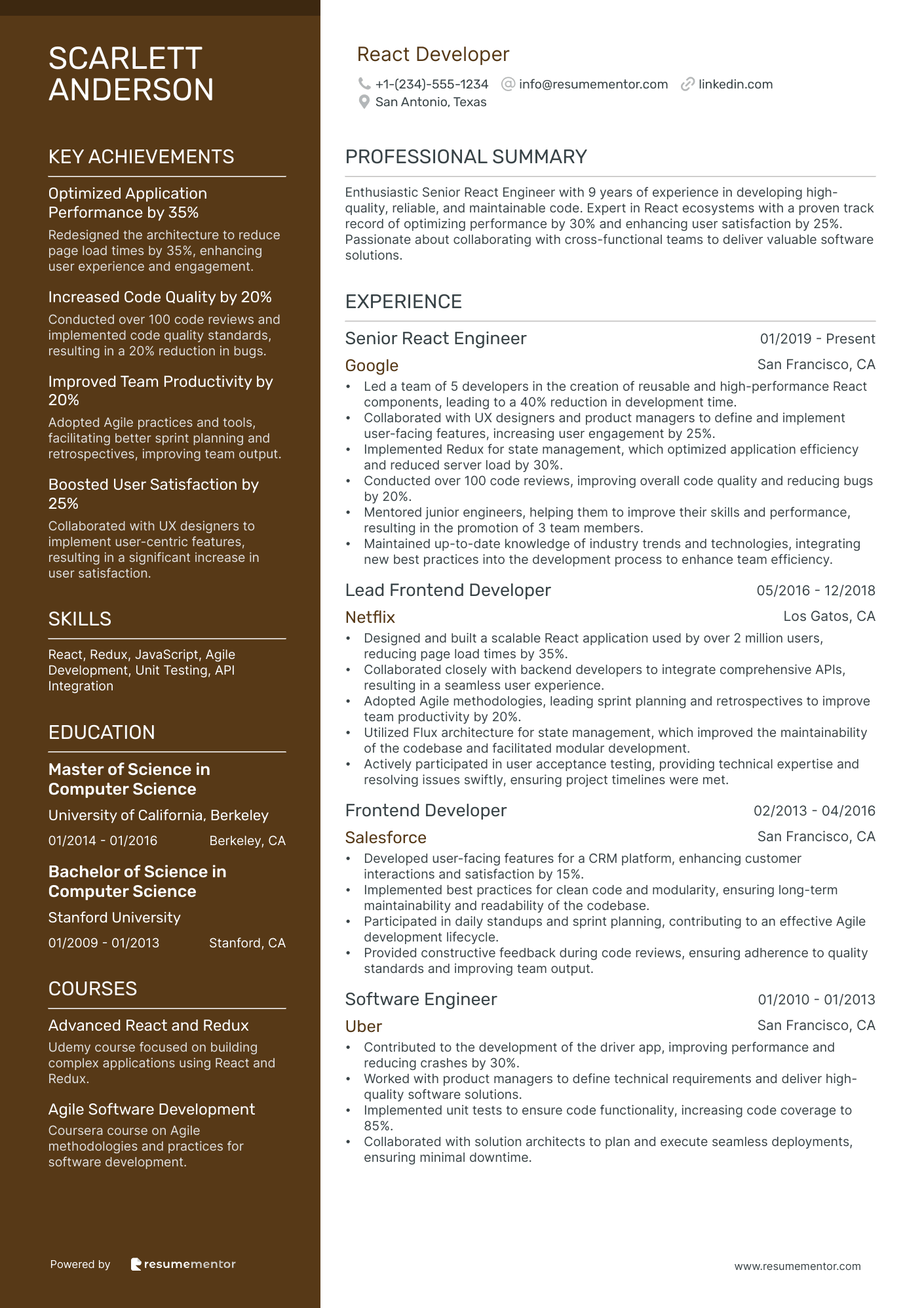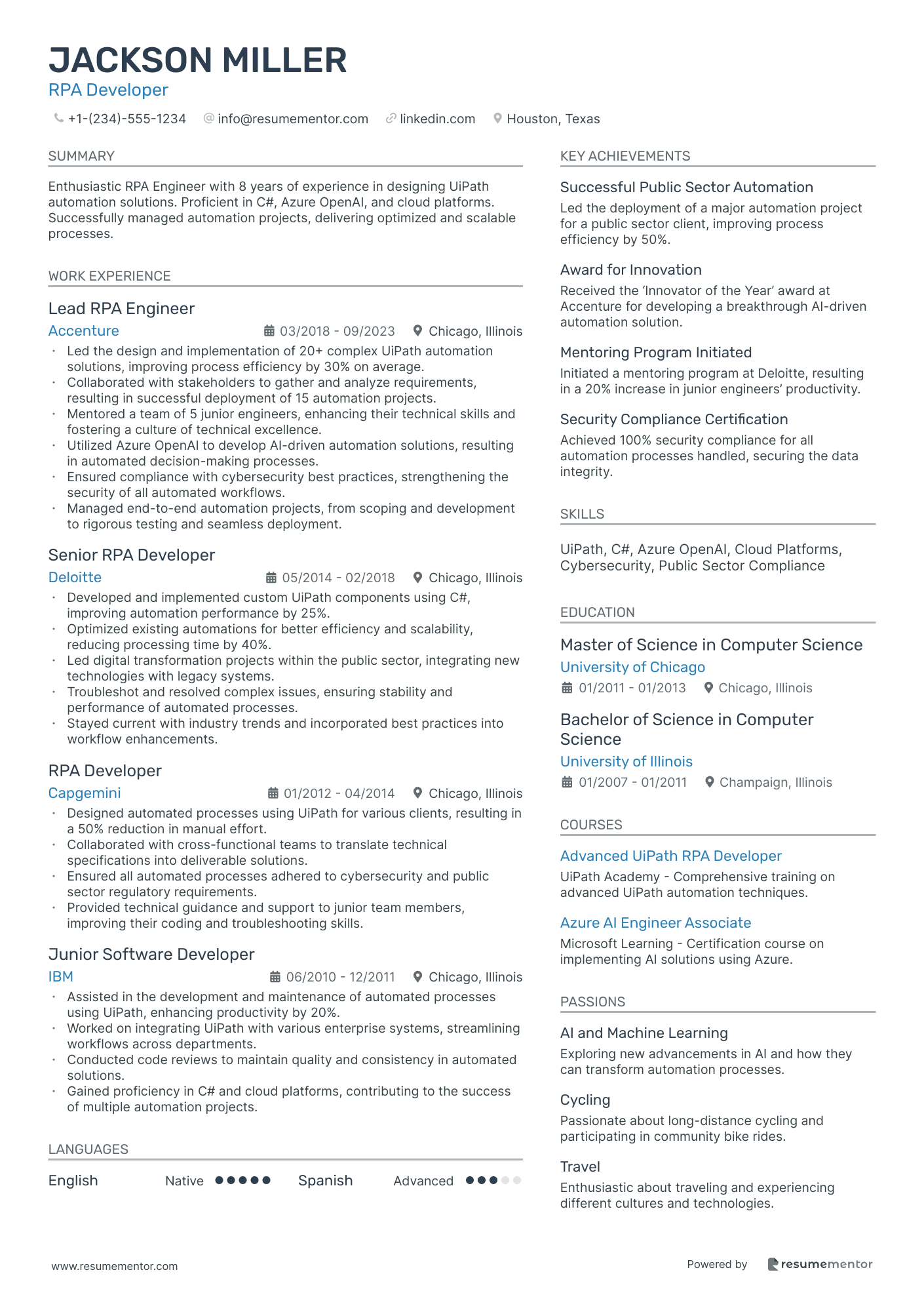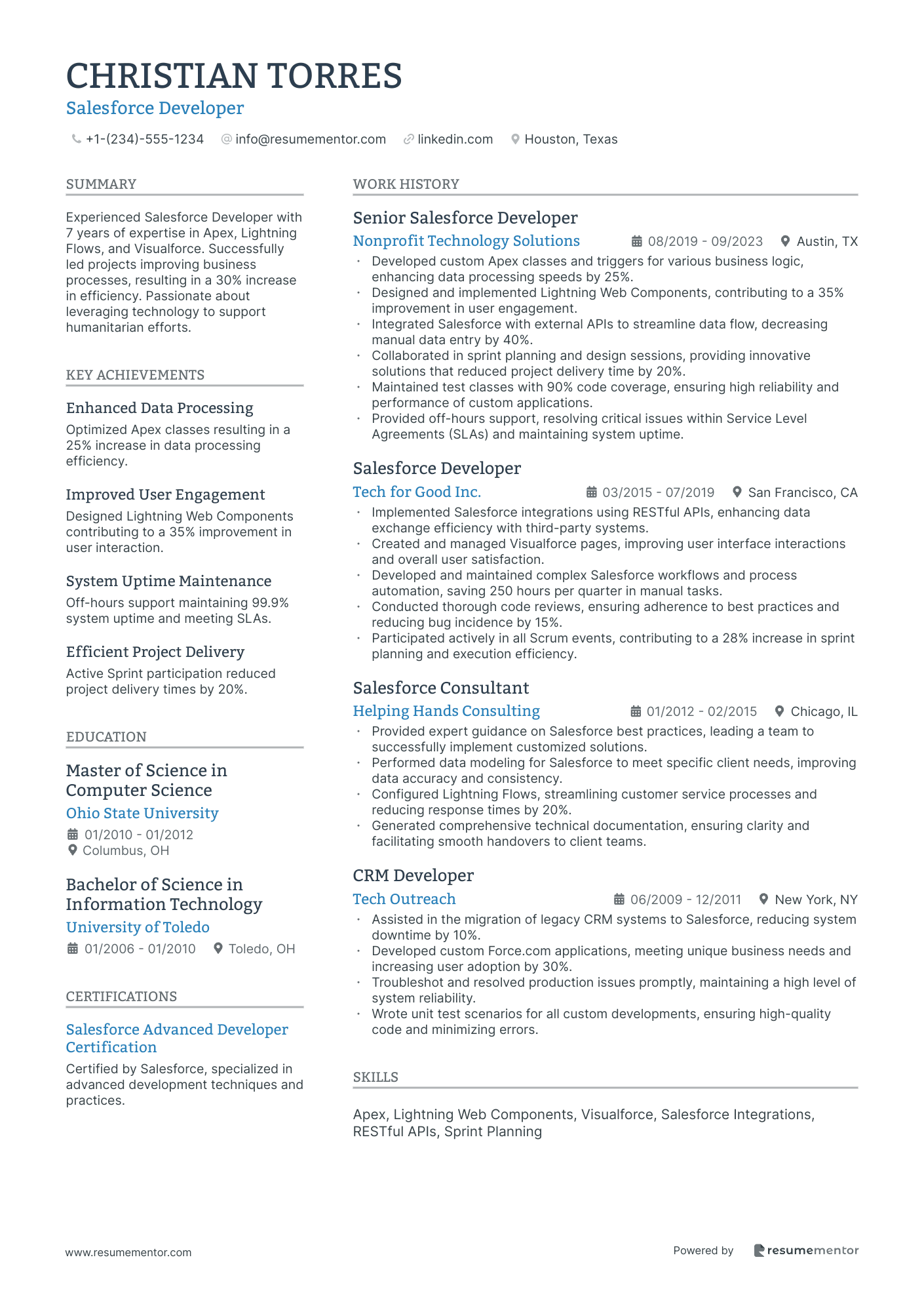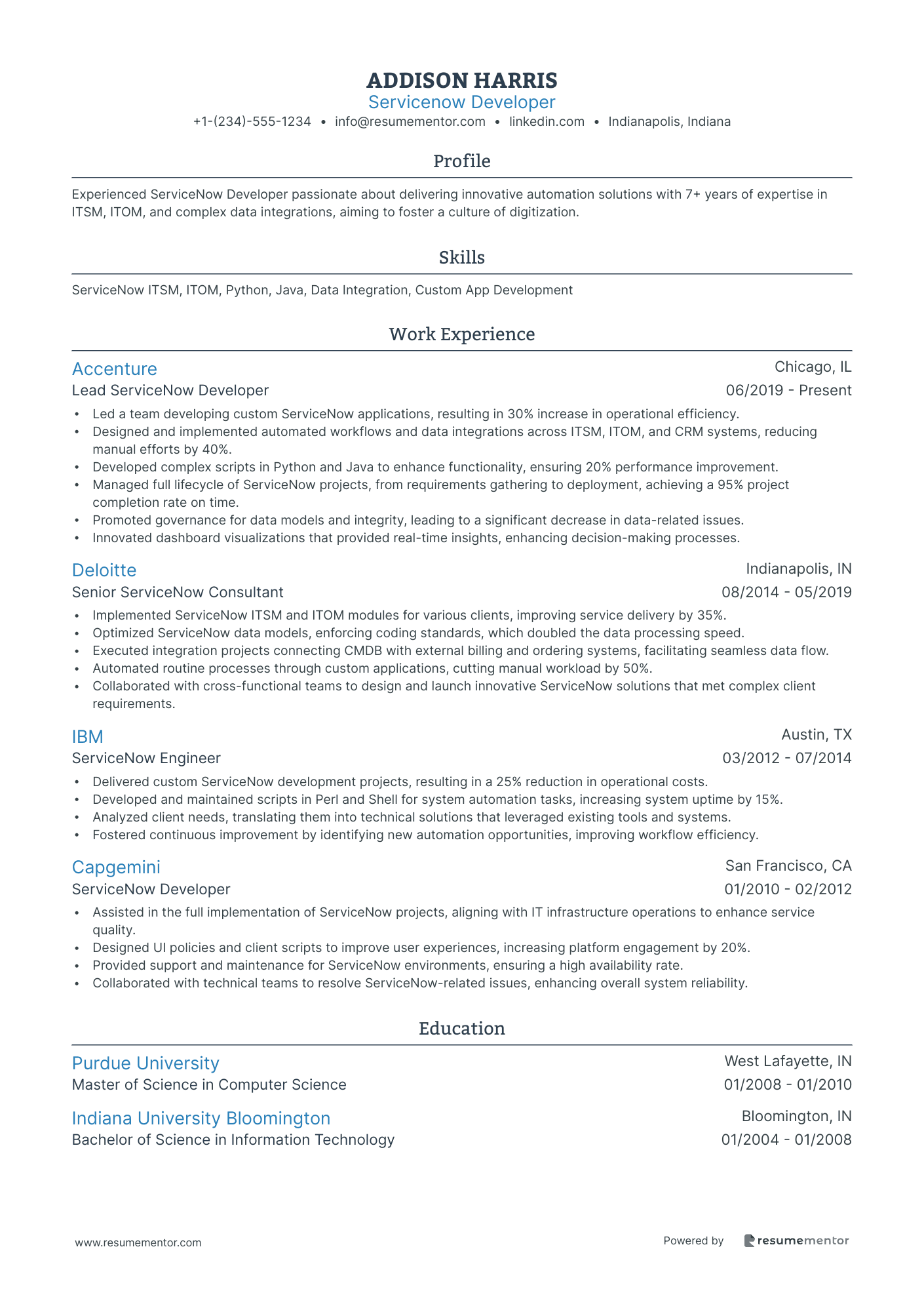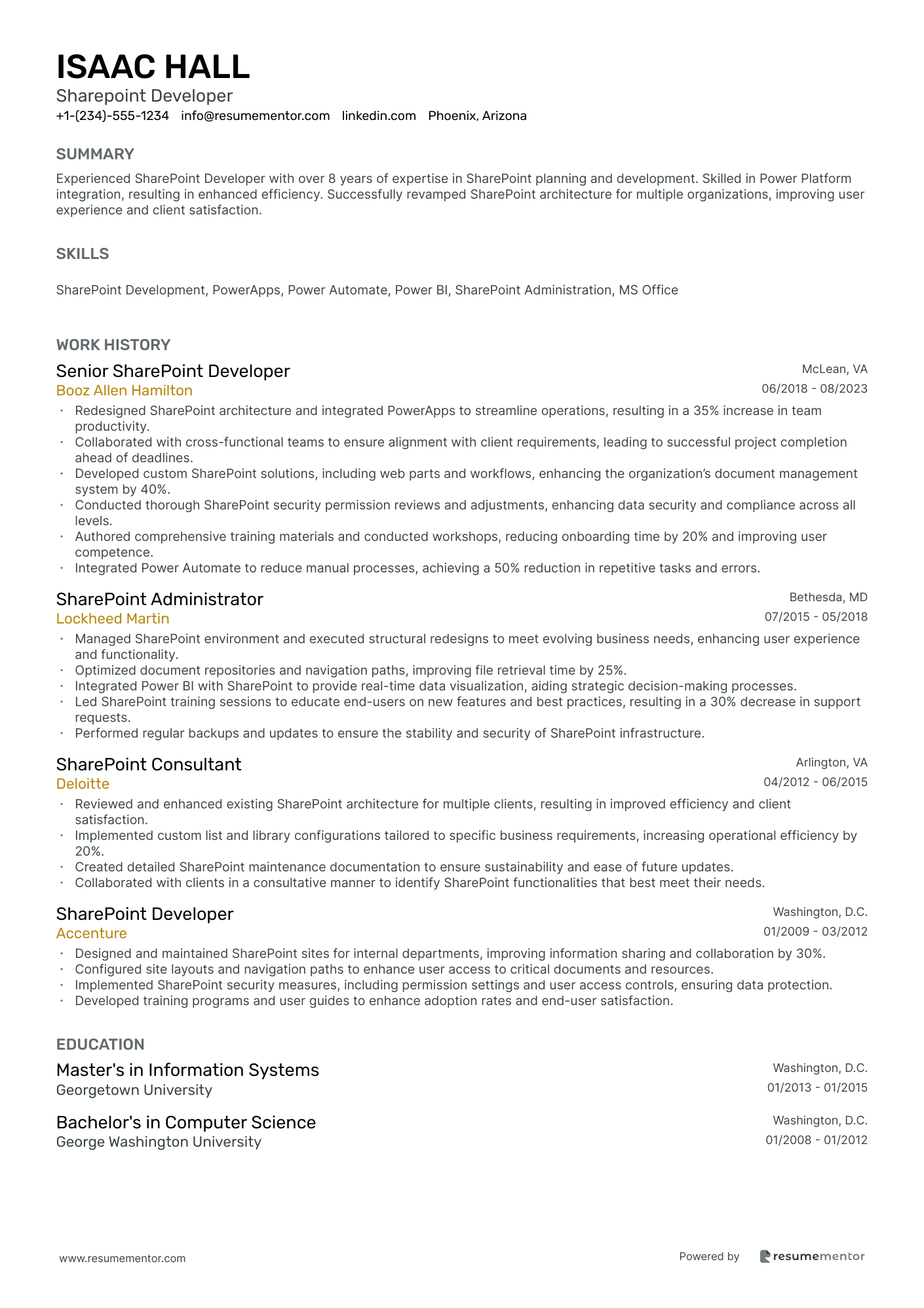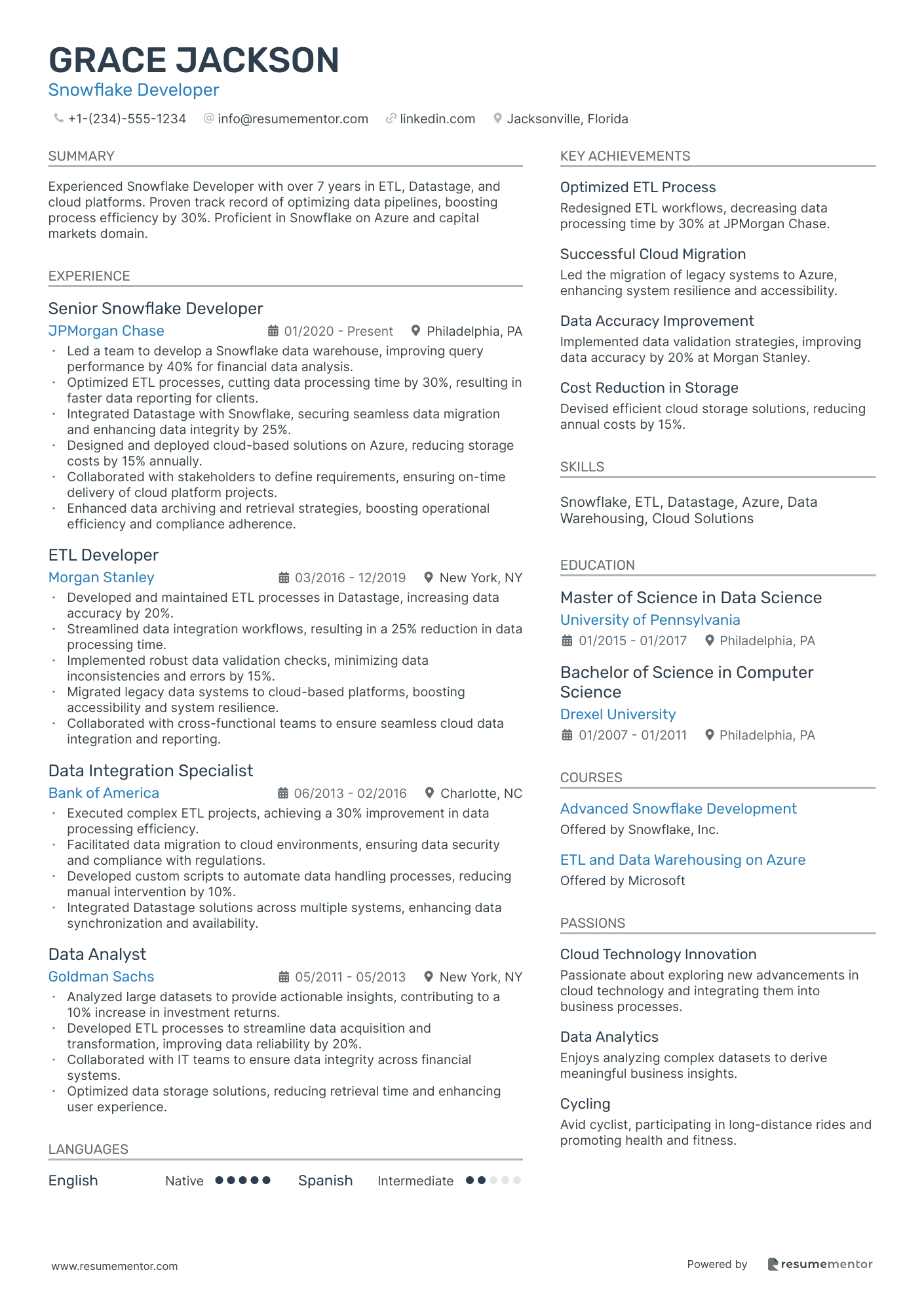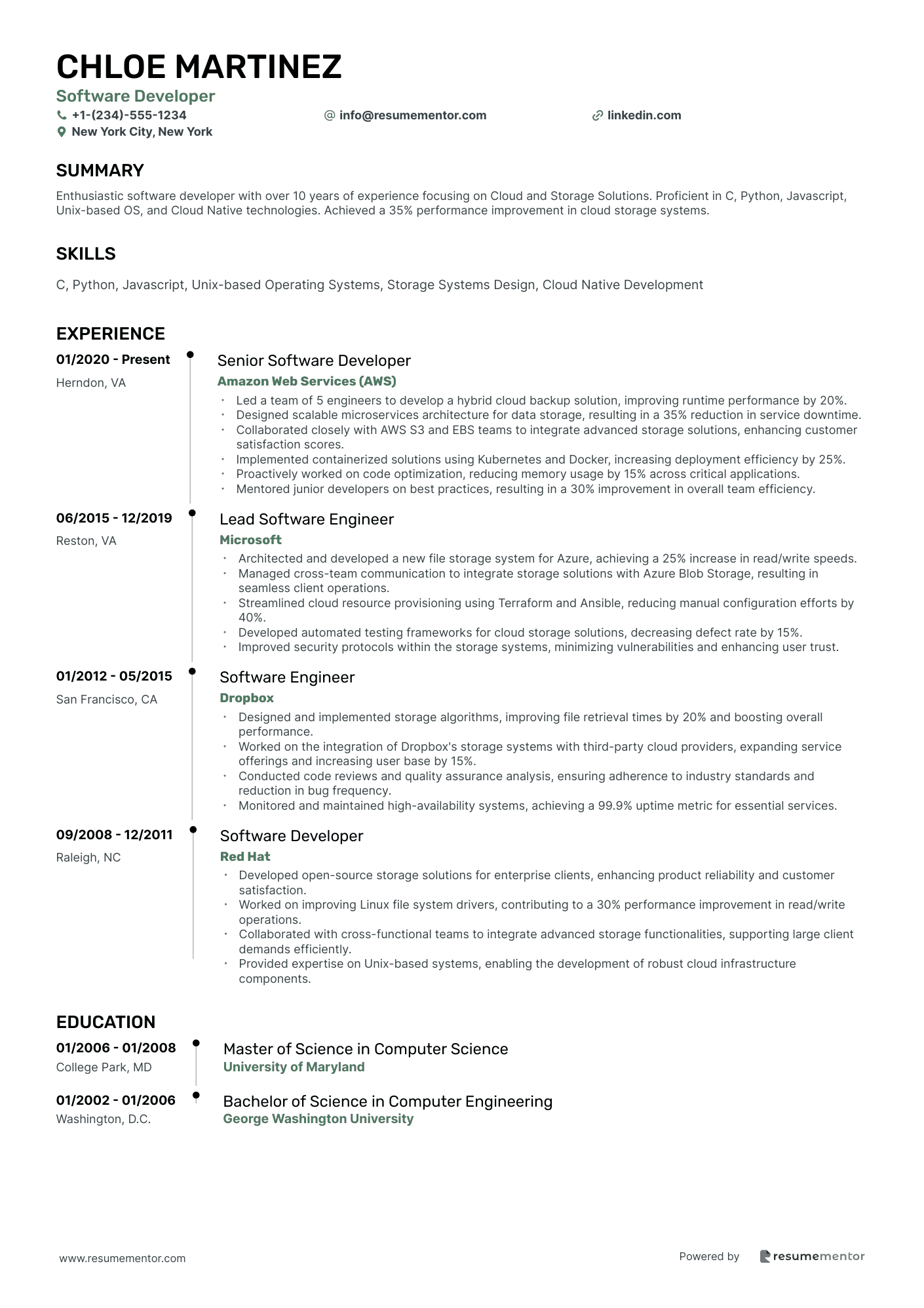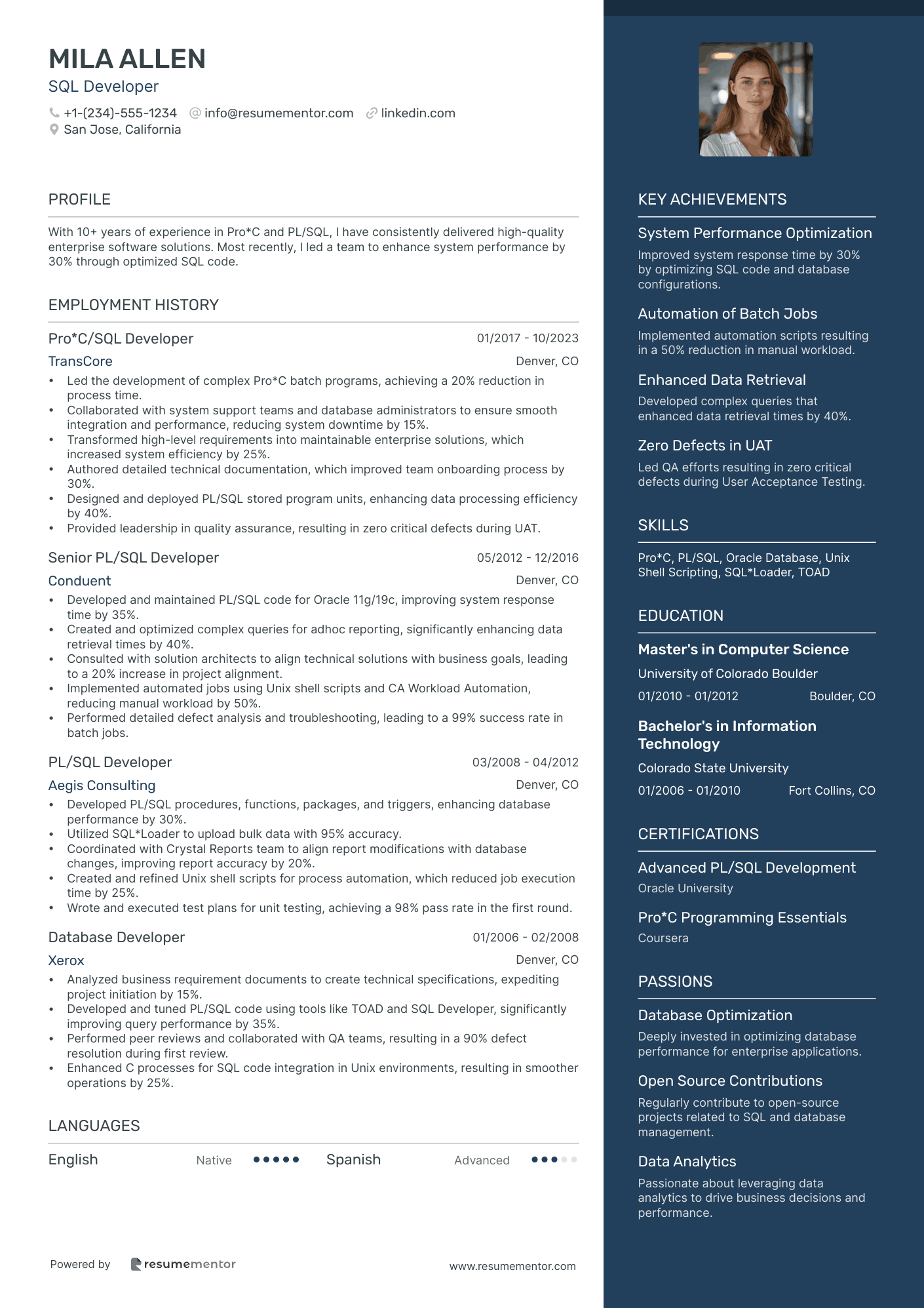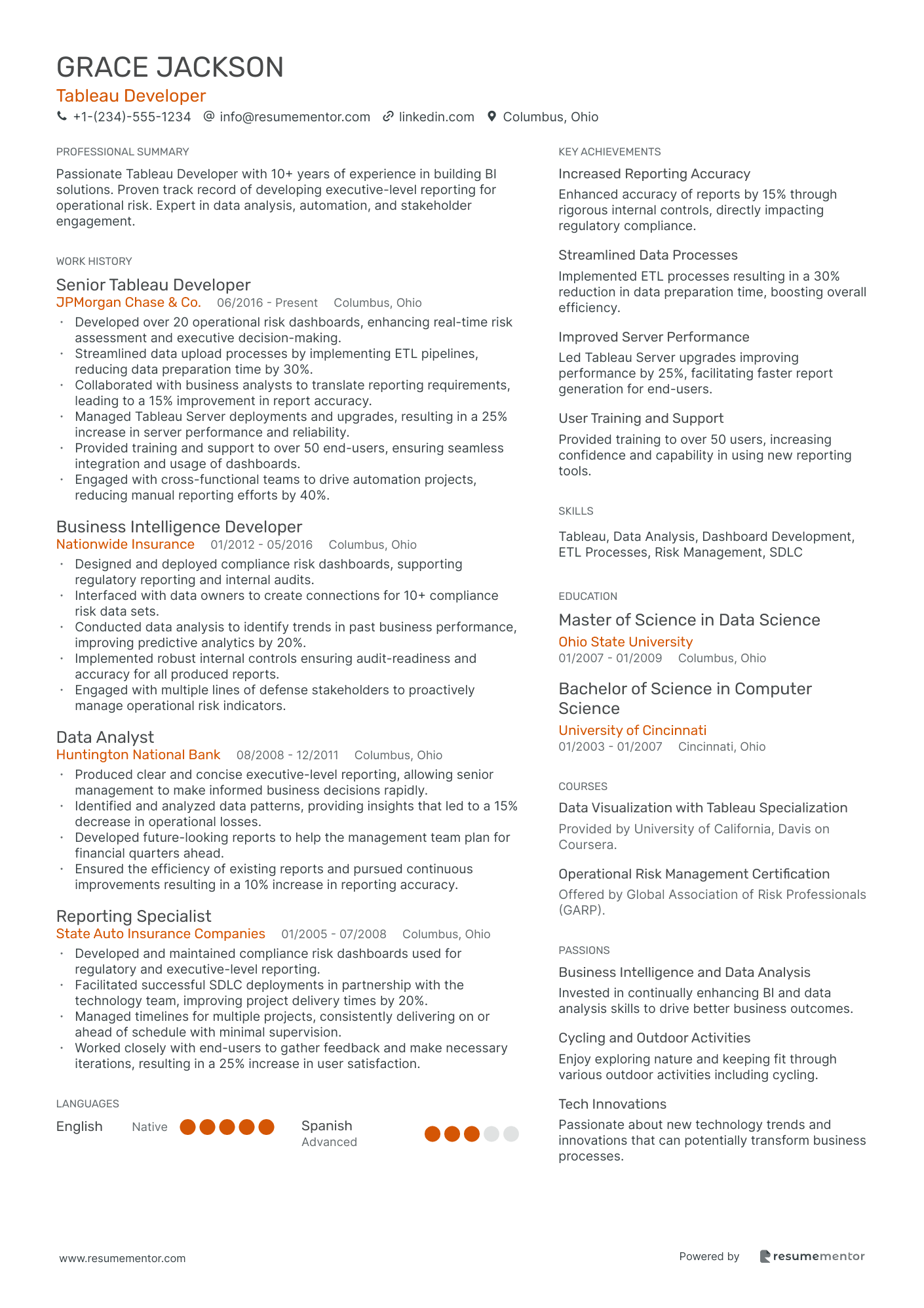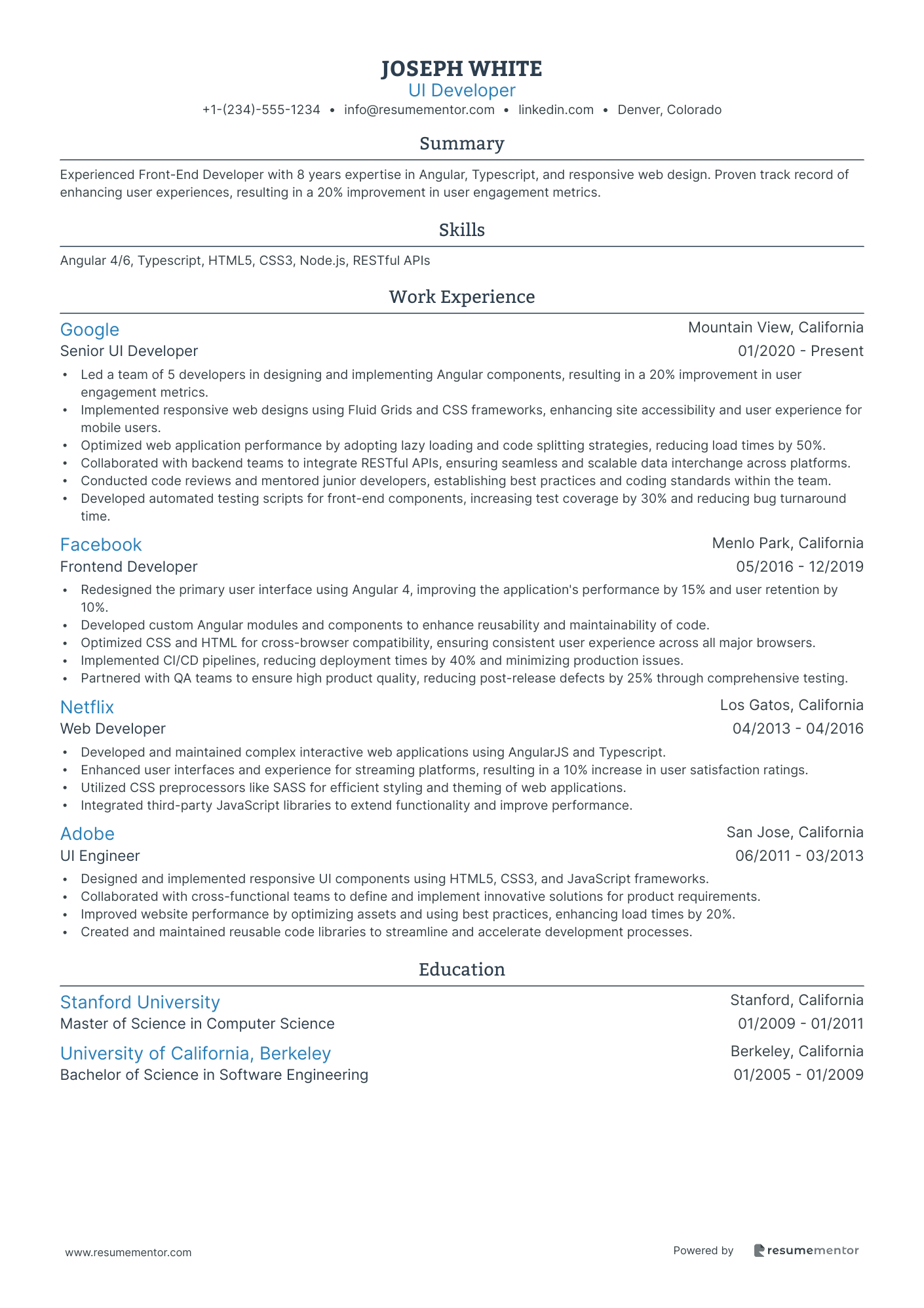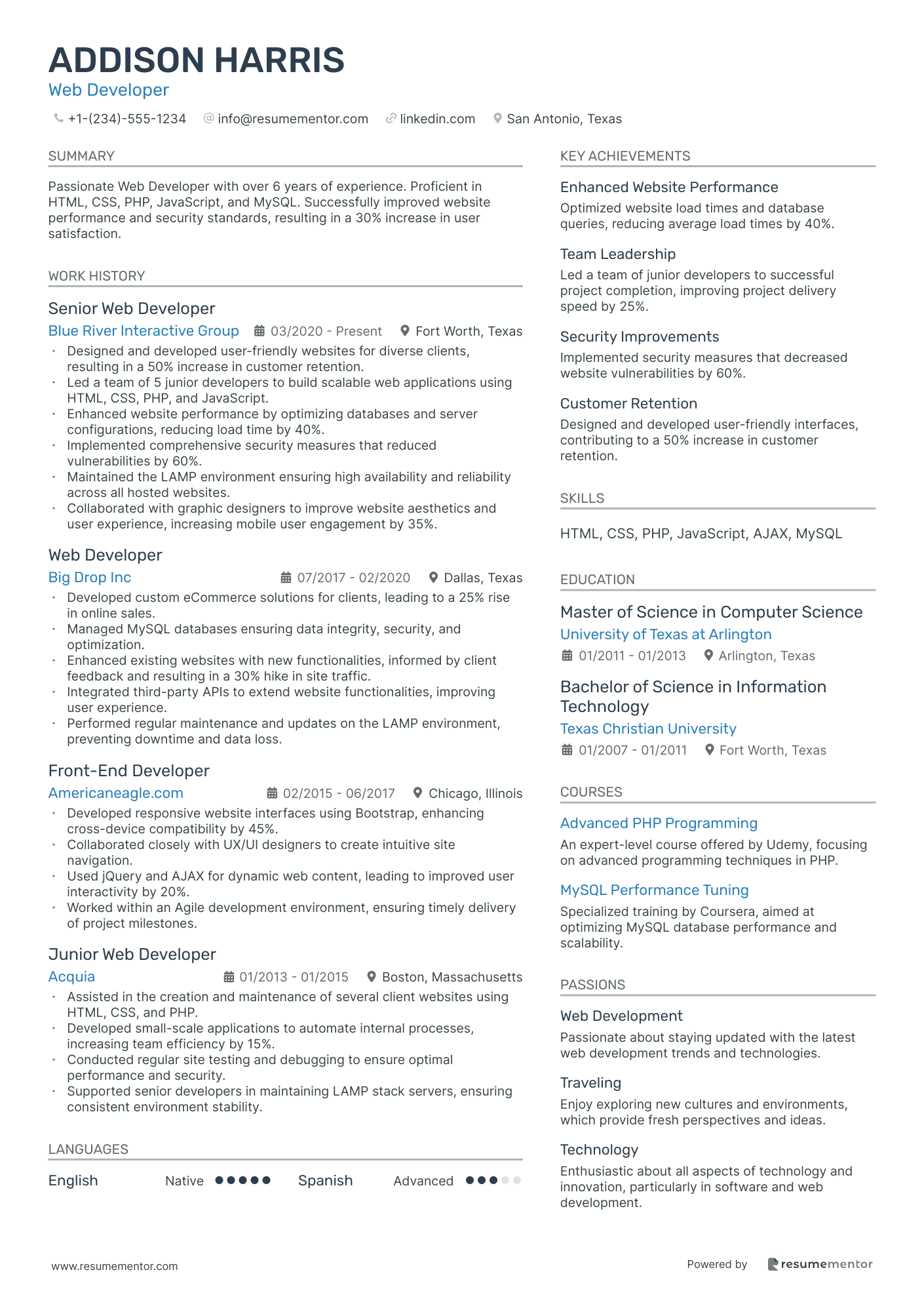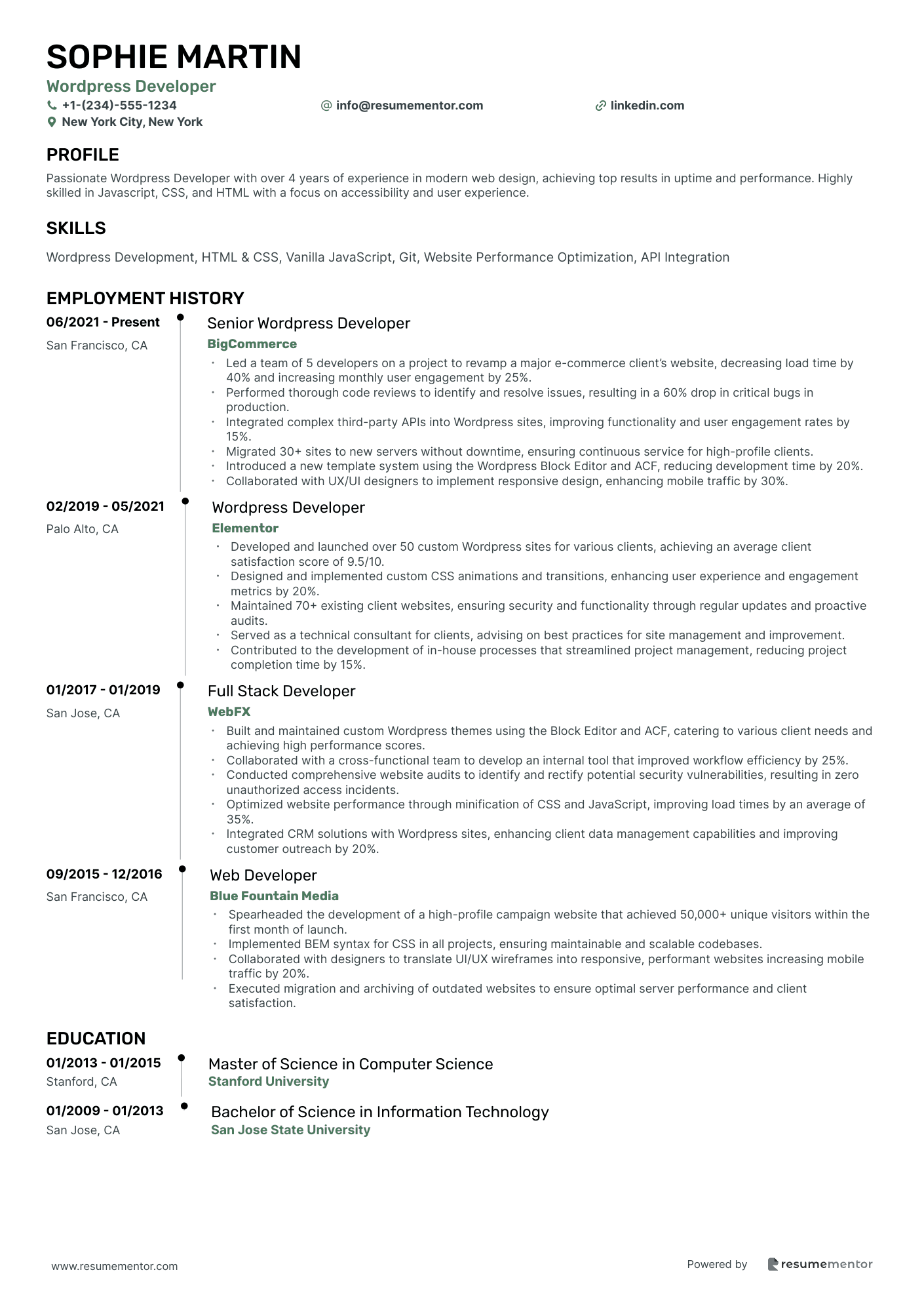39+ Developer Resume Examples

Jul 18, 2024
|
12 min read
Code your way to success: A step-by-step guide to crafting the perfect developer resume, ensuring employers can't resist your skills and expertise.
Rated by 348 people
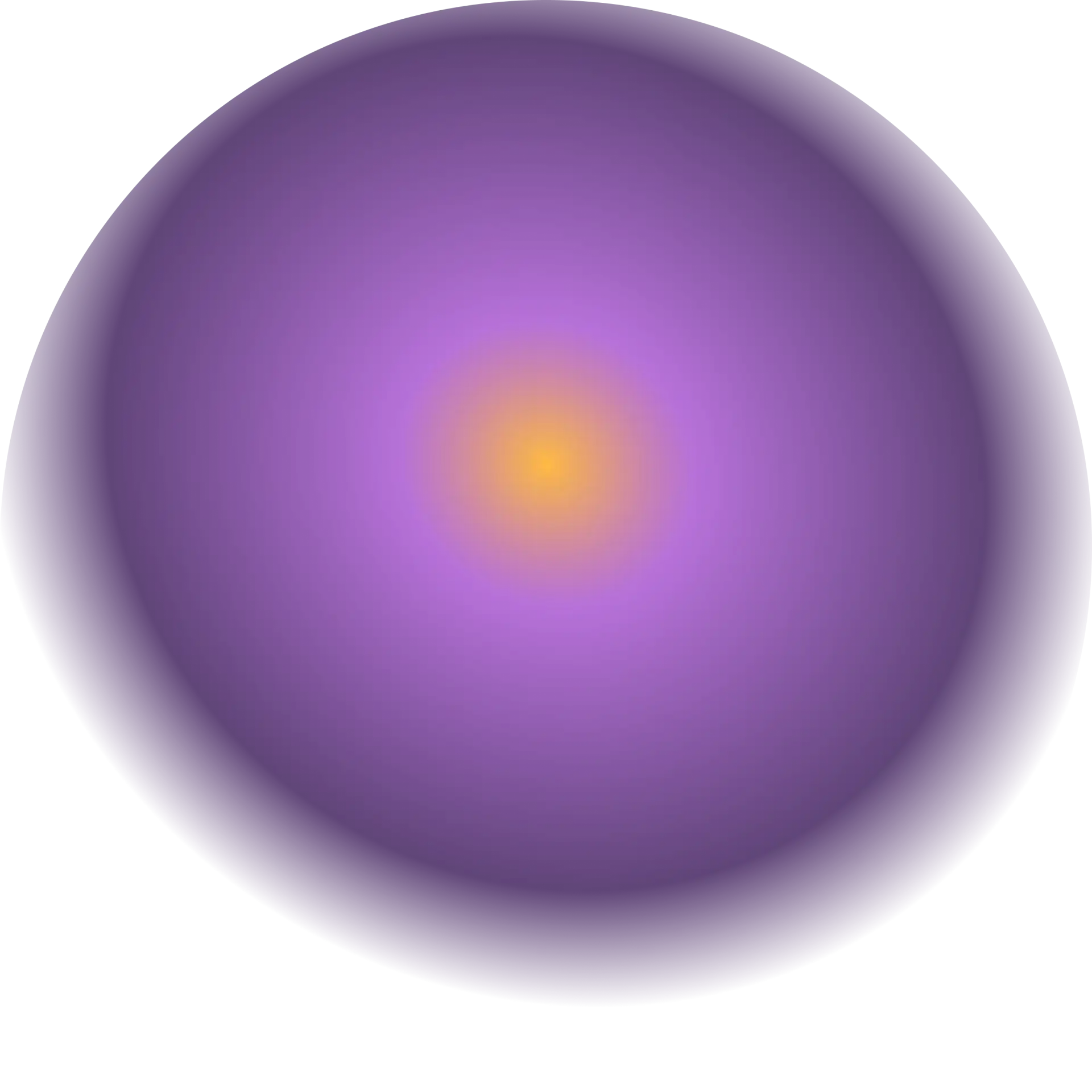
Lead Developer resume sample
- •Led the development of a cloud-based CRM application, increasing customer engagement by 25% and reducing response time by 15%.
- •Streamlined deployment processes by implementing CI/CD pipelines, which increased release frequency by 40% and reduced errors by 20%.
- •Designed and implemented scalable microservices architecture, supporting over 1 million concurrent users, resulting in improved system reliability.
- •Mentored a team of 8 junior developers, leading to a 50% improvement in code quality and team productivity.
- •Integrated third-party API solutions, enhancing system capabilities and enabling new business functionalities.
- •Conducted code reviews and enforced best practices, reducing technical debt by 35% over the course of one year.
- •Managed a team of 10 software developers, delivering high-quality software releases 20% faster than the previous year.
- •Spearheaded a data migration project to Azure Cloud, reducing infrastructure costs by 30% and improving operational efficiency.
- •Developed and maintained critical enterprise applications, resulting in 15% reduction in downtime and 10% increase in user satisfaction.
- •Collaborated with stakeholders to define application requirements, ensuring alignment with business goals and achieving project milestones.
- •Implemented a comprehensive security framework, enhancing data protection and compliance with industry standards.
- •Designed and developed web applications using .NET technologies, resulting in a 20% increase in user engagement.
- •Optimized database queries and indexing, enhancing application performance by 25% and reducing load times.
- •Collaborated with cross-functional teams to deliver high-availability web services, significantly improving customer experience.
- •Introduced automated testing frameworks, increasing test coverage by 35% and reducing bugs by 20%.
- •Provided technical leadership and guidance on complex projects, contributing to 10 successful project deliveries within deadlines.
- •Analyzed business requirements and translated them into technical specifications, facilitating the successful implementation of enterprise applications.
- •Developed and maintained SQL databases, resulting in improved data integrity and system performance.
- •Monitored network operations and resolved infrastructure issues, reducing downtime by 20%.
- •Implemented virtualization technologies, increasing server utilization by 15% and reducing hardware costs.
Mid-Level Developer resume sample
- •Led the development of a comprehensive business intelligence dashboard in Power BI that increased data reporting efficiency by 20%.
- •Collaborated with senior leadership to provide insights, resulting in a 15% improvement in decision-making accuracy.
- •Developed robust analytical models including forecast and cost models, contributing to a 10% reduction in operational costs.
- •Utilized Python and SQL to automate data extraction processes, reducing manual work by 25%.
- •Navigated complex matrix environments to balance competing priorities, ensuring project timelines were consistently met.
- •Built machine learning models to predict maintenance needs, resulting in a 30% decrease in system downtimes.
- •Created dashboards in Tableau analyzing consumer data, resulting in a 15% increase in customer satisfaction.
- •Performed statistical analyses and data visualizations to assist senior leadership in strategic decision-making.
- •Facilitated BI tool training sessions for over 50 team members, enhancing overall data literacy within the organization.
- •Developed ETL pipelines using SQL and Python, improving data processing time by 20%.
- •Worked on integrating SQL databases with Hadoop systems, enabling efficient handling of large data sets.
- •Designed Qlik Sense dashboards that provided actionable insights to the defense sector, increasing operational efficiency by 10%.
- •Collaborated with cross-functional teams to understand data requirements and deliver tailored BI solutions.
- •Briefed senior military leaders on data trends and analytics findings, aiding in mission-critical decisions.
- •Implemented machine learning algorithms to analyze unstructured data, uncovering hidden patterns and insights.
- •Developed predictive analytics models to forecast equipment failures, reducing maintenance costs by 12%.
- •Worked with big data systems like Hadoop and Hive for large-scale data processing.
- •Optimized SQL queries to improve database performance, leading to a 25% reduction in query execution times.
- •Communicated complex data findings to non-technical stakeholders, ensuring clear understanding of the actionable insights.
Senior Developer resume sample
- •Designed and implemented a microservices architecture using Spring Cloud and Docker, improving deployment efficiency by 50%.
- •Led a team of 5 developers in migrating a legacy system to AWS, resulting in a 20% reduction in operational costs.
- •Integrated CI/CD pipelines using Jenkins, reducing release times from weeks to days.
- •Collaborated with cross-functional teams to define system requirements, enhancing software functionality and user experience.
- •Built and maintained data analytics dashboards using ELK stack, providing real-time insights for better decision making.
- •Resolved critical software issues by debugging complex code, significantly improving system reliability and performance.
- •Developed RESTful APIs for financial applications, enhancing transaction processing speeds by 40%.
- •Conducted comprehensive application testing, ensuring software met stringent financial industry standards.
- •Documented code and provided mentorship to junior developers, streamlining team development processes.
- •Implemented Splunk for log management, allowing for faster issue resolution and system diagnostics.
- •Worked closely with project managers during fact-finding phases, defining system scope and development objectives.
- •Coded and deployed middleware solutions using Java and Oracle, boosting data integration efficiency by 30%.
- •Participated in agile development cycles, ensuring timely completion of project milestones.
- •Assisted in designing and coding large-scale software applications, advancing the company's technology capabilities.
- •Provided accurate estimates for project timelines and resource allocation, resulting in better project planning.
- •Developed multiple software applications using Python and SQL Server, improving data processing efficiency.
- •Performed application testing to ensure software met user requirements and quality standards.
- •Produced detailed documentation and guidelines, facilitating smoother transitions between project phases.
- •Communicated effectively with IT teams and management, ensuring alignment on project objectives and priorities.
Mainframe Developer resume sample
- •Developed and maintained COBOL applications for critical financial operations, increasing data processing speed by 20%.
- •Led a team of 5 developers in migrating legacy systems to modern mainframe solutions, resulting in a 30% efficiency improvement.
- •Implemented automated testing frameworks for mainframe environments, reducing testing time by 40%.
- •Optimized CICS transaction processing, leading to a 15% reduction in system downtime.
- •Collaborated with cross-functional teams to integrate mainframe applications with cloud infrastructure.
- •Conducted regular code reviews and performance tuning, achieving a 25% increase in system performance.
- •Developed batch processing applications in COBOL, reducing nightly batch run times by 30%.
- •Designed and implemented JCL scripts for efficient job scheduling and resource management.
- •Provided technical support for mainframe applications, reducing incident response time by 50%.
- •Participated in disaster recovery planning and testing, ensuring 99.9% uptime and data integrity.
- •Created and maintained comprehensive documentation for mainframe systems and processes.
- •Analyzed and resolved mainframe application issues, achieving a 95% resolution rate within SLA.
- •Developed and enhanced PL/I programs for insurance processing systems.
- •Executed data conversion projects, resulting in seamless data migration between platforms.
- •Conducted system performance analysis and tuning, improving mainframe response times by 10%.
- •Created COBOL-based solutions for state government systems, enhancing data accuracy by 15%.
- •Worked on mainframe-to-web integration projects, providing real-time data access for web applications.
- •Developed utilities to automate routine mainframe tasks, saving 150 hours of manual effort annually.
- •Assisted in mainframe disaster recovery drills and audits.
Android Developer resume sample
- •Led a team of developers to design and build advanced Android applications, resulting in a 25% increase in user engagement.
- •Managed the entire application development lifecycle, including release management and ongoing support for over 10 mobile applications.
- •Collaborated with cross-functional teams to define, design, and ship new features, increasing app downloads by 15% within the first month.
- •Analyzed and classified complex change requests, implementing enhancements that reduced crash rates by 30%.
- •Recommended and integrated new technologies that maximized development efficiency by 35%, leading to faster release cycles.
- •Acted as a key resource for mobile app developers, providing guidance and mentorship that improved team performance and cohesion.
- •Designed and developed key Android applications, achieving over 1 million downloads and a 4.5-star rating on the Play Store.
- •Led cross-functional teams in the creation of new app features, resulting in a 20% increase in monthly active users.
- •Conducted thorough analysis and evaluation of detailed business and technical requirements to streamline development processes.
- •Implemented troubleshooting systems that decreased bug-related issues by 40%, improving app stability and user satisfaction.
- •Delivered regular app updates and feature improvements, maintaining a high retention rate of 80% among active users.
- •Developed and launched Android applications with over 500,000 downloads, contributing significantly to the company's digital strategy.
- •Worked closely with UI/UX designers to create user-friendly interfaces, resulting in a 15% increase in user satisfaction scores.
- •Analyzed complex change requests and implemented solutions that optimized app performance by 25%.
- •Provided support and troubleshooting for application users, resolving 90% of issues within 24 hours.
- •Contributed to various Android projects, including the development and release of high-profile applications.
- •Evaluated and recommended new technologies, resulting in a 20% increase in development efficiency.
- •Participated in code review processes, ensuring high-quality deliverables and compliance with industry standards.
- •Troubleshot and resolved technical issues, maintaining a high level of system reliability and performance.
Angular Developer resume sample
- •Led the development of an AI-powered diagnostic tool, improving fleet maintenance efficiency by 35%.
- •Directed a team of 8 developers, implementing best practices that reduced code errors by 15%.
- •Integrated machine learning algorithms to predict vehicle maintenance needs, increasing uptime by 10%.
- •Modernized legacy systems, enhancing application performance by 20% through streamlined code processes.
- •Conducted comprehensive code reviews, which resulted in a 25% improvement in code quality and consistency.
- •Collaborated with cross-functional teams, ensuring seamless integration of new features and technologies.
- •Developed a GPS tracking feature for fleet management, reducing route optimization time by 30%.
- •Collaborated with data scientists to implement predictive analytics, improving service reliability.
- •Implemented an automated testing suite, decreasing testing time by 40% and enhancing code deployment speed.
- •Mentored junior developers, providing guidance on project management and development best practices.
- •Redesigned user interfaces for mobile applications, increasing user engagement by 15%.
- •Optimized backend services for real-time data processing, improving system responsiveness by 25%.
- •Led a project to integrate third-party APIs, expanding service capabilities and user options.
- •Enhanced application security protocols, reducing the number of vulnerabilities by 40%.
- •Developed a fleet management dashboard, resulting in a 20% increase in operational efficiency.
- •Contributed to the development of an in-house fleet tracking system, which improved monitoring accuracy by 20%.
- •Created custom solutions to streamline maintenance schedules, reducing downtime by 10%.
- •Collaborated with engineers to integrate AI-driven diagnostics, enhancing overall system performance.
- •Performed regular code audits and updates to ensure top-notch code quality and performance.
Azure Developer resume sample
- •Led the implementation of Azure B2C solutions for a multi-tenant application, improving client onboarding efficiency by 40%.
- •Enhanced data retrieval and analytics through the effective deployment and maintenance of Elastic Search, increasing query performance by 55%.
- •Developed and managed scalable multi-tenant applications using Dotnetcore, supporting over 100 clients with zero downtime.
- •Created and managed SQL Reports to provide actionable insights, resulting in a 25% improvement in decision-making capabilities.
- •Implemented and maintained message queuing via RabbitMQ, ensuring efficient communication between services and reducing message loss by 33%.
- •Collaborated with cross-functional teams to deliver projects on time, increasing team efficiency by 15% through improved coordination.
- •Delivered robust cloud-based applications using C# and React, improving system reliability and performance by 40%.
- •Integrated Hangfire for background job processing, reducing job processing time by 30% and enhancing application responsiveness.
- •Optimized multi-tenant architecture, reducing server costs by 20% while maintaining high performance and scalability.
- •Managed SQL Reporting Services to facilitate crucial data analytics, boosting reporting efficiency by 50%.
- •Provided technical documentation for all developed solutions, ensuring seamless transition for maintenance and future scalability.
- •Designed and deployed Azure B2C solutions, integrating with existing applications to provide a seamless user experience.
- •Developed microservices architecture using .NET Core to enable modular, scalable application design.
- •Implemented Elastic Search for enhanced data retrieval, reducing search times by 45%.
- •Coordinated with teams to ensure the successful deployment of applications, achieving a 100% project completion rate.
- •Conceptualized and developed web applications using C# and React, enhancing frontend and backend functionalities.
- •Maintained and updated existing applications, improving their performance and security.
- •Collaborated with cross-functional teams to troubleshoot and resolve complex issues in a timely manner.
- •Created detailed technical documentation for developed applications, facilitating ease of maintenance and upgrades.
Backend Developer resume sample
- •Spearheaded a migration to a Java microservices architecture, enhancing system efficiency by 30% and improving scalability.
- •Implemented Circuit Breaker and API Gateway patterns, resulting in a 20% reduction in downtime during peak loads.
- •Developed over 25 microservices using SpringBoot and Docker, facilitating faster deployment cycles and increased code maintainability.
- •Constructed technical design specifications and delivered quality code independently under tight deadlines.
- •Utilized SonarQube and JUnit for unit testing, resulting in a 15% increase in code coverage.
- •Designed and developed scalable microservices for customer data management, reducing response time by 40%.
- •Collaborated within an agile team to implement event-driven architecture, improving data processing speed by 25%.
- •Documented comprehensive software architecture and flow diagrams for all projects, aiding in team collaboration and knowledge sharing.
- •Integrated MongoDB for a NoSQL database solution, increasing data retrieval efficiency by 35%.
- •Conducted unit tests and code reviews, ensuring code quality and adherence to best practices.
- •Implemented design patterns such as Observable and Factory, enhancing code reusability and maintenance.
- •Developed multiple RESTful APIs, improving application performance and facilitating seamless integration with other services.
- •Optimized SQL queries, resulting in a 20% reduction in database latency and improved application performance.
- •Led the introduction of Docker for containerized deployments, reducing time-to-market by 15%.
- •Collaborated with cross-functional teams to develop and deploy web applications using Java and Spring.
- •Implemented Database Per Service pattern, ensuring data integrity and isolation across services.
- •Documented technical details and code comments, supporting maintenance and knowledge sharing within the team.
- •Performed comprehensive unit testing and debugging, enhancing code quality and application reliability.
C# developer resume sample
- •Led a team of 5 developers to create a web-based logistics tracking system, significantly reducing tracking errors by 35%.
- •Designed and implemented RESTful APIs utilizing C# and .NET framework, enhancing system's performance by 20%.
- •Conducted code reviews and participated in pair programming, improving code quality and reducing bug rates by 15%.
- •Integrated third-party API solutions to expand application functionality, resulting in an enhanced user experience.
- •Worked closely with the QA team to identify and resolve over 200 software defects in a high-paced environment.
- •Developed and maintained secure and scalable SQL Server databases, ensuring data integrity and compliance.
- •Developed and maintained an internal web application used to monitor aircraft maintenance schedules, improving efficiency by 25%.
- •Collaborated with cross-functional teams in an Agile environment to deliver high-quality software on time.
- •Mentored junior developers, providing guidance on best practices for code quality and design patterns.
- •Implemented continuous integration and continuous deployment (CI/CD) pipelines, reducing deployment times by 40%.
- •Optimized SQL queries and database schemas to enhance application performance and scalability.
- •Assisted in developing web-based applications using C#, ASP.NET MVC, and JavaScript, contributing to a 15% increase in project completion rates.
- •Performed unit and integration testing to ensure the robustness of the software, leading to a 20% reduction in post-deployment issues.
- •Documented application features and technical specifications for end-users and internal staff.
- •Resolved over 100 customer-reported issues, improving user satisfaction ratings by 10%.
- •Supported the development team by writing and debugging code in C#, contributing to the project's overall success.
- •Participated in Agile/Scrum meetings to stay updated on project progress and contribute ideas.
- •Created documentation for code and application features, aiding future maintenance and updates.
- •Collaborated with senior developers to refactor legacy code, improving application stability and performance.
Database Developer resume sample
- •Led a team in upgrading 15+ Oracle 12C databases to 19C, ensuring 99.9% system uptime and seamless transition.
- •Designed and implemented data migration strategies to Azure Cloud for over 10 TB of data, enhancing data integrity and performance.
- •Collaborated with cross-functional teams to create data management protocols, resulting in improved data governance and reduced data redundancy by 20%.
- •Developed and maintained complex data models, streamlining data access and enhancing database efficiency by 30%.
- •Implemented database automation scripts supporting CI/CD pipelines, reducing deployment time by 40%.
- •Provided technical support and troubleshooting, resolving 95% of database-related issues within the first 24 hours.
- •Managed the upgrade of Oracle databases from 11G to 12C, minimizing downtime and ensuring backward compatibility.
- •Engineered database security protocols that reduced vulnerabilities and potential data breaches by 50%.
- •Optimized SQL queries and managed storage solutions, enhancing database performance by 25%.
- •Developed standards and procedures for database environments, resulting in a 30% increase in operational efficiency.
- •Implemented DevOps practices, including version control and automated testing, leading to a 20% reduction in errors.
- •Designed and implemented database schemas and objects to support business intelligence initiatives, directly contributing to a 15% increase in analytical capabilities.
- •Managed the information lifecycle efficiently, supporting the company's goal of achieving comprehensive data integration.
- •Developed and maintained database automation tools, enabling continuous integration and streamlined deployment.
- •Provided technical support for database-related issues, achieving a 98% resolution rate within SLA time frames.
- •Designed logical database models to support new and existing applications, improving data retrieval speeds by 25%.
- •Implemented data integration controls and protocols, enhancing data governance and compliance.
- •Monitored and optimized database performance, leading to a 15% reduction in system latency.
- •Collaborated with developers to design data governance protocols that ensured data integrity and compliance.
.Net developer resume sample
- •Led a team to develop a .Net-based claims processing system, improving processing speed by 40% and reducing errors by 15%
- •Implemented API integrations that facilitated seamless data exchange, enhancing interoperability and resulting in a 20% increase in data accuracy
- •Designed and executed various unit and integration tests, achieving a 98% success rate in quality assurance checks
- •Streamlined the deployment process using CI/CD pipelines, reducing deployment time by 30%
- •Created comprehensive technical documentation and user manuals, resulting in a 25% decrease in support tickets
- •Collaborated closely with stakeholders to gather requirements and ensure alignment, leading to a 95% project approval rate
- •Developed a robust .Net application to manage pharmacy inventory, reducing stock-outs by 20% and optimizing inventory levels
- •Mentored junior developers in .Net best practices, boosting team productivity by 15%
- •Collaborated with UX/UI teams to enhance the user interface, leading to a 25% increase in user satisfaction scores
- •Successfully migrated legacy applications to new .Net Core framework, resulting in 30% improved application performance
- •Conducted code reviews and implemented best coding practices, reducing codebase issues by 35%
- •Assisted in the development of a customer-facing web portal using .Net, increasing online engagement by 50%
- •Worked closely with database administrators to optimize SQL queries, reducing report generation time by 40%
- •Implemented security features to protect sensitive healthcare data, achieving HIPAA compliance
- •Conducted performance tuning and optimization for critical applications, enhancing response times by 25%
- •Provided technical support during system upgrades and deployments, ensuring minimal downtime
- •Assisted in the development of internal tools that automated routine tasks, saving the team 10 hours per week
- •Participated in the full software development lifecycle, from requirements gathering to deployment
- •Collaborated with senior developers to fix bugs and improve code quality, reducing bug rates by 20%
- •Created detailed technical specifications and project documentation, facilitating better project management
ETL developer resume sample
- •Led the design and implementation of ETL processes using DataStage, improving data load performance by 35%.
- •Developed and maintained PL/SQL procedures, functions, triggers, and packages, ensuring seamless data integration and transformation.
- •Managed job scheduling using DataStage and Autosys, optimizing resource utilization and reducing operating time by 20%.
- •Collaborated with cross-functional teams to address complex data warehousing issues, resulting in a 40% decrease in data discrepancies.
- •Formulated and defined system scope and objectives, creating detailed specifications from which programs were developed and tested.
- •Provided mentorship to junior developers, elevating team skill levels and contributing to the timely completion of significant projects.
- •Designed, coded, and debugged ETL programs using DataStage for multiple large-scale data warehouse projects.
- •Implemented error resolution processes within DataStage, reducing downtime and improving data reliability by 25%.
- •Developed UNIX/Linux shell scripts to automate data extraction and transformation tasks, improving operational efficiency.
- •Utilized DataStage functionalities such as file loading and unstructured data processing, enhancing data integration capabilities.
- •Collaborated with business analysts to modify procedures solving complex data problems, ensuring alignment with project goals.
- •Built ETL pipelines using DataStage for extracting and loading data into enterprise data warehouses.
- •Engaged in the parallel and sequential job scheduling process, optimizing job execution and minimizing delays.
- •Created and managed DataStage jobs for extraction, transformation, and loading (ETL) tasks, improving data throughput.
- •Maintained comprehensive documentation for all ETL processes, facilitating smoother onboarding and knowledge transfer.
- •Conducted in-depth data analysis to support business decision-making and strategy development using Oracle databases.
- •Created and maintained PL/SQL procedures to enhance data manipulation and retrieval processes.
- •Developed and executed complex queries to extract and analyze large datasets, contributing to business intelligence initiatives.
- •Collaborated with IT and business teams to ensure data quality and consistency across various platforms.
Front End Developer resume sample
- •Architected and developed performant .NET web applications, enhancing user experience for over 500,000 users.
- •Led a team to migrate legacy applications to modern frameworks, resulting in a 25% reduction in loading times.
- •Implemented best coding practices in a fast-paced environment, reducing bugs by 30%.
- •Conducted requirements gathering and technical specifications, ensuring alignment with client expectations.
- •Communicated with remote teams across the U.S., providing training and troubleshooting support.
- •Pursued continuous learning to stay updated with web development trends and technologies.
- •Developed fast and intuitive user interfaces using modern development technologies.
- •Transformed wireframes into reusable code, building scalable UI components for client applications.
- •Contributed to multiple concurrent projects while adhering to project budgets and timelines.
- •Enhanced legacy applications, improving performance and user satisfaction.
- •Assisted with business development initiatives, including client presentations and proposal support.
- •Built and tested data-driven .NET web applications, adhering to creative team designs and accessibility requirements.
- •Implemented best practices to improve code quality, reducing technical debt by 20%.
- •Conducted needs analysis and developed technical specifications for web solutions.
- •Collaborated with clients to ensure project deliverables met high-quality standards.
- •Maintained and supported legacy applications, ensuring minimal downtime.
- •Developed and delivered modern web applications, improving user interaction and accessibility.
- •Worked on multiple short- and long-term projects, ensuring timely delivery while maintaining quality.
- •Proactively implemented best coding practices, reducing development time by 15%.
- •Communicated project updates and provided training to teams across various locations.
Full Stack Developer resume sample
- •Led a team of 5 developers to enhance an internal web application, improving performance by 30%, resulting in better user experience.
- •Developed and deployed several RESTful APIs which facilitated seamless integration between front-end and back-end systems, increasing workflow efficiency by 20%.
- •Implemented new security measures reducing data breaches by 15% and ensuring compliance with industry standards.
- •Collaborated with GIS team to integrate spatial data layers, enhancing the application's functionality and providing richer data analysis capabilities.
- •Pioneered the use of new agile methodologies within the team, improving project delivery times by 25%.
- •Maintained and updated cloud infrastructure leading to a 40% decrease in downtime and ensuring high availability.
- •Designed and developed scalable web applications used by millions of users annually, adhering to best practices ensuring high-performance.
- •Built and maintained multiple APIs enabling seamless communication between microservices, leading to a 15% increase in application reliability.
- •Integrated with multiple databases, optimizing queries and reducing data retrieval times by 25%.
- •Conducted code reviews regularly, maintaining a high standard of code quality and best practices within the team.
- •Worked closely with internal stakeholders to gather requirements and build tailored solutions resulting in an increase in user satisfaction by 10%.
- •Developed web and mobile applications used by clients globally, resulting in a growth of user base by 20%.
- •Participated in the full software development lifecycle from planning to deployment, ensuring the delivery of projects on time and within budget.
- •Implemented responsive design practices, significantly improving mobile application usability and increasing mobile traffic by 15%.
- •Collaborated with cross-functional teams to integrate new features, enhancing the overall product offering and user experience.
- •Assisted in the development of internal web applications, which contributed to better internal communication and collaboration.
- •Optimized existing codebases, reducing load times by 20% and improving overall application efficiency.
- •Implemented basic GIS functionalities, facilitating enhanced data visualization and analysis for internal teams.
- •Provided technical support and maintenance for deployed applications, ensuring minimal disruptions and quick issue resolution.
Game Developer resume sample
- •Managed comprehensive product schedules and requirements, implemented 10+ desired features for enhanced player engagement.
- •Supervised the complete development cycle, resolving 15+ critical issues to ensure smooth project progression and timely delivery.
- •Evaluated cultural themes in Asian-themed games, advising improvements and securing successful approval for further development.
- •Developed and maintained precise Asian-themed style guides, enhancing cultural accuracy and player immersion.
- •Collaborated with multiple departments, fostering partnerships that optimized resource allocation and project efficiency.
- •Generated detailed reports using project management tools, maintaining documentation and versions for 7 game projects.
- •Directed game production for 5 major titles, resulting in a 20% increase in overall player satisfaction.
- •Assessed and analyzed project data, providing actionable solutions that led to a 15% improvement in team performance.
- •Defined game development processes, aligning with industry trends to maintain competitive edge.
- •Oversaw and mitigated potential risks in development, preventing financial losses and ensuring project stability.
- •Served as mediator between development disciplines and upper management, ensuring seamless communication and conflict resolution.
- •Supported the shipping of 5 key game titles, contributing to a 25% increase in company revenue.
- •Implemented production methodologies, enhancing workflow efficiency and reducing project timelines by 10%.
- •Managed product schedules and requirements, supporting the integration of innovative features for improved gameplay.
- •Conducted conflict management, facilitating resolution in complex development situations, enhancing team dynamics.
- •Assisted in game development for 3 major titles, contributing to a 30% growth in the user base.
- •Maintained project documentation and versions, ensuring alignment with company standards.
- •Utilized Unity Engine and version control software tools, streamlining production workflows.
- •Coordinated inter-departmental partnerships to support overall production goals, enhancing project coherence.
Golang Developer resume sample
- •Led a team of 5 developers to build a scalable cloud application using Go, resulting in a 40% improvement in processing speed.
- •Designed and implemented REST APIs that facilitated seamless integration with third-party services, leading to a 20% reduction in bug reports.
- •Utilized microservices architecture to develop resilient backend systems, improving system uptime by 30%.
- •Collaborated with DevOps team to integrate CI/CD pipelines using Git and Bitbucket, reducing deployment time by 50%.
- •Implemented a new database schema using PostgreSQL, enhancing data retrieval speeds by 25%.
- •Conducted code reviews and mentored junior developers, improving code quality and team productivity by 15%.
- •Developed and maintained backend services using Go and Java, resulting in a 35% reduction in server response time.
- •Led the migration of legacy systems to microservices architecture, improving scalability and reducing operational costs by 25%.
- •Implemented RESTful APIs for new customer-facing applications, enhancing user satisfaction scores by 20%.
- •Collaborated with data engineers to optimize database queries, achieving a 15% improvement in data processing efficiency.
- •Automated testing and deployment processes using CI/CD tools, increasing deployment frequency by 60%.
- •Designed and implemented backend services for cloud applications using Go and Python, resulting in a 50% increase in performance.
- •Led a project to integrate NoSQL databases, enhancing data storage capabilities by 40%.
- •Developed microservices to replace monolithic architecture, improving system reliability and fault tolerance by 30%.
- •Worked with cross-functional teams to deliver high-quality software solutions on schedule and within budget.
- •Conducted performance tuning and optimization, reducing system latency by 25%.
- •Developed J2EE applications using Spring Boot, Spring Web, and Spring Security, contributing to a 20% increase in application security.
- •Designed RESTful web services for enterprise applications, resulting in a 15% reduction in integration issues.
- •Improved application performance by optimizing Java code and database interactions, reducing response times by 40%.
- •Collaborated closely with front-end developers to ensure seamless integration between backend services and user interfaces.
Hadoop Developer resume sample
- •Administered and maintained Hadoop ecosystem for over 50 million data points daily, ensuring 99.99% uptime and improving data retrieval speed by 40%.
- •Led capacity planning and hardware upgrades, increasing storage capacity by 35% and reducing system downtime to less than 0.5%.
- •Implemented Kerberos security to Hadoop clusters, enhancing data protection and reducing unauthorized access by 70%.
- •Executed performance tuning and volume management for Hadoop clusters, which improved overall system performance by 25%.
- •Automated data ingestion processes using Sqoop and Flume, reducing manual labor by 30% and increasing data integration efficiency.
- •Collaborated closely with cross-functional teams to troubleshoot issues, resolving 90% of Hadoop-related incidents within 2 hours.
- •Handled the setup, configuration, and scaling of Hadoop clusters, reducing deployment time by 20%.
- •Developed and maintained job and task scheduling systems, optimizing workflow and increasing data processing efficiency by 15%.
- •Conducted regular audits of Hadoop environments to ensure compliance with industry best practices, maintaining a 98% compliance rate.
- •Worked on performance fine-tuning and monitoring, leading to an enhancement of system throughput by 30%.
- •Facilitated data lake and data warehousing design, contributing to a 40% increase in data accessibility and usability.
- •Developed and deployed MapReduce routines, achieving a 50% reduction in data processing time.
- •Oversaw Hadoop cluster security configuration, including Kerberos integration, resulting in a 60% improvement in system security.
- •Collaborated with business intelligence teams on data warehousing projects, increasing data report efficiency by 25%.
- •Managed vendor relationships, ensuring timely escalation and resolution of issues, reducing vendor response time by 20%.
- •Performed data modeling and implementation based on recognized standards, improving data consistency by 35%.
- •Handled data ingestion using advanced tools, which resulted in a 40% improvement in data integration speed.
- •Interfaced with technical and non-technical teams to troubleshoot data-related issues, achieving a 90% first-call resolution rate.
- •Designed and developed data warehousing solutions, enhancing data retrieval speed by 20%.
IOS developer resume sample
- •Led a team of 5 developers to create a top-rated iOS app, increasing user engagement by 35% within six months.
- •Implemented SwiftUI to redesign the application's interface, resulting in a 25% enhancement in user experience and feedback.
- •Integrated a comprehensive CI/CD pipeline using Jenkins, reducing deployment times by 45%.
- •Collaborated with the backend team to optimize API integrations, increasing data retrieval speed by 20%.
- •Overhauled the push notification system, boosting user interaction rates by 30%.
- •Developed a high-performance iOS application for data analytics, used by over 1 million users.
- •Employed Core Data and Core Graphics to enhance app functionalities, improving performance by 40%.
- •Spearheaded the transition from Objective-C to Swift, enhancing code readability and maintainability.
- •Implemented background syncing of user data with cloud services, resulting in 99.9% data persistence and recovery.
- •Directed QA testing processes using Jira, decreasing critical bugs by 50% in the final release.
- •Designed and developed key components for the Facebook app, helping achieve a 20% increase in daily active users.
- •Integrated complex animations using Core Animation, enhancing app interaction and user satisfaction.
- •Worked closely with UX/UI designers to refine application interfaces according to Apple's design principles.
- •Executed real-time data parsing with JSON, ensuring a smooth and efficient user experience.
- •Developed enterprise-level iOS applications used by over 500,000 corporate users across various departments.
- •Enhanced security protocols for mobile applications, ensuring compliance with corporate and industry standards.
- •Managed the implementation of push notifications and cloud messaging, resulting in a 15% boost in user re-engagement.
- •Utilized Git for version control, streamlining the development and collaboration process across teams.
Java Developer resume sample
- •Led a team of 10 developers in migrating legacy systems to a cloud environment, achieving a 40% reduction in system downtime and maintenance costs.
- •Implemented microservices architecture for the customer account module, improving API response times by 25%.
- •Designed and executed unit testing frameworks, resulting in a 35% increase in code quality and reducing bug reports by 20%.
- •Collaborated with the UX team to redesign the customer policy summary, enhancing user navigation and reducing drop-offs by 15%.
- •Mentored junior developers, increasing team skill capabilities and fostering promotable talent by 20%, contributing to overall team performance improvement.
- •Developed and deployed policy management applications, resulting in a 30% improvement in processing speed and operational efficiency.
- •Created automated data validation processes, eliminating manual input errors by 35% and greatly reducing data correction time.
- •Collaborated with cross-functional teams to implement an agile development culture, speeding project timelines by 25%.
- •Executed extensive code refactoring initiatives, ultimately reducing system load times by 30% and improving maintainability.
- •Facilitated in-house workshops to promote best coding practices and new technologies, enhancing team productivity and knowledge.
- •Worked on a team to integrate third-party APIs into the customer's policy viewing application, increasing data access efficiency by 20%.
- •Implemented security protocols for policy data storage, reducing data breaches by 25% and ensuring compliance with industry standards.
- •Enhanced internal customer service tools, bringing about a 15% increase in the speed of customer issue resolution.
- •Conducted code reviews and maintained code repositories, significantly improving team workflow and code readability.
- •Participated in the development of client-facing mobile applications, contributing to a 25% increase in mobile user engagement.
- •Assisted senior developers in maintaining and optimizing existing Java applications, leading to a 20% enhancement in performance.
- •Engaged in debugging and resolving issues in production environments, reducing downtime by 15% through timely fixes.
- •Supported the deployment process, ensuring smooth transitions and operational reliability with zero post-deployment issues.
Junior Developer resume sample
- •Developed geospatial applications within the Jupyter ecosystem, improving data analysis efficiency by 25%.
- •Led a team to create scalable environmental solutions using open-source mapping tools, enhancing community project performance.
- •Collaborated with environmental scientists to generate computational discoveries, contributing to 12 published research papers.
- •Implemented cloud infrastructure for scalable deployment, reducing project setup time by 40%.
- •Developed vendor-neutral design solutions, ensuring broad community adoption and meeting diverse needs.
- •Mentored junior developers, fostering an inclusive environment and enhancing team productivity by 15%.
- •Designed open-source geospatial applications to address critical environmental threats, resulting in a 30% increase in model accuracy.
- •Developed scalable software solutions, improving data accessibility for researchers globally.
- •Worked with cross-functional teams to integrate environmental data into cloud platforms, facilitating better decision-making processes.
- •Implemented best practices in open science, enhancing reproducibility and transparency across 5 major projects.
- •Presented findings at international conferences, increasing organization's visibility within the scientific community.
- •Analyzed geospatial data to inform environmental policies, supporting the development of 8 new regulations.
- •Developed algorithms for satellite data processing, increasing processing speed by 20%.
- •Worked on open source software projects to improve public access to climate data, reaching over 1 million global users.
- •Coordinated with international teams to standardize data collection methods, enhancing global research consistency.
- •Trained scientists in data science techniques, boosting department efficiency and knowledge sharing.
- •Developed software tools for environmental monitoring, increasing data collection accuracy by 35%.
- •Collaborated with policy makers to translate research findings into practical applications.
- •Enhanced existing geospatial applications, resulting in a 20% increase in user engagement.
- •Conducted workshops on open-source software usage, improving technical skills of 50+ staff members.
Mobile Developer resume sample
- •Developed and maintained high-quality public Android and iOS applications, resulting in a 30% increase in user engagement.
- •Successfully published over 10 applications on Android and iOS app stores with a combined download of 500,000+ users.
- •Led a team of 5 developers in designing applications around natural user interfaces, improving app usability by 25%.
- •Identified and corrected performance bottlenecks, resulting in a 40% increase in app loading speed.
- •Collaborated with backend developers to integrate RESTful APIs, enhancing app functionalities and synchronized data.
- •Maintained code quality and organization using Git, facilitating smoother team collaboration and version control.
- •Translated complex designs and wireframes into high-quality code, delivering user-friendly mobile applications.
- •Managed the publishing process of 8 applications to Android and iOS stores, achieving an average rating of 4.5 stars.
- •Implemented offline storage and threading solutions, increasing app reliability by 20%.
- •Utilized open-source Android libraries for common tasks, reducing development time by 15%.
- •Resolved technical issues rapidly as an iOS programmer, fixing over 200 bugs during the project cycles.
- •Developed and maintained reliable Java code for high-performance mobile applications.
- •Ensured best possible performance and responsiveness of applications, leading to an increase in user satisfaction.
- •Collaborated closely with design teams to create sophisticated and visually appealing mobile applications.
- •Worked on private Android applications for internal use, increasing employee productivity by 15%.
- •Assisted in the development and maintenance of several public Android and iOS applications.
- •Gained proficiency in Objective-C and Swift development, contributing to multiple successful project completions.
- •Performed performance tuning and threading tasks, enhancing the efficiency of mobile applications.
- •Collaborated with cross-functional teams to ensure seamless integration of apps with backend services.
Mulesoft Developer resume sample
- •Led the design and deployment of multiple Mulesoft applications, resulting in a 35% increase in project delivery speed.
- •Collaborated with Mulesoft Architects to develop and implement scalable and robust Mulesoft solutions for enterprise clients.
- •Conducted performance tuning on Mulesoft applications, improving processing speed by 20%.
- •Managed customer escalations and provided timely resolution, enhancing customer satisfaction by 25%.
- •Conducted thorough debugging and troubleshooting of Mulesoft applications, reducing downtime by 15%.
- •Prepared comprehensive technical documentation for 10+ Mulesoft projects, facilitating easier future updates and maintenance.
- •Developed and maintained Mulesoft integration solutions, resulting in streamlined data management across various platforms.
- •Worked closely with cross-functional teams to gather and analyze requirements, ensuring the successful implementation of integration solutions.
- •Created detailed API specifications and implemented robust API designs.
- •Enhanced security measures in Mulesoft applications, reducing vulnerability risk by 30%.
- •Performed unit testing and debugging, ensuring 99% reliability of integrations.
- •Designed and developed custom Mulesoft integrations to support business processes, leading to a 40% improvement in system efficiency.
- •Collaborated with customers to provide technical assistance and training, increasing end-user satisfaction by 20%.
- •Implemented integration solutions for key clients, ensuring the highest standards of performance and reliability.
- •Participated in code reviews, maintaining adherence to best practices and coding standards.
- •Configured and deployed multiple Mulesoft applications for various industries, resulting in seamless data integration.
- •Provided technical support to customers, resolving integration issues efficiently.
- •Assisted in the development of API management strategies, enhancing the scalability of client applications.
- •Gathered requirements from stakeholders and translated them into technical specifications.
Node JS developer resume sample
- •Led backend development for a real-time ride-sharing platform with over 500,000 daily active users, ensuring optimal performance and scalability.
- •Collaborated with front-end teams to integrate APIs, reducing API response times by 20% and enhancing user experience.
- •Designed and maintained high-performing databases, decreasing query processing times by 40%.
- •Managed a team of junior developers, conducting code reviews and mentoring to improve overall team performance and code quality.
- •Troubleshot and debugged applications, resolving critical issues and ensuring 99.99% system uptime.
- •Developed reusable code libraries, expediting development processes for future projects and reducing development time by 15%.
- •Implemented RESTful APIs for a cloud storage service used by millions, increasing data retrieval speed by 30%.
- •Collaborated with cross-functional teams to gather and analyze technical requirements, ensuring alignment with user needs.
- •Developed and maintained MySQL and NoSQL databases, enhancing data integrity and performance.
- •Integrated multiple third-party APIs, including Mailgun and Twilio, adding robust functionality to core applications.
- •Performed extensive backend testing and optimization, resulting in a 25% increase in application speed and user engagement.
- •Built and maintained server-side logic for a document management system, improving data processing efficiency by 35%.
- •Implemented OOP and data-structure principles, resulting in cleaner, modular, and more maintainable code.
- •Designed scalable database schemas, increasing system performance and reducing storage costs by 20%.
- •Collaborated with mobile developers to integrate backend functionalities into iOS and Android applications, enhancing cross-platform compatibility.
- •Developed and maintained full-stack web applications, integrating front-end and back-end technologies to deliver seamless user experiences.
- •Designed and implemented RESTful APIs, optimizing data flow between client and server.
- •Executed secure and maintainable code practices, reducing vulnerabilities and ensuring data protection.
- •Collaborated with UI/UX designers to build responsive interfaces, enhancing user interaction and satisfaction.
PHP developer resume sample
- •Led development of PHP-based web applications, resulting in a 30% increase in client satisfaction scores.
- •Collaborated with designers and project managers to implement custom features across 15+ client websites.
- •Implemented responsive design using HTML, CSS, and JavaScript, reducing mobile bounce rate by 18%.
- •Conducted code reviews ensuring adherence to best practices, boosting team productivity by 25%.
- •Integrated third-party APIs to enhance website functionalities, leading to a 20% growth in user engagement.
- •Troubleshot and optimized PHP queries, improving website loading speed by 40%.
- •Developed and maintained over 20 PHP-based websites, securing a 99.9% uptime rate.
- •Implemented Git version control system to streamline the development process reducing deployment times by 30%.
- •Designed and integrated user interfaces with HTML, CSS, and JavaScript, enhancing user experience significantly.
- •Collaborated closely with cross-functional teams on various projects, achieving a 95% project completion rate on time.
- •Initiated code reviews and testing practices which enhanced code quality and reduced bugs by 15%.
- •Built and maintained PHP websites using WordPress, increasing website traffic by 25%.
- •Created interactive web elements using JavaScript and jQuery, resulting in improved user interaction metrics.
- •Worked independently on multiple freelance projects, delivering high-quality web solutions that met client specifications.
- •Optimized database queries in MySQL which improved data retrieval times by 20%.
- •Mentored junior developers, helping them understand coding standards and best practices.
- •Assisted in the development of HTML and CSS code for client websites, contributing to project completion on schedule.
- •Performed debugging and troubleshooting of PHP applications, improving overall software reliability.
- •Supported senior developers in creating dynamic web content, ensuring cross-browser compatibility.
- •Utilized Git for source control management, promoting efficient collaborative development practices.
Power BI developer resume sample
- •Designed and deployed BI application user functionality using Microsoft SQL Server BI technology stack, enhancing reporting capabilities by 40%.
- •Led ETL process design and execution, ensuring data accuracy and improving data accessibility by 30%.
- •Collaborated with business leaders to identify key requirements, leading to a 25% improvement in business intelligence strategies.
- •Conducted operational monitoring and troubleshooting, reducing downtime by 15%.
- •Defined and enforced architecture standards, improving coding quality and team efficiency by 20%.
- •Worked with third-party vendors to deliver BI applications, resulting in seamless integration and a 10% increase in user satisfaction.
- •Implemented enterprise BI and performance management solutions, achieving a 35% increase in data-driven decision-making.
- •Devised data integration strategies using SSIS, SSRS, and SSAS, enhancing data flow by 25%.
- •Documented requirement specifications and designed ETL and reporting solutions, streamlining processes by 30%.
- •Coordinated with technology leaders to integrate BI solutions, boosting system efficiency by 20%.
- •Provided technical direction and collaborated across functions, exceeding business objectives by 15%.
- •Developed and executed ETL processes, resulting in a 20% increase in data reliability.
- •Designed dimensional data models and data architecture, improving reporting accuracy by 25%.
- •Conducted project planning and work estimates, successfully reducing project timelines by 10%.
- •Maintained and monitored SQL Server BI platform, reducing system errors by 15%.
- •Analyzed complex financial data to provide actionable insights, increasing financial efficiency by 20%.
- •Developed data sourcing and mapping strategies, enhancing data integration processes by 18%.
- •Conducted data flow management within implemented solutions, boosting data accuracy by 15%.
- •Worked cooperatively with cross-functional teams to meet and exceed business objectives.
Python Developer resume sample
- •Led a team of 8 developers, resulting in a 35% reduction in project delivery times by implementing best practices.
- •Integrated Autosys job scheduling framework into existing systems which increased process efficiency by 25%.
- •Mentored 5 junior developers, enhancing their programming skills and boosting team productivity by 20%.
- •Collaborated with offshore teams in India, aligning cross-cultural strategies and ensuring seamless communication.
- •Optimized database queries using Oracle, which led to a 40% decrease in query execution times.
- •Ensured adherence to Safe Agile methodologies, improving project execution speed and accuracy.
- •Developed Python scripts for system monitoring that reduced downtime by 30%, significantly improving customer satisfaction.
- •Assisted in the migration of legacy systems to cloud-based solutions, reducing operational costs by 15%.
- •Worked with Oracle databases for data storage and retrieval, leading to a 25% increase in data processing speeds.
- •Implemented Autosys for job scheduling, improving automation and reducing manual intervention by 40%.
- •Participated in daily standups and sprint planning sessions, following the Safe Agile framework to enhance productivity.
- •Managed over 200 Linux servers, ensuring 99.9% uptime and reliability of all services.
- •Automated routine tasks using Python scripts, reducing manual workload and increasing efficiency by 30%.
- •Collaborated with development teams to troubleshoot and resolve software bugs, resulting in a 20% improvement in system performance.
- •Conducted training sessions for new hires, sharing best practices and establishing a solid foundation for future projects.
- •Developed and maintained Python applications, contributing to a 15% increase in software delivery speed.
- •Worked closely with the QA team to ensure high-quality code delivery, reducing post-release bugs by 25%.
- •Configured and managed Linux servers for various development environments, improving development cycles.
- •Participated in Safe Agile training sessions, aligning team efforts with company-wide objectives.
React Developer resume sample
- •Led a team of 5 developers in the creation of reusable and high-performance React components, leading to a 40% reduction in development time.
- •Collaborated with UX designers and product managers to define and implement user-facing features, increasing user engagement by 25%.
- •Implemented Redux for state management, which optimized application efficiency and reduced server load by 30%.
- •Conducted over 100 code reviews, improving overall code quality and reducing bugs by 20%.
- •Mentored junior engineers, helping them to improve their skills and performance, resulting in the promotion of 3 team members.
- •Maintained up-to-date knowledge of industry trends and technologies, integrating new best practices into the development process to enhance team efficiency.
- •Designed and built a scalable React application used by over 2 million users, reducing page load times by 35%.
- •Collaborated closely with backend developers to integrate comprehensive APIs, resulting in a seamless user experience.
- •Adopted Agile methodologies, leading sprint planning and retrospectives to improve team productivity by 20%.
- •Utilized Flux architecture for state management, which improved the maintainability of the codebase and facilitated modular development.
- •Actively participated in user acceptance testing, providing technical expertise and resolving issues swiftly, ensuring project timelines were met.
- •Developed user-facing features for a CRM platform, enhancing customer interactions and satisfaction by 15%.
- •Implemented best practices for clean code and modularity, ensuring long-term maintainability and readability of the codebase.
- •Participated in daily standups and sprint planning, contributing to an effective Agile development lifecycle.
- •Provided constructive feedback during code reviews, ensuring adherence to quality standards and improving team output.
- •Contributed to the development of the driver app, improving performance and reducing crashes by 30%.
- •Worked with product managers to define technical requirements and deliver high-quality software solutions.
- •Implemented unit tests to ensure code functionality, increasing code coverage to 85%.
- •Collaborated with solution architects to plan and execute seamless deployments, ensuring minimal downtime.
RPA developer resume sample
- •Led the design and implementation of 20+ complex UiPath automation solutions, improving process efficiency by 30% on average.
- •Collaborated with stakeholders to gather and analyze requirements, resulting in successful deployment of 15 automation projects.
- •Mentored a team of 5 junior engineers, enhancing their technical skills and fostering a culture of technical excellence.
- •Utilized Azure OpenAI to develop AI-driven automation solutions, resulting in automated decision-making processes.
- •Ensured compliance with cybersecurity best practices, strengthening the security of all automated workflows.
- •Managed end-to-end automation projects, from scoping and development to rigorous testing and seamless deployment.
- •Developed and implemented custom UiPath components using C#, improving automation performance by 25%.
- •Optimized existing automations for better efficiency and scalability, reducing processing time by 40%.
- •Led digital transformation projects within the public sector, integrating new technologies with legacy systems.
- •Troubleshot and resolved complex issues, ensuring stability and performance of automated processes.
- •Stayed current with industry trends and incorporated best practices into workflow enhancements.
- •Designed automated processes using UiPath for various clients, resulting in a 50% reduction in manual effort.
- •Collaborated with cross-functional teams to translate technical specifications into deliverable solutions.
- •Ensured all automated processes adhered to cybersecurity and public sector regulatory requirements.
- •Provided technical guidance and support to junior team members, improving their coding and troubleshooting skills.
- •Assisted in the development and maintenance of automated processes using UiPath, enhancing productivity by 20%.
- •Worked on integrating UiPath with various enterprise systems, streamlining workflows across departments.
- •Conducted code reviews to maintain quality and consistency in automated solutions.
- •Gained proficiency in C# and cloud platforms, contributing to the success of multiple automation projects.
Salesforce Developer resume sample
- •Developed custom Apex classes and triggers for various business logic, enhancing data processing speeds by 25%.
- •Designed and implemented Lightning Web Components, contributing to a 35% improvement in user engagement.
- •Integrated Salesforce with external APIs to streamline data flow, decreasing manual data entry by 40%.
- •Collaborated in sprint planning and design sessions, providing innovative solutions that reduced project delivery time by 20%.
- •Maintained test classes with 90% code coverage, ensuring high reliability and performance of custom applications.
- •Provided off-hours support, resolving critical issues within Service Level Agreements (SLAs) and maintaining system uptime.
- •Implemented Salesforce integrations using RESTful APIs, enhancing data exchange efficiency with third-party systems.
- •Created and managed Visualforce pages, improving user interface interactions and overall user satisfaction.
- •Developed and maintained complex Salesforce workflows and process automation, saving 250 hours per quarter in manual tasks.
- •Conducted thorough code reviews, ensuring adherence to best practices and reducing bug incidence by 15%.
- •Participated actively in all Scrum events, contributing to a 28% increase in sprint planning and execution efficiency.
- •Provided expert guidance on Salesforce best practices, leading a team to successfully implement customized solutions.
- •Performed data modeling for Salesforce to meet specific client needs, improving data accuracy and consistency.
- •Configured Lightning Flows, streamlining customer service processes and reducing response times by 20%.
- •Generated comprehensive technical documentation, ensuring clarity and facilitating smooth handovers to client teams.
- •Assisted in the migration of legacy CRM systems to Salesforce, reducing system downtime by 10%.
- •Developed custom Force.com applications, meeting unique business needs and increasing user adoption by 30%.
- •Troubleshot and resolved production issues promptly, maintaining a high level of system reliability.
- •Wrote unit test scenarios for all custom developments, ensuring high-quality code and minimizing errors.
Servicenow Developer resume sample
- •Led a team developing custom ServiceNow applications, resulting in 30% increase in operational efficiency.
- •Designed and implemented automated workflows and data integrations across ITSM, ITOM, and CRM systems, reducing manual efforts by 40%.
- •Developed complex scripts in Python and Java to enhance functionality, ensuring 20% performance improvement.
- •Managed full lifecycle of ServiceNow projects, from requirements gathering to deployment, achieving a 95% project completion rate on time.
- •Promoted governance for data models and integrity, leading to a significant decrease in data-related issues.
- •Innovated dashboard visualizations that provided real-time insights, enhancing decision-making processes.
- •Implemented ServiceNow ITSM and ITOM modules for various clients, improving service delivery by 35%.
- •Optimized ServiceNow data models, enforcing coding standards, which doubled the data processing speed.
- •Executed integration projects connecting CMDB with external billing and ordering systems, facilitating seamless data flow.
- •Automated routine processes through custom applications, cutting manual workload by 50%.
- •Collaborated with cross-functional teams to design and launch innovative ServiceNow solutions that met complex client requirements.
- •Delivered custom ServiceNow development projects, resulting in a 25% reduction in operational costs.
- •Developed and maintained scripts in Perl and Shell for system automation tasks, increasing system uptime by 15%.
- •Analyzed client needs, translating them into technical solutions that leveraged existing tools and systems.
- •Fostered continuous improvement by identifying new automation opportunities, improving workflow efficiency.
- •Assisted in the full implementation of ServiceNow projects, aligning with IT infrastructure operations to enhance service quality.
- •Designed UI policies and client scripts to improve user experiences, increasing platform engagement by 20%.
- •Provided support and maintenance for ServiceNow environments, ensuring a high availability rate.
- •Collaborated with technical teams to resolve ServiceNow-related issues, enhancing overall system reliability.
Sharepoint Developer resume sample
- •Redesigned SharePoint architecture and integrated PowerApps to streamline operations, resulting in a 35% increase in team productivity.
- •Collaborated with cross-functional teams to ensure alignment with client requirements, leading to successful project completion ahead of deadlines.
- •Developed custom SharePoint solutions, including web parts and workflows, enhancing the organization’s document management system by 40%.
- •Conducted thorough SharePoint security permission reviews and adjustments, enhancing data security and compliance across all levels.
- •Authored comprehensive training materials and conducted workshops, reducing onboarding time by 20% and improving user competence.
- •Integrated Power Automate to reduce manual processes, achieving a 50% reduction in repetitive tasks and errors.
- •Managed SharePoint environment and executed structural redesigns to meet evolving business needs, enhancing user experience and functionality.
- •Optimized document repositories and navigation paths, improving file retrieval time by 25%.
- •Integrated Power BI with SharePoint to provide real-time data visualization, aiding strategic decision-making processes.
- •Led SharePoint training sessions to educate end-users on new features and best practices, resulting in a 30% decrease in support requests.
- •Performed regular backups and updates to ensure the stability and security of SharePoint infrastructure.
- •Reviewed and enhanced existing SharePoint architecture for multiple clients, resulting in improved efficiency and client satisfaction.
- •Implemented custom list and library configurations tailored to specific business requirements, increasing operational efficiency by 20%.
- •Created detailed SharePoint maintenance documentation to ensure sustainability and ease of future updates.
- •Collaborated with clients in a consultative manner to identify SharePoint functionalities that best meet their needs.
- •Designed and maintained SharePoint sites for internal departments, improving information sharing and collaboration by 30%.
- •Configured site layouts and navigation paths to enhance user access to critical documents and resources.
- •Implemented SharePoint security measures, including permission settings and user access controls, ensuring data protection.
- •Developed training programs and user guides to enhance adoption rates and end-user satisfaction.
Snowflake Developer resume sample
- •Led a team to develop a Snowflake data warehouse, improving query performance by 40% for financial data analysis.
- •Optimized ETL processes, cutting data processing time by 30%, resulting in faster data reporting for clients.
- •Integrated Datastage with Snowflake, securing seamless data migration and enhancing data integrity by 25%.
- •Designed and deployed cloud-based solutions on Azure, reducing storage costs by 15% annually.
- •Collaborated with stakeholders to define requirements, ensuring on-time delivery of cloud platform projects.
- •Enhanced data archiving and retrieval strategies, boosting operational efficiency and compliance adherence.
- •Developed and maintained ETL processes in Datastage, increasing data accuracy by 20%.
- •Streamlined data integration workflows, resulting in a 25% reduction in data processing time.
- •Implemented robust data validation checks, minimizing data inconsistencies and errors by 15%.
- •Migrated legacy data systems to cloud-based platforms, boosting accessibility and system resilience.
- •Collaborated with cross-functional teams to ensure seamless cloud data integration and reporting.
- •Executed complex ETL projects, achieving a 30% improvement in data processing efficiency.
- •Facilitated data migration to cloud environments, ensuring data security and compliance with regulations.
- •Developed custom scripts to automate data handling processes, reducing manual intervention by 10%.
- •Integrated Datastage solutions across multiple systems, enhancing data synchronization and availability.
- •Analyzed large datasets to provide actionable insights, contributing to a 10% increase in investment returns.
- •Developed ETL processes to streamline data acquisition and transformation, improving data reliability by 20%.
- •Collaborated with IT teams to ensure data integrity across financial systems.
- •Optimized data storage solutions, reducing retrieval time and enhancing user experience.
Software Developer resume sample
- •Led a team of 5 engineers to develop a hybrid cloud backup solution, improving runtime performance by 20%.
- •Designed scalable microservices architecture for data storage, resulting in a 35% reduction in service downtime.
- •Collaborated closely with AWS S3 and EBS teams to integrate advanced storage solutions, enhancing customer satisfaction scores.
- •Implemented containerized solutions using Kubernetes and Docker, increasing deployment efficiency by 25%.
- •Proactively worked on code optimization, reducing memory usage by 15% across critical applications.
- •Mentored junior developers on best practices, resulting in a 30% improvement in overall team efficiency.
- •Architected and developed a new file storage system for Azure, achieving a 25% increase in read/write speeds.
- •Managed cross-team communication to integrate storage solutions with Azure Blob Storage, resulting in seamless client operations.
- •Streamlined cloud resource provisioning using Terraform and Ansible, reducing manual configuration efforts by 40%.
- •Developed automated testing frameworks for cloud storage solutions, decreasing defect rate by 15%.
- •Improved security protocols within the storage systems, minimizing vulnerabilities and enhancing user trust.
- •Designed and implemented storage algorithms, improving file retrieval times by 20% and boosting overall performance.
- •Worked on the integration of Dropbox's storage systems with third-party cloud providers, expanding service offerings and increasing user base by 15%.
- •Conducted code reviews and quality assurance analysis, ensuring adherence to industry standards and reduction in bug frequency.
- •Monitored and maintained high-availability systems, achieving a 99.9% uptime metric for essential services.
- •Developed open-source storage solutions for enterprise clients, enhancing product reliability and customer satisfaction.
- •Worked on improving Linux file system drivers, contributing to a 30% performance improvement in read/write operations.
- •Collaborated with cross-functional teams to integrate advanced storage functionalities, supporting large client demands efficiently.
- •Provided expertise on Unix-based systems, enabling the development of robust cloud infrastructure components.
SQL developer resume sample
- •Led the development of complex Pro*C batch programs, achieving a 20% reduction in process time.
- •Collaborated with system support teams and database administrators to ensure smooth integration and performance, reducing system downtime by 15%.
- •Transformed high-level requirements into maintainable enterprise solutions, which increased system efficiency by 25%.
- •Authored detailed technical documentation, which improved team onboarding process by 30%.
- •Designed and deployed PL/SQL stored program units, enhancing data processing efficiency by 40%.
- •Provided leadership in quality assurance, resulting in zero critical defects during UAT.
- •Developed and maintained PL/SQL code for Oracle 11g/19c, improving system response time by 35%.
- •Created and optimized complex queries for adhoc reporting, significantly enhancing data retrieval times by 40%.
- •Consulted with solution architects to align technical solutions with business goals, leading to a 20% increase in project alignment.
- •Implemented automated jobs using Unix shell scripts and CA Workload Automation, reducing manual workload by 50%.
- •Performed detailed defect analysis and troubleshooting, leading to a 99% success rate in batch jobs.
- •Developed PL/SQL procedures, functions, packages, and triggers, enhancing database performance by 30%.
- •Utilized SQL*Loader to upload bulk data with 95% accuracy.
- •Coordinated with Crystal Reports team to align report modifications with database changes, improving report accuracy by 20%.
- •Created and refined Unix shell scripts for process automation, which reduced job execution time by 25%.
- •Wrote and executed test plans for unit testing, achieving a 98% pass rate in the first round.
- •Analyzed business requirement documents to create technical specifications, expediting project initiation by 15%.
- •Developed and tuned PL/SQL code using tools like TOAD and SQL Developer, significantly improving query performance by 35%.
- •Performed peer reviews and collaborated with QA teams, resulting in a 90% defect resolution during first review.
- •Enhanced C processes for SQL code integration in Unix environments, resulting in smoother operations by 25%.
Tableau Developer resume sample
- •Developed over 20 operational risk dashboards, enhancing real-time risk assessment and executive decision-making.
- •Streamlined data upload processes by implementing ETL pipelines, reducing data preparation time by 30%.
- •Collaborated with business analysts to translate reporting requirements, leading to a 15% improvement in report accuracy.
- •Managed Tableau Server deployments and upgrades, resulting in a 25% increase in server performance and reliability.
- •Provided training and support to over 50 end-users, ensuring seamless integration and usage of dashboards.
- •Engaged with cross-functional teams to drive automation projects, reducing manual reporting efforts by 40%.
- •Designed and deployed compliance risk dashboards, supporting regulatory reporting and internal audits.
- •Interfaced with data owners to create connections for 10+ compliance risk data sets.
- •Conducted data analysis to identify trends in past business performance, improving predictive analytics by 20%.
- •Implemented robust internal controls ensuring audit-readiness and accuracy for all produced reports.
- •Engaged with multiple lines of defense stakeholders to proactively manage operational risk indicators.
- •Produced clear and concise executive-level reporting, allowing senior management to make informed business decisions rapidly.
- •Identified and analyzed data patterns, providing insights that led to a 15% decrease in operational losses.
- •Developed future-looking reports to help the management team plan for financial quarters ahead.
- •Ensured the efficiency of existing reports and pursued continuous improvements resulting in a 10% increase in reporting accuracy.
- •Developed and maintained compliance risk dashboards used for regulatory and executive-level reporting.
- •Facilitated successful SDLC deployments in partnership with the technology team, improving project delivery times by 20%.
- •Managed timelines for multiple projects, consistently delivering on or ahead of schedule with minimal supervision.
- •Worked closely with end-users to gather feedback and make necessary iterations, resulting in a 25% increase in user satisfaction.
UI developer resume sample
- •Led a team of 5 developers in designing and implementing Angular components, resulting in a 20% improvement in user engagement metrics.
- •Implemented responsive web designs using Fluid Grids and CSS frameworks, enhancing site accessibility and user experience for mobile users.
- •Optimized web application performance by adopting lazy loading and code splitting strategies, reducing load times by 50%.
- •Collaborated with backend teams to integrate RESTful APIs, ensuring seamless and scalable data interchange across platforms.
- •Conducted code reviews and mentored junior developers, establishing best practices and coding standards within the team.
- •Developed automated testing scripts for front-end components, increasing test coverage by 30% and reducing bug turnaround time.
- •Redesigned the primary user interface using Angular 4, improving the application's performance by 15% and user retention by 10%.
- •Developed custom Angular modules and components to enhance reusability and maintainability of code.
- •Optimized CSS and HTML for cross-browser compatibility, ensuring consistent user experience across all major browsers.
- •Implemented CI/CD pipelines, reducing deployment times by 40% and minimizing production issues.
- •Partnered with QA teams to ensure high product quality, reducing post-release defects by 25% through comprehensive testing.
- •Developed and maintained complex interactive web applications using AngularJS and Typescript.
- •Enhanced user interfaces and experience for streaming platforms, resulting in a 10% increase in user satisfaction ratings.
- •Utilized CSS preprocessors like SASS for efficient styling and theming of web applications.
- •Integrated third-party JavaScript libraries to extend functionality and improve performance.
- •Designed and implemented responsive UI components using HTML5, CSS3, and JavaScript frameworks.
- •Collaborated with cross-functional teams to define and implement innovative solutions for product requirements.
- •Improved website performance by optimizing assets and using best practices, enhancing load times by 20%.
- •Created and maintained reusable code libraries to streamline and accelerate development processes.
Web Developer resume sample
- •Designed and developed user-friendly websites for diverse clients, resulting in a 50% increase in customer retention.
- •Led a team of 5 junior developers to build scalable web applications using HTML, CSS, PHP, and JavaScript.
- •Enhanced website performance by optimizing databases and server configurations, reducing load time by 40%.
- •Implemented comprehensive security measures that reduced vulnerabilities by 60%.
- •Maintained the LAMP environment ensuring high availability and reliability across all hosted websites.
- •Collaborated with graphic designers to improve website aesthetics and user experience, increasing mobile user engagement by 35%.
- •Developed custom eCommerce solutions for clients, leading to a 25% rise in online sales.
- •Managed MySQL databases ensuring data integrity, security, and optimization.
- •Enhanced existing websites with new functionalities, informed by client feedback and resulting in a 30% hike in site traffic.
- •Integrated third-party APIs to extend website functionalities, improving user experience.
- •Performed regular maintenance and updates on the LAMP environment, preventing downtime and data loss.
- •Developed responsive website interfaces using Bootstrap, enhancing cross-device compatibility by 45%.
- •Collaborated closely with UX/UI designers to create intuitive site navigation.
- •Used jQuery and AJAX for dynamic web content, leading to improved user interactivity by 20%.
- •Worked within an Agile development environment, ensuring timely delivery of project milestones.
- •Assisted in the creation and maintenance of several client websites using HTML, CSS, and PHP.
- •Developed small-scale applications to automate internal processes, increasing team efficiency by 15%.
- •Conducted regular site testing and debugging to ensure optimal performance and security.
- •Supported senior developers in maintaining LAMP stack servers, ensuring consistent environment stability.
Wordpress Developer resume sample
- •Led a team of 5 developers on a project to revamp a major e-commerce client’s website, decreasing load time by 40% and increasing monthly user engagement by 25%.
- •Performed thorough code reviews to identify and resolve issues, resulting in a 60% drop in critical bugs in production.
- •Integrated complex third-party APIs into Wordpress sites, improving functionality and user engagement rates by 15%.
- •Migrated 30+ sites to new servers without downtime, ensuring continuous service for high-profile clients.
- •Introduced a new template system using the Wordpress Block Editor and ACF, reducing development time by 20%.
- •Collaborated with UX/UI designers to implement responsive design, enhancing mobile traffic by 30%.
- •Developed and launched over 50 custom Wordpress sites for various clients, achieving an average client satisfaction score of 9.5/10.
- •Designed and implemented custom CSS animations and transitions, enhancing user experience and engagement metrics by 20%.
- •Maintained 70+ existing client websites, ensuring security and functionality through regular updates and proactive audits.
- •Served as a technical consultant for clients, advising on best practices for site management and improvement.
- •Contributed to the development of in-house processes that streamlined project management, reducing project completion time by 15%.
- •Built and maintained custom Wordpress themes using the Block Editor and ACF, catering to various client needs and achieving high performance scores.
- •Collaborated with a cross-functional team to develop an internal tool that improved workflow efficiency by 25%.
- •Conducted comprehensive website audits to identify and rectify potential security vulnerabilities, resulting in zero unauthorized access incidents.
- •Optimized website performance through minification of CSS and JavaScript, improving load times by an average of 35%.
- •Integrated CRM solutions with Wordpress sites, enhancing client data management capabilities and improving customer outreach by 20%.
- •Spearheaded the development of a high-profile campaign website that achieved 50,000+ unique visitors within the first month of launch.
- •Implemented BEM syntax for CSS in all projects, ensuring maintainable and scalable codebases.
- •Collaborated with designers to translate UI/UX wireframes into responsive, performant websites increasing mobile traffic by 20%.
- •Executed migration and archiving of outdated websites to ensure optimal server performance and client satisfaction.
Writing a developer resume can feel like debugging a stubborn piece of code—you know what you want, but somehow it just doesn't work. Many developers struggle to present their technical skills, projects, and achievements in a way that catches the eye of hiring managers. Often, their resumes either become too cluttered with technical jargon or too vague to showcase their true capabilities. To land your dream job, you need to find the right balance between detail and clarity, all while making sure your resume stands out in the pile.
Choosing the right resume template can make all the difference. The right template helps you showcase your skills and experience in a clear, structured way that highlights what matters most to employers. Don't let a poorly designed resume get in the way of landing your next big opportunity.
We have more than 700 resume examples that you can use right now to craft the perfect developer resume.
Key Takeaways
- Choosing the right resume template can make a significant difference in showcasing your skills and experience effectively.
- Key sections to include in a developer resume are Contact Information, Professional Summary, Technical Skills, Work Experience, Education, and Projects, with optional additions like Certifications and Awards.
- Using a reverse-chronological format helps put your most recent and relevant experience upfront, making it easier for hiring managers and ATS systems to follow.
- Tailoring your resume for the job you’re applying for by using action words and focusing on specific experiences and achievements can boost your resume’s impact.
- A comprehensive developer resume should demonstrate technical skills, problem-solving abilities, and team contributions while maintaining clarity and a clean format.
What to focus on when writing your developer resume
A developer resume should highlight your technical skills, project experience, and problem-solving abilities. Recruiters need to see clear evidence of your coding expertise, software development lifecycle knowledge, and teamwork. Including specific examples of projects you've worked on and technologies you've used will make a big impact.
To boost your resume's impact, consider these bullets:
- Demonstrated experience with relevant programming languages.
- Quantifiable achievements in past projects.
- Certifications or relevant courses completed.
- Collaborative projects or contributions to open-source initiatives.
Must have information on your developer resume
When creating your developer resume, including certain sections is crucial for showcasing your skills and experience effectively. Key sections you should have are:
- Contact Information
- Professional Summary
- Technical Skills
- Work Experience
- Education
- Projects
Additional sections like Certifications or Awards can further enhance your resume by highlighting your achievements and further establish your qualifications. These optional sections help you stand out to potential employers.
Which resume format to choose
When building your developer resume, the best format to use is the reverse-chronological format. This format is clear and puts your most recent and relevant experience upfront, making it easier for hiring managers and ATS (Applicant Tracking Systems) to follow. For a modern, sleek appearance, consider using fonts like Rubik or Montserrat instead of the typical Arial or Times New Roman. Always save and send your resume as a PDF to ensure that your formatting stays intact. Stick to one-inch margins to maintain a clean look, and use clear section headings like "Experience" and "Skills" to help ATS software process your information correctly.
A developer resume should include: contact information, professional summary, technical skills, experience, education, projects, and certifications. Resume Mentor's free resume builder can handle all these details seamlessly, making it easier for you to focus on showcasing your talents.
What resume format do employers prefer?
Is there a resume format suitable for college grads?
What is simple resume format?
What are all the resume formats?
How to write a quantifiable resume experience section
Crafting a developer resume experience section requires a careful balance of structure, relevance, and detail. Start with your most recent job and work back. Include jobs that are relevant to the position you're applying for and consider going back about 10 to 15 years. Include clear job titles like "Software Developer" or "Frontend Developer."
Tailoring your resume for the job you're applying for is essential. Use the job description as a guide to highlight the most relevant experience. Use action words like "developed," "designed," "implemented," and "optimized." These words show your active role and achievements. Avoid vague terms and focus on your contributions and impacts.
Here’s an example of a poorly written resume experience section:
- •Worked on projects.
- •Did coding.
- •Collaborated with team.
The above example lacks detail and specificity. Phrases like "Worked on projects" and "Did coding" do not explain what you accomplished. It doesn't show the impact of your work or use strong action words.
Now, compare it to an improved version:
- •Developed a subscription-based platform that increased user retention by 25%.
- •Implemented a new UI design, enhancing user engagement by 40%.
- •Led a team of 8 developers for a cloud migration project, reducing server costs by 30%.
This example is clear and focused on achievements. It uses action verbs like "Developed," "Implemented," and "Led," which show your involvement. The bullets offer specifics on how you improved user retention, engagement, and reduced costs, which provides a clear picture of your impact. This approach makes your resume more compelling to potential employers.
Developer resume experience examples
Let's code light and right! This section is designed to help you showcase your developer experience in various impactful ways. Get ready to make your résumé pop like a fresh line of code!
Achievement-focused
An achievement-focused entry highlights milestones and notable successes. Quantify your achievements to provide clear, impactful examples.
Software Engineer
Tech Innovators Inc.
June 2020 - Present
- Increased application loading speed by 40%
- Implemented new features that boosted user engagement by 25%
- Received 'Employee of the Month' award for exemplary performance
Skills-focused
Emphasize your technical skills and how you applied them. Mention specific programming languages, frameworks, or tools.
Frontend Developer
Creative Solutions
January 2019 - May 2020
- Utilized JavaScript, HTML, and CSS to build interactive user interfaces
- Leveraged React.js to create reusable UI components
- Integrated RESTful APIs for dynamic data rendering
Responsibility-focused
Detail your key responsibilities and how you managed them. Provide insights into tasks you were accountable for.
Full Stack Developer
NextGen Software
March 2018 - December 2018
- Led a team of 5 developers in delivering end-to-end solutions
- Managed code review and deployment processes
- Ensured high code quality through automated testing and code optimization
Project-focused
Highlight major projects you’ve worked on. Include the purpose, your role, and the outcome.
Backend Developer
RetailTech Solutions
July 2017 - February 2018
- Developed and maintained a microservices architecture for the e-commerce platform
- Designed and implemented database schemas using MySQL
- Optimized backend APIs, reducing data retrieval time by 50%
Result-focused
Focus on the results of your work. Show how your contributions impacted the company.
Mobile App Developer
AppXpert Inc.
August 2016 - June 2017
- Created a mobile app that generated over 50,000 downloads within six months
- Improved app performance, reducing crash rates by 35%
- Led a UX/UI redesign that increased user retention by 20%
Industry-Specific Focus
Tailor your entry to the specific industry. Mention relevant industry standards or challenges.
Healthcare IT Developer
HealthSecure Technologies
January 2015 - July 2016
- Developed secure patient data management systems compliant with HIPAA
- Integrated health wearables data into patient portals using HL7 standards
- Enhanced data encryption methods to safeguard patient information
Problem-Solving focused
Showcase how you tackled specific problems. Detail the issue and your solution.
Support Engineer
IT Solutions Co.
April 2014 - December 2014
- Resolved critical performance issues in legacy systems, improving response times by 60%
- Debugged complex software issues that reduced system downtimes by half
- Implemented monitoring tools to proactively address potential problems
Innovation-focused
Highlight innovative projects or approaches. Mention new technologies or methodologies you introduced.
Tech Lead
BizTech Innovations
February 2013 - March 2014
- Introduced Agile methodologies, reducing project delivery times by 30%
- Developed a machine learning model that enhanced data analytics capabilities
- Pioneered the use of Docker containers for consistent development environments
Leadership-focused
Show your leadership skills and achievements in leading a team or a project. Include mentorship, team management, or leading initiatives.
Team Lead
Dev Solutions
June 2012 - January 2013
- Mentored a team of 8 junior developers, enhancing their coding skills
- Coordinated project sprints and ensured timely delivery of milestones
- Led the implementation of continuous integration practices
Customer-focused
Concentrate on your contributions to customer satisfaction or client projects. Mention metrics or feedback if available.
Client Solutions Developer
CustomTech Services
September 2011 - May 2012
- Delivered custom solutions that met specific client requirements
- Received a 98% customer satisfaction rating for delivered projects
- Managed client communication to ensure alignment with project goals
Growth-focused
Detail your role in helping the company grow. Mention metrics like revenue increases, user base growth, or market expansion.
Growth Hacker
Startup Inc.
August 2010 - August 2011
- Implemented features that expanded the user base by 40%
- Developed referral programs that boosted sign-ups by 20%
- Contributed to a 15% increase in annual revenue through new product features
Efficiency-focused
Emphasize your work in improving processes or systems. Mention time saved or resources conserved.
Efficiency Engineer
ProcessFlow Tech
October 2009 - July 2010
- Automated deployment processes, reducing release times by 50%
- Optimized codebase, cutting down technical debt by 30%
- Streamlined workflow processes, improving team efficiency by 25%
Technology-focused
Highlight advanced technologies or tools you used. Mention your proficiency and any specialized knowledge.
Tech Specialist
Advanced Tech Corp.
June 2008 - September 2009
- Worked with cutting-edge technologies like TensorFlow and Kubernetes
- Developed expertise in cloud computing solutions such as AWS and Azure
- Implemented blockchain technologies for secure data transactions
Collaboration-focused
Detail your experience working with others. Mention cross-functional team efforts or interdisciplinary projects.
Collaborative Developer
InnoTeam Ltd.
January 2007 - May 2008
- Worked in cross-functional teams to develop a holistic software solution
- Facilitated communication between developers, designers, and stakeholders
- Promoted collaborative coding practices through pair programming and code reviews
Training and Development focused
Show your role in training others or self-development. Mention workshops, courses, or mentoring.
Training Coordinator
DevTrain Institute
March 2006 - December 2006
- Organized coding bootcamps to enhance team skills in JavaScript and Python
- Mentored new hires, helping them transition smoothly into their roles
- Developed training materials and resources for ongoing developer education
How to write a developer resume if you have little to no experience
"New to coding but high on potential? Don't worry; everyone starts somewhere — just make sure your resume doesn't take the scenic route to the trash bin!"
Firstly, focus on your education. List your degree, major, and school. If your GPA is good, include it. Mention any relevant coursework related to software development or coding.
Include any internships, even ones not directly related to coding. Explain what skills you gained and how they are relevant to a developer role. Highlight any team projects you worked on — collaboration is key in programming jobs.
Next, spotlight your personal projects. Maybe you built a website or developed a simple app. Describe what you did, the tools you used, and the problems you solved. This shows you have practical skills.
Don't forget to include any volunteer work or part-time jobs. You want to show you have soft skills like teamwork, communication, and time management.
Certifications and online courses can also boost your resume. Platforms like Coursera or edX offer certificates in different coding languages and development tools. This shows you're proactive about learning.
Highlight your technical skills clearly. List programming languages, software, and tools you know. Try to match your skills with what the job description asks for.
Tailor your resume to each job you apply for. Read the job posting carefully, and tweak your resume to align with the skills and experience the employer is looking for.
Keep your resume concise and easy to read. Use bullet points, keep paragraphs short, and choose a clean layout. Avoid using too many technical jargons —keep it simple.
Finally, proofread. Spelling or grammar mistakes can make you look careless. Use online tools or ask someone else to review it.
By following these tips, your resume will shine, even if your experience is just starting to light up.
Best practices about a developer work experience section
How can I make my resume more quantifiable?
How should I write my developer resume if I have no experience?
What should I write in my experience section?
What are some common responsibilities listed in a developer resume?
- Developed and maintained web applications.
- Performed code reviews.
- Collaborated with cross-functional teams.
What are the most common achievements listed in a developer resume?
- Launched a new feature that increased user engagement by 20%.
- Reduced system downtime by 15% through efficient coding.
- Led a team of 5 developers on a major project.
Developer experience bullets that revolve around responsibilities?
- Designed and implemented front-end features for user interfaces.
- Maintained and updated existing codebases.
- Conducted performance tests and optimized applications.
Write your developer resume summary section
Writing a compelling resume summary as a developer is key to capturing the hiring manager's attention. Use this section to highlight your skills, experience, and achievements in just a few sentences. Your resume summary should be a snapshot of your professional background, showcasing your best qualities and what you bring to the table. Begin with a strong adjective to describe yourself, and then move into your years of experience and key accomplishments. Remember, this section should be concise and targeted to the role you're applying for.
Many applicants struggle with how to best describe themselves in a resume summary. Aim to be specific and focused. Use words that clearly communicate your value—such as "experienced," "proficient," or "specialized." Ensure the skills you mention align with the job description. Mention technologies you excel at, impactful projects you’ve worked on, and any notable accolades.
While a resume summary grabs attention, it's essential to know the difference between a summary, a resume objective, a resume profile, and a summary of qualifications. A resume objective states your career goals and is often used by those new to the field. A resume profile is similar to a summary but can be more detailed, sometimes spanning a paragraph. A summary of qualifications is a bullet-point list highlighting your top skills and achievements.
Here's an example of a poorly written resume summary:
This example is bad because it is vague and lacks specific achievements. It doesn’t showcase unique strengths or what makes you stand out. There are no metrics or numbers, making it less impactful.
In contrast, here is a better example:
This example is effective because it provides specific details about experience and achievements. It mentions the key technologies you are skilled in and quantifies your impact, making it more compelling. It also highlights leadership experience and an end-user focus, showing that you deliver tangible results.
Writing a powerful resume summary can make a significant difference in landing an interview. Make every word count!
Listing your developer skills on your resume
When writing your skills section for a developer resume, you can choose to have a standalone section or to incorporate skills throughout other sections like experience and summary.
Your strengths and soft skills highlight your personal attributes and are just as important as technical skills. Hard skills are specific, teachable abilities or knowledge sets, such as programming languages or software proficiency.
Skills and strengths can also be seen as resume keywords. These keywords help your resume get noticed by automated systems and human recruiters scanning for certain qualities.
Example of a standalone skills section:
This example is good because it lists relevant skills clearly and concisely. It uses a mix of programming languages, frameworks, tools, and methodologies that are essential for a developer.
Best hard skills to feature on your developer resume
A developer should show hard skills that prove technical proficiency and knowledge in tools and technologies. These skills communicate your capability to handle specific software and coding tasks.
Hard Skills
- JavaScript
- Python
- Java
- C#
- React.js
- Angular
- Node.js
- SQL
- MongoDB
- AWS
- Docker
- Kubernetes
- Git
- TypeScript
- Ruby on Rails
Best soft skills to feature on your developer resume
A developer should have soft skills that show you can work well in a team and handle challenges. These skills show how you interact with others and solve problems.
Soft Skills
- Communication
- Problem-solving
- Teamwork
- Adaptability
- Time management
- Critical thinking
- Creativity
- Attention to detail
- Leadership
- Conflict resolution
- Decision-making
- Flexibility
- Reliability
- Collaboration
- Patience
How to include your education on your resume
Your education section is an important part of your developer resume. It gives employers a glimpse of your academic background and qualifications. Tailor this section to the job you're applying for. Avoid listing irrelevant education that doesn’t support your application.
Include your GPA if it’s impressive, sharing it as follows: 3.8/4.0. If you graduated with honors like cum laude, list it with your degree. Always clearly state your degree and the institution you attended.
For example, a poorly written education section lacks detail and relevance.
This example is bad because it includes a low GPA and a degree not related to software development. It also misses details like location and potential honors.
A well-written education section is specific and relevant to the job.
This example is good because it highlights a relevant degree, an impressive GPA, and focuses on essential details, making it a strong section in a developer resume.
How to include developer certificates on your resume
Including a certificates section in your developer resume is a crucial step to showcase your qualifications. List the name of each certificate clearly. Include the date you obtained the certificate. Add the issuing organization to build credibility. Certificates can also be included in the header for quick visibility. For example: "Certified Java Developer, Oracle, 2022".
A good standalone example makes your achievements stand out. Choose certificates relevant to your job title, like web development or software engineering. An organized certificates section highlights your skills and commitment to learning. Let's look at a JSON example that illustrates this structure:
This example is good because it includes well-known and industry-relevant certificates. The titles are clear and specific, and the issuers are reputable organizations. This makes your resume more attractive to employers. Additionally, these certifications show that you have both the foundational skills (Java) and advanced knowledge (AWS) needed for a developer role.
Extra sections to include in your developer resume
Creating a compelling developer resume involves highlighting key sections that showcase your skills, experiences, and personal traits. A well-rounded resume helps potential employers see the full spectrum of what you can offer.
- Language section — Highlight additional languages you speak to show you have multi-lingual communication skills. List languages accurately to reveal your global understanding and cultural sensitivity.
- Hobbies and interests section — Show that you are a well-rounded individual by sharing your personal interests. Mention hobbies that may relate to your work to demonstrate your dedication and diverse skill set.
- Volunteer work section — Include volunteer activities to illustrate your sense of community and social responsibility. Specify the roles and organizations to highlight your willingness to contribute beyond work.
- Books section — Detail books you have read to display your continuous learning and knowledge in your field. Mentioning relevant titles shows your commitment to staying current and informed in the industry.
These sections can make your resume stand out, offering insights beyond your technical skills and professional history. They collectively paint a comprehensive picture of who you are as a developer and a person.
Pair your developer resume with a cover letter
A cover letter is a document sent with your resume that provides additional information on your skills and experience. It gives you a chance to explain why you are the best fit for the job and to tell a bit more of your story. A well-crafted cover letter can highlight your personality and help distinguish you from other applicants.
For a developer, your cover letter should focus on your technical skills, experience with different programming languages, and examples of past projects. It is also important to showcase your problem-solving abilities and how you can contribute to the team. Mention any relevant certifications or specializations that make you an ideal candidate for the role.
Creating a cover letter using Resume Mentor's cover letter builder is simple and ensures your content and formatting stay intact with PDF exporting. Start your cover letter today to make a strong impression on potential employers.
Jackson Miller
Dallas, Texas
+1-(234)-555-1234
help@resumementor.com
Related Articles
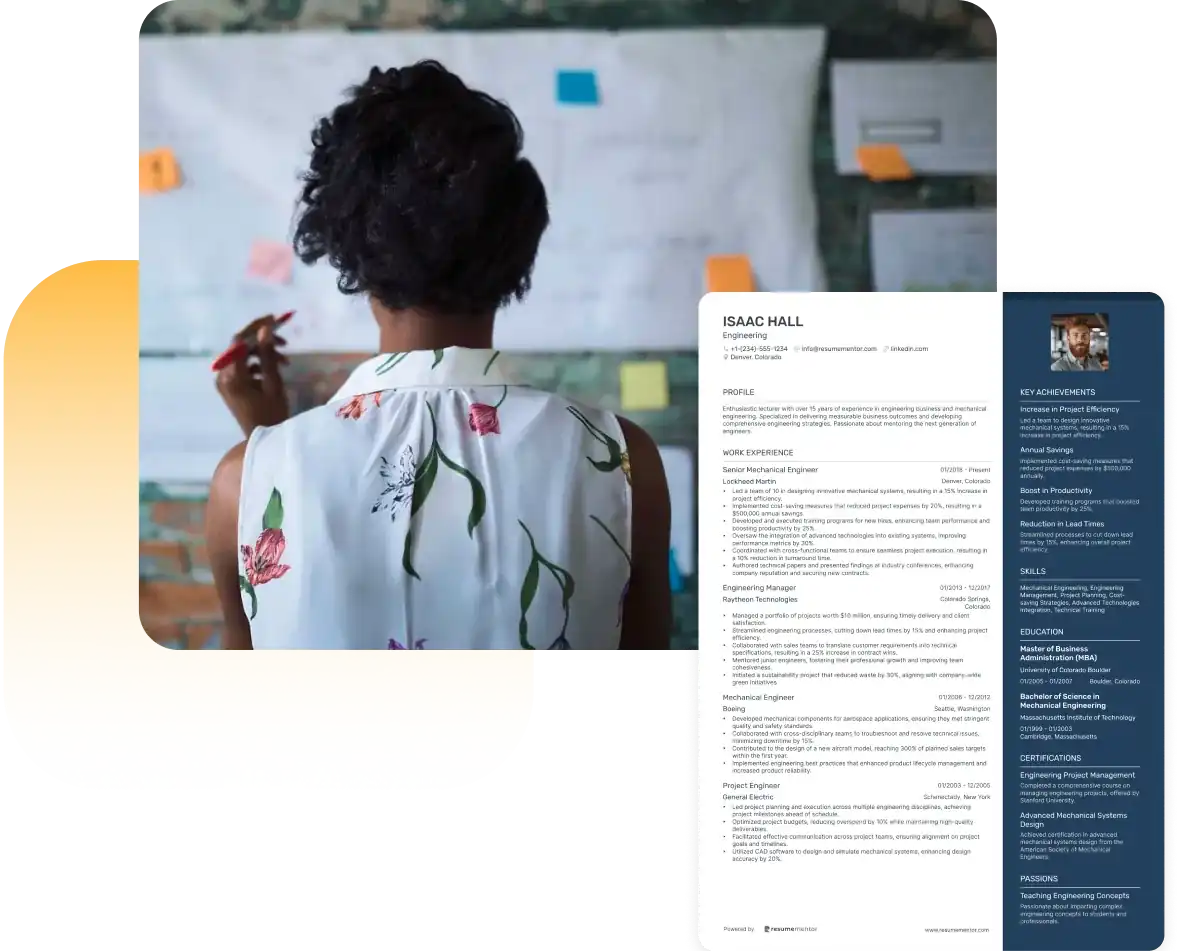
Continue Reading
Check more recommended readings to get the job of your dreams.
Resume
Resources
Tools
© 2025. All rights reserved.
Made with love by people who care.

